Paul van Yperen's Blog, page 29
December 23, 2024
Hugh Grant
With his bumbling English charm, Hugh Grant (1960) achieved international stardom in the romantic comedy Four Weddings and a Funeral (1994). The handsome Brit with his floppy hair and posh accent delivered more endearing comic performances in hits like Notting Hill (1999), Bridget Jones's Diary (2001) and About a Boy (2002). Privately, Grant also proved to have enough sense of humour to survive a media frenzy.
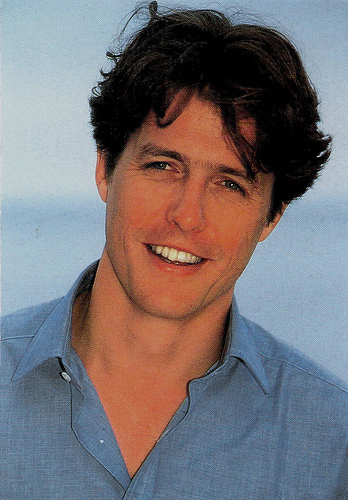
Italian postcard by World Collection, no. P.c. 688.
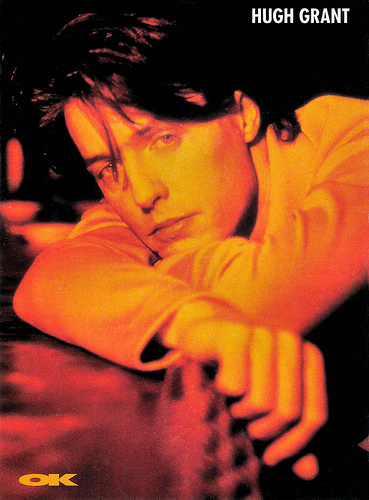
French postcard by OK Podium. Photo: J-M Graber.
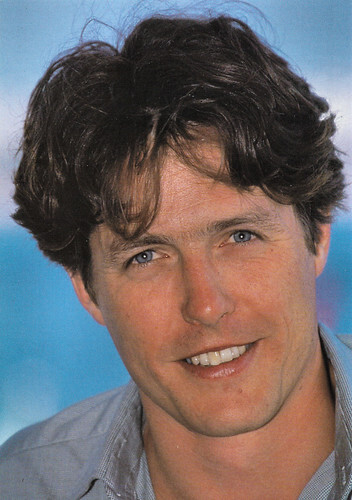
British postcard by Heroes Publishing LTD, London, no. SPC 2773.
A sexually conflicted Edwardian
Hugh John Mungo Grant was born in Hammersmith, London, in 1960. He was the second son of Fynvola Susan MacLean, a schoolteacher, and James Murray Grant, a carpet sales representative. His elder brother, James Grant, is a successful banker. From 1969 to 1978, Hugh attended the independent Latymer Upper School in Hammersmith on a scholarship and played 1st XV rugby, cricket and football for the school. In 1979, he won the Galsworthy scholarship to New College, Oxford where he starred in his first film, Privileged (Michael Hoffman, 1982), produced by the Oxford University Film Foundation.
Viewing acting as nothing more than a creative outlet, he joined the Oxford University Dramatic Society and starred in a successful touring production of 'Twelfth Night' by William Shakespeare . To obtain his Equity card, he joined the Nottingham Playhouse, a regional theatre. Bored with small acting parts, he created his own comedy revue called 'The Jockeys of Norfolk' with friends Chris Lang and Andy Taylor. The group toured London's pub comedy circuit and proved a hit at the Edinburgh Festival. Their sketch on the Nativity told as an Ealing comedy, gained them a spot on the BBC2 TV show Edinburgh Nights. During this time, Grant also appeared in theatre productions of plays such as 'An Inspector Calls', Oscar Wilde's 'Lady Windermere's Fan', and Shakespeare's 'Coriolanus'.
His first leading film role came as a sexually conflicted Edwardian in Maurice (James Ivory, 1987), adapted from E. M. Forster's novel. He and co-star James Wilby shared the Volpi Cup for best actor at the Venice Film Festival for their portrayals of lovers Clive Durham and Maurice Hall. Despite such acclaim, Grant's next films were largely forgettable affairs except for The Lair of the White Worm (Ken Russell, 1988). Grant attained some cult status as a lord attempting to foil the murderous charms of a campy, trampy vampire (Amanda Donahoe). He had supporting parts in the BAFTA Award-nominated White Mischief (Michael Radford, 1987) and in Dawning (Robert Knights, 1988), opposite Anthony Hopkins .
His classic good looks made him a natural for romantic leads. He played Lord Byron in the Spanish production Remando al viento/Rowing with the Wind (Gonzalo Suárez, 1988). During the shooting of this Goya Award-winning film, Grant met model and actress Elizabeth Hurley, who was cast in a supporting role as Byron's former lover Claire Clairmont. Their subsequent relationship created much media attention. He portrayed another real-life figure, Frédéric Chopin, in Impromptu (James Lapine, 1991) opposite Judy Davis as George Sand. He also played Julie Andrews ' gay son in the ABC made-for-television film Our Sons (John Erman, 1991).
In Roman Polanski's Bitter Moon (1992), he portrayed a fastidious and proper British tourist married to Kristin Scott Thomas, who finds himself enticed by the sexual hedonism of a seductive French woman (Emmanuelle Seigner) and her embittered, paraplegic American husband (Peter Coyote). His work in the award-winning Merchant-Ivory drama The Remains of the Day (James Ivory, 1993) went largely unnoticed.
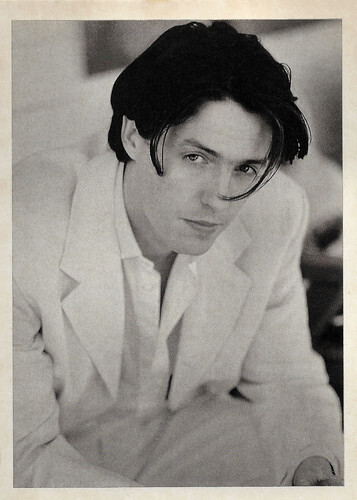
Canadian postcard by Canadian Postcard, no. A-255.
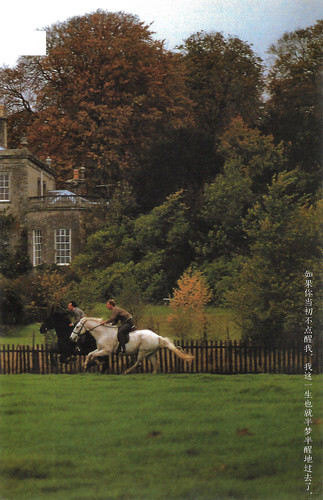
Chinese postcard. Hugh Grant and James Wilby in Maurice (James Ivory, 1987).
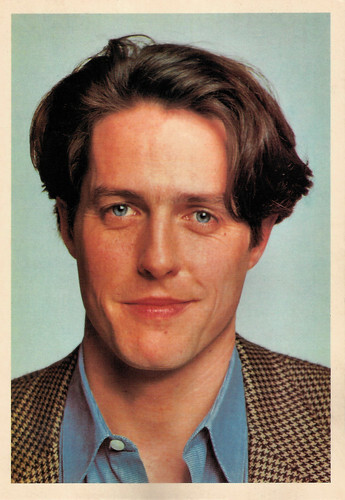
Spanish postcard in the Colección 'Estrellas de actualidad' by CACITEL, S.L., 1990, no. 101.
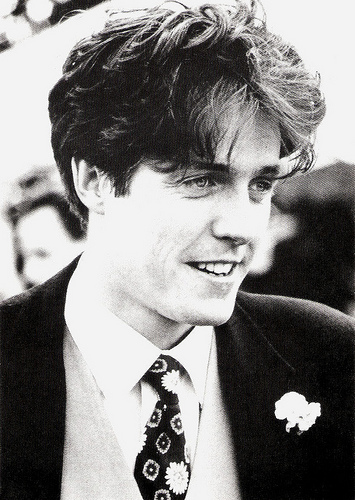
Danish postcard by Forlaget Holger Danske, no. 931.
A bohemian and debonair bachelor
At 32, Hugh Grant became an overnight international star when he played bohemian and debonair bachelor Charles in Four Weddings and a Funeral (Mike Newell 1994), opposite Andie MacDowell. The romantic comedy, written by Richard Curtis, became the highest-grossing British film to date with a worldwide box office over $244 million. Among the numerous awards for the film, Grant earned his first and only Golden Globe Award and a BAFTA Award. He signed a two-year production deal with Castle Rock Entertainment and became the founder and director of the UK-based Simian Films Limited. He appointed Elizabeth Hurley as the head of development to look for prospective projects. Simian Films produced two Grant vehicles in the 1990s but closed its US office in 2002.
Grant was one of the choices to play James Bond in GoldenEye (Martin Campbell, 1995), but he eventually lost out to Pierce Brosnan . He did play Emma Thompson's suitor in Sense and Sensibility (Ang Lee, 1995), the Academy Award-winning film version of Jane Austen's classic 1811 novel and Grant was a cartographer in 1917 Wales in The Englishman Who Went Up a Hill But Came Down a Mountain (Christopher Monger, 1995). He also performed in the Academy Award-winning Restoration (Michael Hoffman, 1995) with Robert Downey Jr. On 27 June 1995, Grant was arrested in Los Angeles, California, for lewd conduct after police checking into a ‘suspicious parked car’ found him with Divine Brown, a prostitute, in the front seat. He pleaded no contest and was fined $1,180, and placed on two years' summary probation.
The arrest occurred about two weeks before the release of Grant's first major studio film, Nine Months (Chris Columbus, 1995), which he was scheduled to promote on several American television shows. The Tonight Show with Jay Leno had him booked for the same week. In the much-watched interview, Grant was noted for not making excuses for the incident after Leno asked him, "What the hell were you thinking?" Grant answered, "I think you know in life what's a good thing to do and what's a bad thing, and I did a bad thing. And there you have it." The comedy Nine Months was almost universally panned by critics, but it proved a hit at the box office. Grant made his debut as a film producer with the thriller Extreme Measures (Michael Apted, 1996), a commercial and critical failure.
After a three-year hiatus, he paired with Julia Roberts in Notting Hill (Roger Michell, 1999), made by much of the same team that was responsible for Four Weddings and a Funeral. This new Working Title production displaced Four Weddings and a Funeral as the biggest British hit in the history of cinema, with earnings equalling $363 million worldwide. The comedy helped to restore some of Grant’s lustre.
He also released his second production output, a fish-out-of-water mob comedy Mickey Blue Eyes (Kelly Makin, 1999), that year. More successful was Small Time Crooks (Woody Allen, 2000) in which Grant played an unsympathetic art dealer. After 13 years together, Grant and Elizabeth Hurley split up in May 2000, but two years later Grant became godfather to Hurley's son Damian (2002).
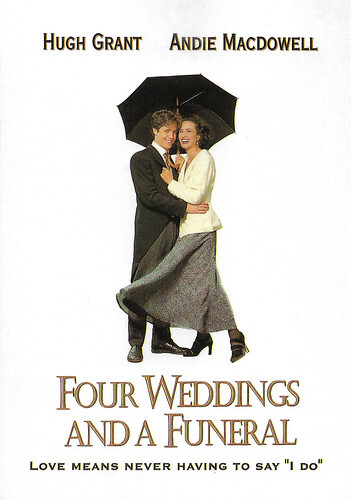
Spanish postcard by Clasicos Cinema, no. 166. Hugh Grant and Andie McDowell in Four Weddings and a Funeral (Mike Newell, 1994). Caption: Love means never having to say "I do".
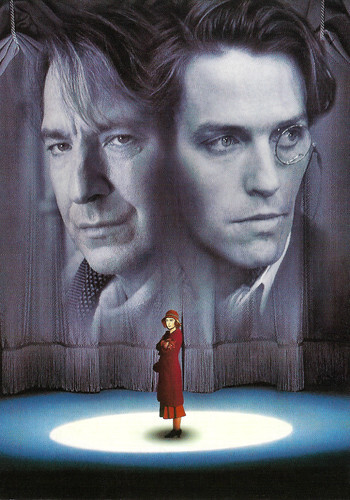
British Freecard by London Card Guide LTD, London. Alan Rickman and Hugh Grant in An Awfully Big Adventure (Mike Newell, 1995).

Italian postcard by Citrus Promotion, no. 0423. Photo: Universal / Working Title. Julia Roberts and Hugh Grant in Notting Hill (Richard Curtis, 1999).

Italian postcard by Citrus Promotion, no. 0426. Photo: Universal / Working Title. Julia Roberts and Hugh Grant in Notting Hill (Richard Curtis, 1999).
The bugger bugged
Hugh Grant played a charming but womanising book publisher in Bridget Jones's Diary (Sharon Maguire, 2001). The film, featuring Renée Zellweger and adapted from Helen Fielding's novel, was an international hit, earning $281 million worldwide. Grant also appeared as another womaniser, Will Freeman, in About a Boy (Paul Weitz, 2002), the film adaptation of Nick Hornby's best-seller At AllMovie , Michael Hastings notes: "Hugh Grant is one of the few actors since Cary Grant who can remain likeable even as he's committing near-despicable acts of dishonesty." The film earned Grant his third Golden Globe nomination, while the London Film Critics Circle named Grant its Best British Actor. About a Boy also marked a notable change in Grant's boyish look. Now 41, he had lost weight and also abandoned his trademark floppy hair. Grant was paired with Sandra Bullock in Warner Bros.'s Two Weeks Notice (Marc Lawrence, 2002), which made $199 million internationally but was panned by critics.
It was followed by the ensemble comedy, Love Actually (Richard Curtis, 2003), headlined by Grant as the British Prime Minister. A Christmas release by Working Title Films, the film was promoted as ‘the ultimate romantic comedy’ and accumulated $246 million at the international box office. In 2004, Grant reprised his role as Daniel Cleaver for a small part in Bridget Jones: The Edge of Reason (Beebon Kidron, 2004), which, like its predecessor, made more than $262 million commercially. Gone from the screen for two years, Grant then reteamed with Paul Weitz for the black comedy American Dreamz (2006), in which he portrayed the acerbic host of an American Idol-like reality show. American Dreamz failed financially but Grant’s self-loathing performance was generously praised. In 2007, Grant starred opposite Drew Barrymore in Music and Lyrics (Marc Lawrence, 2007), a parody of pop culture and the music industry. Grant learned to sing, play the piano, dance (a few mannered steps) and studied the mannerisms of prominent musicians to prepare for his role as a has-been pop singer, based loosely on Andrew Ridgeley.
He co-starred with Sarah Jessica Parker in the romantic comedy Did You Hear About the Morgans? (Marc Lawrence, 2009), which was a commercial as well as a critical failure. In April 2011, he published an article in the New Statesman ‘The Bugger, Bugged’ about a conversation with Paul McMullan, former journalist and paparazzo for News of the World . In unguarded comments which were secretly taped by Grant, McMullan alleged that editors at the Daily Mail and News of the World had ordered journalists to engage in illegal phone tapping and had done so with the full knowledge of senior British politicians. Wikipedia describes how “Grant's article attracted considerable interest, due to both the revelatory content of the taped conversation, and the novelty of Grant himself ‘turning the tables’ on a tabloid journalist”. The later revelation that the voicemail of the by then murdered Millie Dowler had been hacked, and evidence for her murder enquiry had been deleted, turned the coverage from media interest to widespread public and eventually political outrage. "Grant became something of a spokesman against Murdoch's News Corporation, culminating in a bravura performance on BBC television's Question Time in July 2011".
In November 2011, it was announced that Grant had become a father to a baby girl, Tabitha, earlier that autumn. The identity of the mother, with whom Grant had a 'fleeting affair' according to his publicist, was not at first announced; however, it was later revealed to be a Chinese woman, Tinglan Hong. In an interview on The Ellen DeGeneres Show in April 2012, Grant revealed that his daughter's Chinese name is Xiao Xi, meaning ‘happy surprise’. Grant and Hong reportedly briefly reunited in 2012. In February 2013, Hugh Grant announced that they had recently welcomed a son named Felix Chang. In the cinema, Hugh Grant played six evil characters in the epic drama film Cloud Atlas (Tom Tykwer, Andy Wachowski, Lana Wachowski, 2012). Then he appeared in another romantic comedy, The Rewrite (Marc Lawrence, 2014) with Marisa Tomei, and in the action comedy The Man from U.N.C.L.E. (Guy Ritchie, 2015), based on the legendary TV series. In 2016, he played the husband of the title character in the film Florence Foster Jenkins (Stephen Frears, 2016) starring Meryl Streep . His performance drew raves from film critics. Roger Ebert: "(Frears) coaxed Hugh Grant out of semi-retirement to play Jenkins’ devoted common-law husband St. Clair Bayfield. It’s a good thing he did, too, since Grant gives one of his finest performances ever." He was nominated for his first individual Screen Actors Guild Award and also earned nominations for a BAFTA, a Golden Globe, a Critics' Choice Award, a Satellite Award and a European Film Award.
Hugh Grant's next appearance was as Phoenix Buchanan, a villain in the live-action animated comedy Paddington 2 (Paul King, 2017) which was a commercial and critical success. In 2018, Grant returned to television after 25 years, as Jeremy Thorpe in the BBC miniseries A Very English Scandal, which marked his second collaboration with director Stephen Frears. The miniseries, and in particular Grant, were widely and highly praised. Also praised was another against-type role as a seedy and unscrupulous private investigator in The Gentlemen (Guy Ritchie, 2019), his second collaboration with the director following The Man From U.N.C.L.E. In 2023, Grant reunited with Ritchie for the action Operation Fortune: Ruse de Guerre (Guy Ritchie, 2023 alongside Jason Statham and Aubrey Plaza. Also in 2023, Grant appeared as an Oompa-Loompa in Wonka (Paul King, 2023), a film which serves as a prequel to the Roald Dahl novel 'Charlie and the Chocolate Factory', exploring Willy Wonka's origins. Grant is set to star in the upcoming Horror film Heretic (Scott Beck, Bryan Woods, 2024) and will reprise his role as Daniel Cleaver in the romantic comedy Bridget Jones: Mad About the Boy (Michael Morris, 2025).
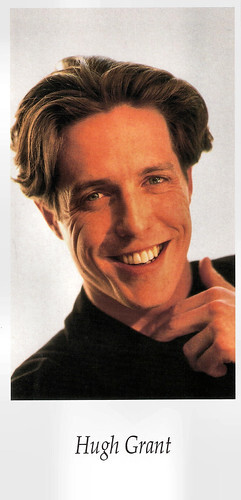
Belgian postcard by MultiChoice Kaleidoscope. Photo: Isopress / Outline (Heisler).
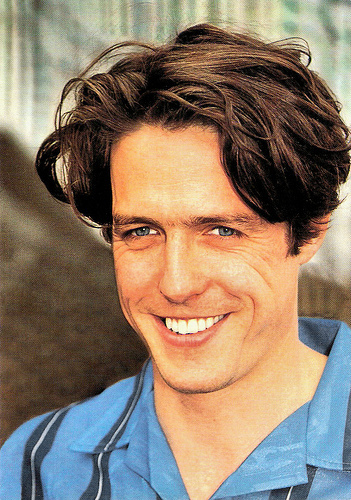
Italian postcard by World Collection, no. 541.
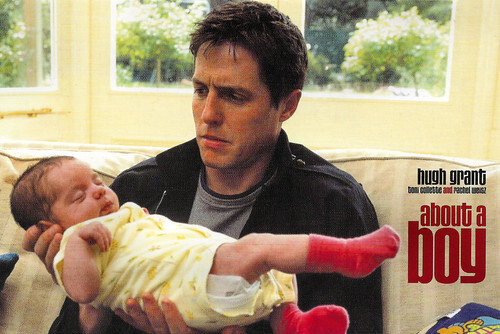
Australian Freecard by AvantCard, no. 6848. Hugh Grant in About a Boy (Paul Weitz, 2002).
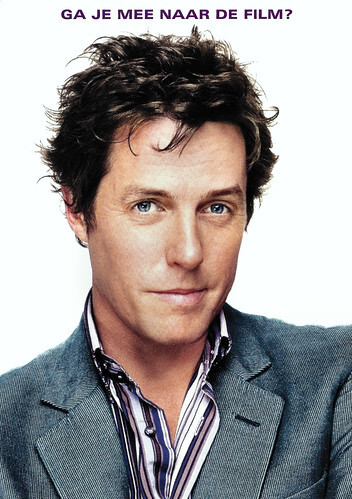
Dutch postcard by Boomerang Freecards, Amsterdam, no. P23-04. Hugh Grant in Bridget Jones - The Edge of Reason (Beebon Kidron, 2004). Caption: Will you join us for the film?
Sources: Roger Ebert (RogerEbert.com), Rebecca Flint Marx (AllMovie - page now defunct), (IMDb), Michael Hastings (AllMovie - page now defunct), FilmReference.com, Wikipedia, and .

Italian postcard by World Collection, no. P.c. 688.

French postcard by OK Podium. Photo: J-M Graber.

British postcard by Heroes Publishing LTD, London, no. SPC 2773.
A sexually conflicted Edwardian
Hugh John Mungo Grant was born in Hammersmith, London, in 1960. He was the second son of Fynvola Susan MacLean, a schoolteacher, and James Murray Grant, a carpet sales representative. His elder brother, James Grant, is a successful banker. From 1969 to 1978, Hugh attended the independent Latymer Upper School in Hammersmith on a scholarship and played 1st XV rugby, cricket and football for the school. In 1979, he won the Galsworthy scholarship to New College, Oxford where he starred in his first film, Privileged (Michael Hoffman, 1982), produced by the Oxford University Film Foundation.
Viewing acting as nothing more than a creative outlet, he joined the Oxford University Dramatic Society and starred in a successful touring production of 'Twelfth Night' by William Shakespeare . To obtain his Equity card, he joined the Nottingham Playhouse, a regional theatre. Bored with small acting parts, he created his own comedy revue called 'The Jockeys of Norfolk' with friends Chris Lang and Andy Taylor. The group toured London's pub comedy circuit and proved a hit at the Edinburgh Festival. Their sketch on the Nativity told as an Ealing comedy, gained them a spot on the BBC2 TV show Edinburgh Nights. During this time, Grant also appeared in theatre productions of plays such as 'An Inspector Calls', Oscar Wilde's 'Lady Windermere's Fan', and Shakespeare's 'Coriolanus'.
His first leading film role came as a sexually conflicted Edwardian in Maurice (James Ivory, 1987), adapted from E. M. Forster's novel. He and co-star James Wilby shared the Volpi Cup for best actor at the Venice Film Festival for their portrayals of lovers Clive Durham and Maurice Hall. Despite such acclaim, Grant's next films were largely forgettable affairs except for The Lair of the White Worm (Ken Russell, 1988). Grant attained some cult status as a lord attempting to foil the murderous charms of a campy, trampy vampire (Amanda Donahoe). He had supporting parts in the BAFTA Award-nominated White Mischief (Michael Radford, 1987) and in Dawning (Robert Knights, 1988), opposite Anthony Hopkins .
His classic good looks made him a natural for romantic leads. He played Lord Byron in the Spanish production Remando al viento/Rowing with the Wind (Gonzalo Suárez, 1988). During the shooting of this Goya Award-winning film, Grant met model and actress Elizabeth Hurley, who was cast in a supporting role as Byron's former lover Claire Clairmont. Their subsequent relationship created much media attention. He portrayed another real-life figure, Frédéric Chopin, in Impromptu (James Lapine, 1991) opposite Judy Davis as George Sand. He also played Julie Andrews ' gay son in the ABC made-for-television film Our Sons (John Erman, 1991).
In Roman Polanski's Bitter Moon (1992), he portrayed a fastidious and proper British tourist married to Kristin Scott Thomas, who finds himself enticed by the sexual hedonism of a seductive French woman (Emmanuelle Seigner) and her embittered, paraplegic American husband (Peter Coyote). His work in the award-winning Merchant-Ivory drama The Remains of the Day (James Ivory, 1993) went largely unnoticed.

Canadian postcard by Canadian Postcard, no. A-255.

Chinese postcard. Hugh Grant and James Wilby in Maurice (James Ivory, 1987).

Spanish postcard in the Colección 'Estrellas de actualidad' by CACITEL, S.L., 1990, no. 101.

Danish postcard by Forlaget Holger Danske, no. 931.
A bohemian and debonair bachelor
At 32, Hugh Grant became an overnight international star when he played bohemian and debonair bachelor Charles in Four Weddings and a Funeral (Mike Newell 1994), opposite Andie MacDowell. The romantic comedy, written by Richard Curtis, became the highest-grossing British film to date with a worldwide box office over $244 million. Among the numerous awards for the film, Grant earned his first and only Golden Globe Award and a BAFTA Award. He signed a two-year production deal with Castle Rock Entertainment and became the founder and director of the UK-based Simian Films Limited. He appointed Elizabeth Hurley as the head of development to look for prospective projects. Simian Films produced two Grant vehicles in the 1990s but closed its US office in 2002.
Grant was one of the choices to play James Bond in GoldenEye (Martin Campbell, 1995), but he eventually lost out to Pierce Brosnan . He did play Emma Thompson's suitor in Sense and Sensibility (Ang Lee, 1995), the Academy Award-winning film version of Jane Austen's classic 1811 novel and Grant was a cartographer in 1917 Wales in The Englishman Who Went Up a Hill But Came Down a Mountain (Christopher Monger, 1995). He also performed in the Academy Award-winning Restoration (Michael Hoffman, 1995) with Robert Downey Jr. On 27 June 1995, Grant was arrested in Los Angeles, California, for lewd conduct after police checking into a ‘suspicious parked car’ found him with Divine Brown, a prostitute, in the front seat. He pleaded no contest and was fined $1,180, and placed on two years' summary probation.
The arrest occurred about two weeks before the release of Grant's first major studio film, Nine Months (Chris Columbus, 1995), which he was scheduled to promote on several American television shows. The Tonight Show with Jay Leno had him booked for the same week. In the much-watched interview, Grant was noted for not making excuses for the incident after Leno asked him, "What the hell were you thinking?" Grant answered, "I think you know in life what's a good thing to do and what's a bad thing, and I did a bad thing. And there you have it." The comedy Nine Months was almost universally panned by critics, but it proved a hit at the box office. Grant made his debut as a film producer with the thriller Extreme Measures (Michael Apted, 1996), a commercial and critical failure.
After a three-year hiatus, he paired with Julia Roberts in Notting Hill (Roger Michell, 1999), made by much of the same team that was responsible for Four Weddings and a Funeral. This new Working Title production displaced Four Weddings and a Funeral as the biggest British hit in the history of cinema, with earnings equalling $363 million worldwide. The comedy helped to restore some of Grant’s lustre.
He also released his second production output, a fish-out-of-water mob comedy Mickey Blue Eyes (Kelly Makin, 1999), that year. More successful was Small Time Crooks (Woody Allen, 2000) in which Grant played an unsympathetic art dealer. After 13 years together, Grant and Elizabeth Hurley split up in May 2000, but two years later Grant became godfather to Hurley's son Damian (2002).

Spanish postcard by Clasicos Cinema, no. 166. Hugh Grant and Andie McDowell in Four Weddings and a Funeral (Mike Newell, 1994). Caption: Love means never having to say "I do".

British Freecard by London Card Guide LTD, London. Alan Rickman and Hugh Grant in An Awfully Big Adventure (Mike Newell, 1995).

Italian postcard by Citrus Promotion, no. 0423. Photo: Universal / Working Title. Julia Roberts and Hugh Grant in Notting Hill (Richard Curtis, 1999).

Italian postcard by Citrus Promotion, no. 0426. Photo: Universal / Working Title. Julia Roberts and Hugh Grant in Notting Hill (Richard Curtis, 1999).
The bugger bugged
Hugh Grant played a charming but womanising book publisher in Bridget Jones's Diary (Sharon Maguire, 2001). The film, featuring Renée Zellweger and adapted from Helen Fielding's novel, was an international hit, earning $281 million worldwide. Grant also appeared as another womaniser, Will Freeman, in About a Boy (Paul Weitz, 2002), the film adaptation of Nick Hornby's best-seller At AllMovie , Michael Hastings notes: "Hugh Grant is one of the few actors since Cary Grant who can remain likeable even as he's committing near-despicable acts of dishonesty." The film earned Grant his third Golden Globe nomination, while the London Film Critics Circle named Grant its Best British Actor. About a Boy also marked a notable change in Grant's boyish look. Now 41, he had lost weight and also abandoned his trademark floppy hair. Grant was paired with Sandra Bullock in Warner Bros.'s Two Weeks Notice (Marc Lawrence, 2002), which made $199 million internationally but was panned by critics.
It was followed by the ensemble comedy, Love Actually (Richard Curtis, 2003), headlined by Grant as the British Prime Minister. A Christmas release by Working Title Films, the film was promoted as ‘the ultimate romantic comedy’ and accumulated $246 million at the international box office. In 2004, Grant reprised his role as Daniel Cleaver for a small part in Bridget Jones: The Edge of Reason (Beebon Kidron, 2004), which, like its predecessor, made more than $262 million commercially. Gone from the screen for two years, Grant then reteamed with Paul Weitz for the black comedy American Dreamz (2006), in which he portrayed the acerbic host of an American Idol-like reality show. American Dreamz failed financially but Grant’s self-loathing performance was generously praised. In 2007, Grant starred opposite Drew Barrymore in Music and Lyrics (Marc Lawrence, 2007), a parody of pop culture and the music industry. Grant learned to sing, play the piano, dance (a few mannered steps) and studied the mannerisms of prominent musicians to prepare for his role as a has-been pop singer, based loosely on Andrew Ridgeley.
He co-starred with Sarah Jessica Parker in the romantic comedy Did You Hear About the Morgans? (Marc Lawrence, 2009), which was a commercial as well as a critical failure. In April 2011, he published an article in the New Statesman ‘The Bugger, Bugged’ about a conversation with Paul McMullan, former journalist and paparazzo for News of the World . In unguarded comments which were secretly taped by Grant, McMullan alleged that editors at the Daily Mail and News of the World had ordered journalists to engage in illegal phone tapping and had done so with the full knowledge of senior British politicians. Wikipedia describes how “Grant's article attracted considerable interest, due to both the revelatory content of the taped conversation, and the novelty of Grant himself ‘turning the tables’ on a tabloid journalist”. The later revelation that the voicemail of the by then murdered Millie Dowler had been hacked, and evidence for her murder enquiry had been deleted, turned the coverage from media interest to widespread public and eventually political outrage. "Grant became something of a spokesman against Murdoch's News Corporation, culminating in a bravura performance on BBC television's Question Time in July 2011".
In November 2011, it was announced that Grant had become a father to a baby girl, Tabitha, earlier that autumn. The identity of the mother, with whom Grant had a 'fleeting affair' according to his publicist, was not at first announced; however, it was later revealed to be a Chinese woman, Tinglan Hong. In an interview on The Ellen DeGeneres Show in April 2012, Grant revealed that his daughter's Chinese name is Xiao Xi, meaning ‘happy surprise’. Grant and Hong reportedly briefly reunited in 2012. In February 2013, Hugh Grant announced that they had recently welcomed a son named Felix Chang. In the cinema, Hugh Grant played six evil characters in the epic drama film Cloud Atlas (Tom Tykwer, Andy Wachowski, Lana Wachowski, 2012). Then he appeared in another romantic comedy, The Rewrite (Marc Lawrence, 2014) with Marisa Tomei, and in the action comedy The Man from U.N.C.L.E. (Guy Ritchie, 2015), based on the legendary TV series. In 2016, he played the husband of the title character in the film Florence Foster Jenkins (Stephen Frears, 2016) starring Meryl Streep . His performance drew raves from film critics. Roger Ebert: "(Frears) coaxed Hugh Grant out of semi-retirement to play Jenkins’ devoted common-law husband St. Clair Bayfield. It’s a good thing he did, too, since Grant gives one of his finest performances ever." He was nominated for his first individual Screen Actors Guild Award and also earned nominations for a BAFTA, a Golden Globe, a Critics' Choice Award, a Satellite Award and a European Film Award.
Hugh Grant's next appearance was as Phoenix Buchanan, a villain in the live-action animated comedy Paddington 2 (Paul King, 2017) which was a commercial and critical success. In 2018, Grant returned to television after 25 years, as Jeremy Thorpe in the BBC miniseries A Very English Scandal, which marked his second collaboration with director Stephen Frears. The miniseries, and in particular Grant, were widely and highly praised. Also praised was another against-type role as a seedy and unscrupulous private investigator in The Gentlemen (Guy Ritchie, 2019), his second collaboration with the director following The Man From U.N.C.L.E. In 2023, Grant reunited with Ritchie for the action Operation Fortune: Ruse de Guerre (Guy Ritchie, 2023 alongside Jason Statham and Aubrey Plaza. Also in 2023, Grant appeared as an Oompa-Loompa in Wonka (Paul King, 2023), a film which serves as a prequel to the Roald Dahl novel 'Charlie and the Chocolate Factory', exploring Willy Wonka's origins. Grant is set to star in the upcoming Horror film Heretic (Scott Beck, Bryan Woods, 2024) and will reprise his role as Daniel Cleaver in the romantic comedy Bridget Jones: Mad About the Boy (Michael Morris, 2025).

Belgian postcard by MultiChoice Kaleidoscope. Photo: Isopress / Outline (Heisler).

Italian postcard by World Collection, no. 541.

Australian Freecard by AvantCard, no. 6848. Hugh Grant in About a Boy (Paul Weitz, 2002).

Dutch postcard by Boomerang Freecards, Amsterdam, no. P23-04. Hugh Grant in Bridget Jones - The Edge of Reason (Beebon Kidron, 2004). Caption: Will you join us for the film?
Sources: Roger Ebert (RogerEbert.com), Rebecca Flint Marx (AllMovie - page now defunct), (IMDb), Michael Hastings (AllMovie - page now defunct), FilmReference.com, Wikipedia, and .
Published on December 23, 2024 22:00
December 22, 2024
Bond Girls of the 20th Century
'A Bond girl is a character who is a love interest, female companion or occasionally an adversary of James Bond in a novel, film, or video game', defines Wikipedia. Bond girls occasionally have names that are double entendres or sexual puns - Plenty O'Toole, Holly Goodhead, or Xenia Onatopp. The female leads in the films, such as Ursula Andress, Honor Blackman, or Maud Adams, can also be referred to as 'Bond girls'. The term is an anachronism now. The female stars in more recent Bond films deserve the name Bond Woman. This postcard series salutes 19 Bond Girls of the 20th Century.
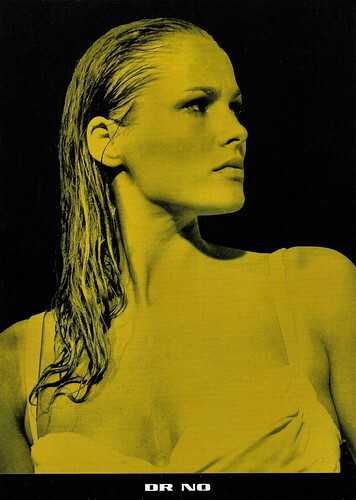
Vintage card in the Bond Girls series. Ursula Andress in Dr. No (Terence Young, 1962).
Stunning Swiss sex symbol, starlet, and jet-setter Ursula Andress (1936) will always be remembered as the first and quintessential Bond girl. In Dr No (1962), she made film history when she spectacularly rose out of the Caribbean Sea in a white bikini. Though she won a Golden Globe Ursula's looks generally outweighed her acting talent and she never took her film career very seriously.
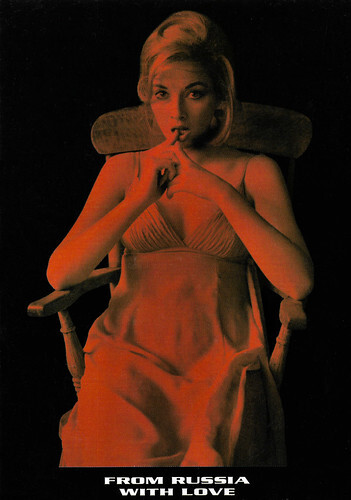
Vintage postcard in the Bond Girls Series. Daniela Bianchi in From Russia With Love (Terence Young, 1963).
Beautiful Daniela Bianchi (1942) is an Italian actress, whose best-known part was the luscious Soviet cipher clerk Tatiana Romanova in the James Bond film From Russia with Love (1963). She played in several more Eurospy films during the 1960s.
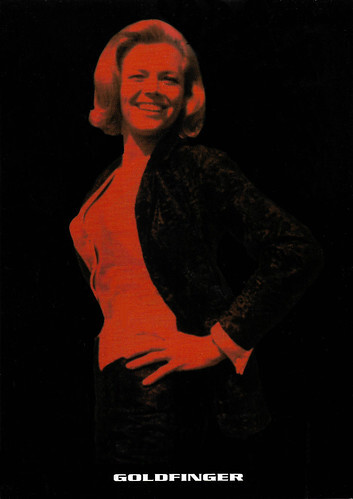
Vintage card in the Bond Girls series. Honor Blackman in Goldfinger (Guy Hamilton, 1964).
British actress Honor Blackman (1925-2020) was best known for playing the Bond girl Pussy Galore opposite Sean Connery in Goldfinger (1964). Blackman became a household name in the 1960s as Cathy Gale in the TV series The Avengers in which she showed an extraordinary combination of beauty, brains and physical prowess. Her career spanned eight decades.
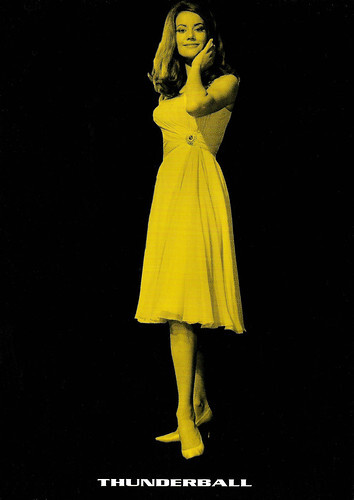
Vintage postcard in the Bond Girls Series. Claudine Auger in Thunderball (Terence Young, 1965).
French actress Claudine Auger (1941-2019) was best known as Bond Girl Domino in the James Bond film Thunderball (1965). At 17, she was Miss France 1958 and she became the first runner-up in the Miss World contest. Later she worked mostly in France and Italy.
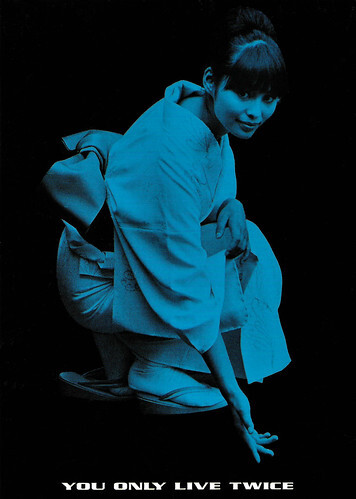
Vintage card in the Bond Girls series. Akiko Wakabayashi in You Only Live Twice (Lewis Gilbert, 1967).
Akiko Wakabayashi (1939) is a retired Japanese actress. She is best known for her role as Bond girl Aki in the James Bond film You Only Live Twice (1967) with Sean Connery.
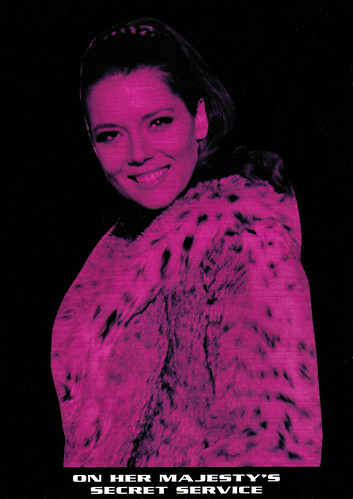
Vintage postcard in the Bond Girls Series. Diana Rigg in On Her Majesty's Secret Service (Peter R. Hunt, 1969).
English actress Diana Rigg (1938-2020) was well-known as Emma Peel in the classic TV series The Avengers (1965-1968) and as Lady Olenna Tyrell in Game of Thrones (2013-2017). In between she had an extensive career in film and theatre. Between 1959 and 1964, she performed for the Royal Shakespeare Company and won several awards, including a Tony and an Emmy award. In the cinema, she made her mark as Countess Teresa di Vicenzo, the only Bond girl to ever get 007 to the altar, in On Her Majesty's Secret Service (1969).
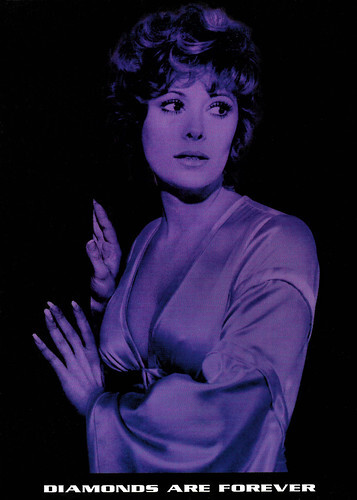
Vintage postcard in the Bond Girls Series. Jill St. John in Diamonds Are Forever (Guy Hamilton, 1971).
Voluptuous, red-haired American actress Jill St. John (1940) played countless bikini sexpot roles in Hollywood films of the 1960s. She was at her best as the tantalizing Bond girl Tiffany Case in Diamonds Are Forever (1971).
Bond Girls Are Forever
Nearly all of Ian Fleming's James Bond novels and short stories include one or more female characters who can be said to qualify as Bond girls. Fleming's Bond girls have some individual traits but they also have much in common. The typical Bond girl is in her early to mid-twenties, roughly ten years younger than Bond, who seems to be perennially in his mid-thirties. Bond girls possess splendid figures and tend to dress in a slightly masculine, assertive fashion, wearing little jewellery and square-toed leather shoes. They generally use little or no makeup and no nail polish, and also wear their nails short. Their hair may be any colour, though they typically wear it in a natural or casual cut that falls heavily to their shoulders. Their features, especially their eyes and mouths, are often widely spaced. The first description of a Bond girl, 'Casino Royale''s Vesper Lynd, is almost a template for the typical dress as well as the general appearance of later Bond girls; she sports nearly all of the features discussed above.
Another characteristic of Bond girls is their pattern of sexually suggestive names, such as Pussy Galore. Names with less obvious meanings are sometimes explained in the novels. While Solitaire's real name is Simone Latrelle, she is known as Solitaire because she excludes men from her life. Tiffany Case received her name from her father, who was so angry that she was not a boy that he gave her mother a thousand dollars and a compact from Tiffany's and then walked out on her. Fleming's penchant for double-entendre names began with the first Bond novel 'Casino Royale'. The name of the Bond girl in that novel, 'Vesper Lynd', was intended to be a pun on 'West Berlin', signifying Vesper's divided loyalties as a double agent under Soviet control. Several Bond girls, however, have normal names.
Most Bond girls are sexually experienced by the time they meet Bond. Quite often those previous experiences have not been positive, and many Bond girls have had sexual violence inflicted on them in the past, causing them to feel alienated from all men — until Bond comes along. Tiffany Case was gang-raped as a teenager. Honey Ryder was beaten and raped as a teenager by a drunken acquaintance. Pussy Galore was sexually abused at age 12 by her uncle. Kissy Suzuki reports to Bond that during her brief career in Hollywood when she was 17, "They thought that because I am Japanese I am some sort of an animal and that my body is for everyone." The implication is often that these violent episodes have turned these Bond girls against men, though upon encountering Bond they overcome their earlier antipathy and sleep with him not only willingly but eagerly. This trope reaches an extreme level in 'Goldfinger', where Pussy Galore is portrayed as a lesbian when she first meets Bond, but at the end of the novel she sleeps with him. When, in bed, he says to her, "They told me you only liked women," she replies, "I never met a man before."
In Fleming's novels, many Bond girls have some sort of independent job or career, often one that was considered inappropriate for women in the 1950s. Vesper Lynd, Tatiana Romanova, Mary Ann Russell, and Mary Goodnight are in intelligence or law-enforcement work. Those who are criminals, such as Case and Galore, tend to be similarly independent-minded in how they approach their work — the latter even running her own syndicate. Even those Bond girls who have more conventional or glamorous jobs show themselves to be invested in having an independent outlook on life. While the Bond girls are clearly intended as sex objects, they are nevertheless portrayed in the novels as having a high degree of independence. This is also frequently (but not always) the case in the films. In 'On Her Majesty's Secret Service', Bond enters into a relationship and an eventual marriage with Teresa 'Tracy' di Vicenzo.
Ursula Andress as Honey Ryder in Dr No (Terence Young, 1962) is widely regarded as the first Bond girl, although she was preceded by both Eunice Gayson as Sylvia Trench and Zena Marshall as Miss Taro in the same film. In Dr No, Sylvia Trench was also introduced as Bond girl. The idea was that James Bond would meet her in each film and marry her in the sixth and final film. This idea was abandoned after the second film. The third Bond film, Goldfinger (Guy Hamilton, 1964), established the Bond girl as regularly appearing in Bond films. There is no set rule on what kind of person a Bond girl will be or what role she will play. She may be an ally or an enemy of Bond, pivotal to the mission or simply there for her looks. There are female characters such as Judi Dench's M, who are not romantic interests of Bond, and hence may not be considered Bond girls. It is never explained why Bond's love interest in one film is gone by the next and is never mentioned or even alluded to again. This is not always the case in the novels, which do sometimes make references to the Bond girls who have appeared in previous books. For example, Tiffany Case and Honey Ryder are revealed to have married other men. In 2002, former Bond girl Maryam d'Abo co-wrote the book 'Bond Girls Are Forever: The Women of James Bond'. This book later became a DVD-exclusive documentary featuring d'Abo and other Bond girls, including Ursula Andress . In 2015, Monica Bellucci in Spectre (Sam Mendes, 2015) became the oldest Bond girl at the age of 50. She stated that she does not consider herself to be a 'Bond girl', but a 'Bond woman'.
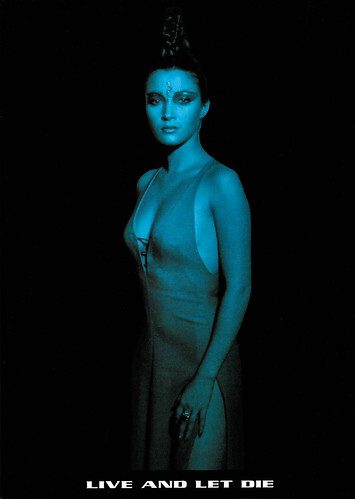
Vintage postcard in the Bond Girls Series. Jane Seymour in Live and Let Die (Guy Hamilton, 1973).
British-American actress Jane Seymour (1951) is known as Dr Michaela Quinn in the long-running TV series Dr Quinn, Medicine Woman (1993-1998). She also was Bond Girl Solitaire in Live and Let Die (1973) and became 'the Queen of the Miniseries' in the 1980s and 1990s.
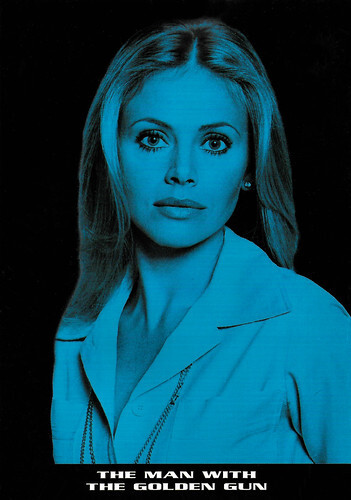
Vintage postcard in the Bond Girls series. Britt Ekland in The Man With the Golden Gun (Guy Hamilton, 1974).
Swedish actress Britt Ekland (1942) became famous through her marriage to Peter Sellers and her relationship with singer Rod Stewart. She was also known for her roles in such films as The Night They Raided Minsky's Get Carter, and The Man with the Golden Gun.
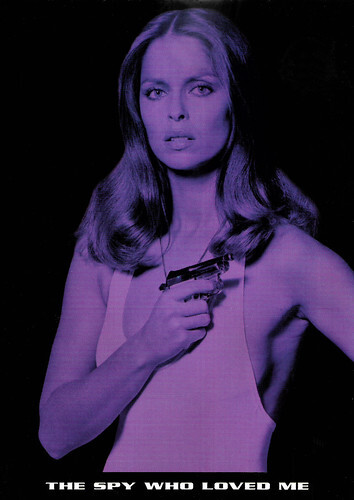
Vintage card in the Bond Girls series. Barbara Bach in The Spy Who Loved Me (Lewis Gilbert, 1977).
Barbara Bach (1947) is an American actress and former top model. She is best known as Bond girl Anya Amasova in the James Bond film The Spy Who Loved Me (1977), in which she played opposite Roger Moore. She is also known as the wife of ex-Beatle Ringo Starr. Bach has 28 films to her credit.
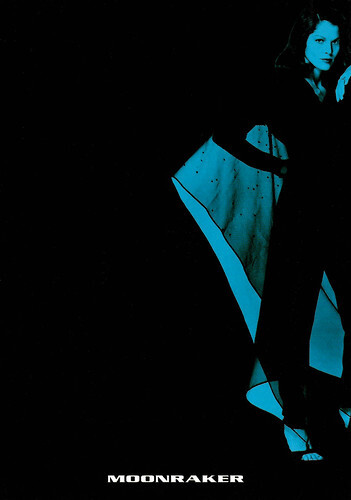
Vintage postcard in the Bond Girls series. Lois Chiles in Moonraker (Lewis Gilbert, 1979).
American actress and former model Lois Chiles (1947) is best known for her role as Bond Girl Dr Holly Goodhead in the James Bond film Moonraker (1979). Before entering films, she was one of the very top models of the 1970s. Her other screen credits include The Way We Were (1973), The Great Gatsby (1974), Death on the Nile (1978), and Broadcast News (1987).
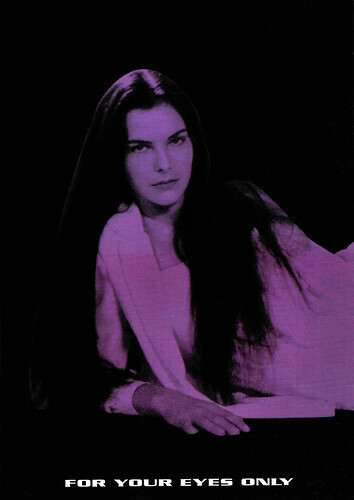
Vintage postcard in the Bond Girls series. Carole Bouquet in For Your Eyes Only (John Glen, 1981).
Carole Bouquet (1957) is a French actress and fashion model. She is best known for her role as Bond Girl Melina Havelock in the 12th James Bond film, For Your Eyes Only (1981). In the following years, she became the face of the French fashion house Chanel. She also starred in Cet obscur objet du désir/That Obscure Object of Desire (1977), and Trop belle pour toi/Too Beautiful for You (1990), for which she won a César Award.
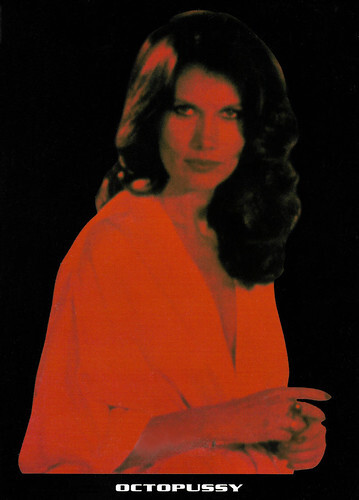
Vintage postcard in the Bond Girls series. Maud Adams in Octopussy (John Glen, 1983).
Stunning Maud Adams is a Swedish-born ex-model who broke into film in 1970. She is the only Bond Girl who appeared in three James Bond films, The Man with the Golden Gun (1974), Octopussy (1983) and A View to a Kill (1985).
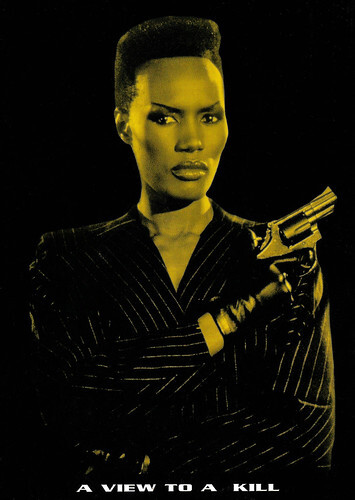
Vintage card in the Bond Girls series. Grace Jones in A View to a Kill (John Glen, 1985).
Grace Jones (1948) is a Jamaican singer, supermodel, and actress. Classic is her album 'Nightclubbing' (1981) and unforgettable are her hits 'La Vie en Rose', 'Pull Up to the Bumper' and 'I've Seen That Face Before'. She was also memorable as a James Bond villain in A View to a Kill (1985). But foremost, the unusual, androgynous, bold, dark-skinned artist was a style icon for the late 1970s and early 1980s.
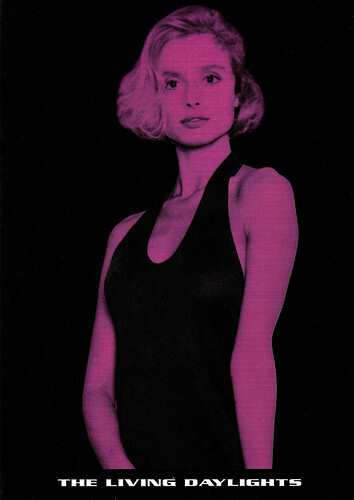
Vintage postcard in the Bond Girls series. Maryam d'Abo in The Living Daylights (John Glen, 1987).
English actress Maryam d'Abo (1960) starred as Bond Girl Kara Milovy in The Living Daylights (1987) opposite Timothy Dalton as 007.
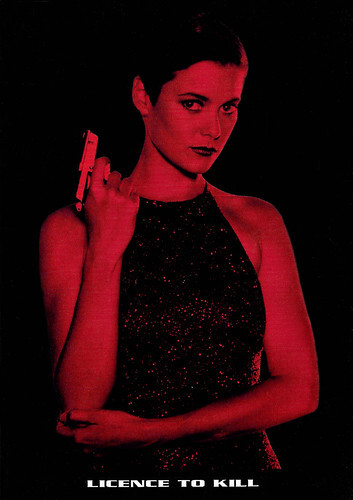
Vintage postcard in the Bond Girls series. Carey Lowell in Licence to Kill (John Glen, 1989).
American actress Carey Lowell is a former leading fashion model, almost 5'10'' (1 m 78) tall. She was a favourite with designers such as Calvin Klein and Ralph Lauren. As an actress, she is best known as New York Assistant DA Jamie Ross in Law and Order (1996–2001, 2022) and as Bond girl Pam Bouvier in the James Bond film Licence to Kill (1989).
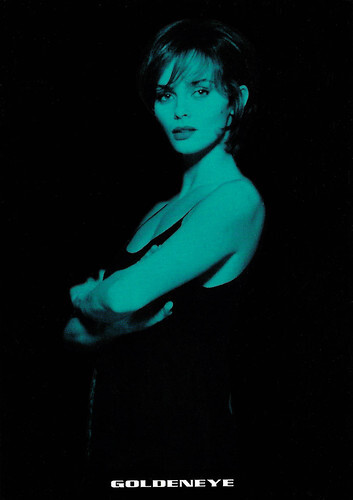
Vintage postcard in the Bond Girls Series. Izabella Scorupco in GoldenEye (Martin Campbell, 1995).
Izabella Scorupco (1970) is best known as Bond Girl Natalya Simonova in the James Bond film GoldenEye (1995) with Pierce Brosnan. She is also known for her cover of the Shirley & Company song 'Shame, Shame, Shame'.
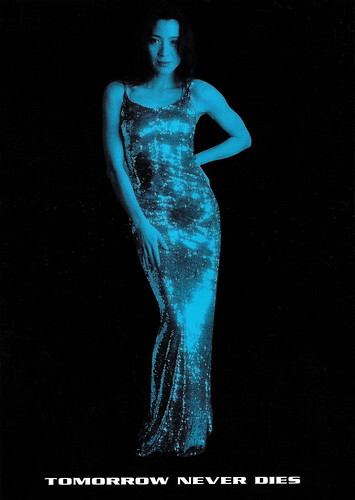
Vintage card in the Bond Girls series. Michelle Yeoh in Tomorrow Never Dies (Roger Spottiswoode, 1997).
Malaysian-Chinese actress Michelle Yeoh (1962) is known to Western audiences through her roles in the James Bond film Tomorrow Never Dies (1997), Crouching Tiger, Hidden Dragon (2000) and Everything Everywhere All at Once (2022), for which she received the Oscar. She is the second woman of colour to win the Academy Award for Best Actress.
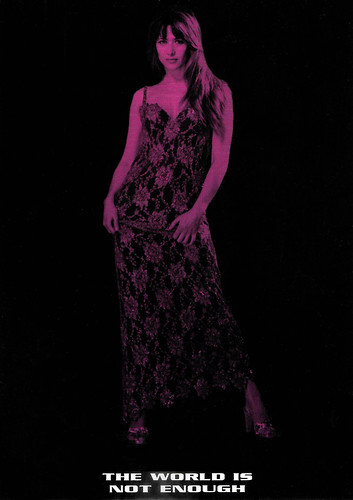
Vintage card in the Bond Girls series. Sophie Marceau in The World is Not Enough (Michael Apted, 1999).
French actress Sophie Marceau (1966) became a European film star with a string of successful films, including La boum/The Party (1980), L'Étudiante/The Student (1988), Fanfan (1993), and La fille de D'Artagnan/Revenge of the Musketeers (1994). Internationally she became known for her performances in Braveheart (1995), and the 19th James Bond film The World Is Not Enough (1999). She received a Cesar for La Boum 2 (1983) and she won a Moliere award for a stage production of 'Eurydice' in 1991.
Sources: Wikipedia (Dutch and English) and IMDb.

Vintage card in the Bond Girls series. Ursula Andress in Dr. No (Terence Young, 1962).
Stunning Swiss sex symbol, starlet, and jet-setter Ursula Andress (1936) will always be remembered as the first and quintessential Bond girl. In Dr No (1962), she made film history when she spectacularly rose out of the Caribbean Sea in a white bikini. Though she won a Golden Globe Ursula's looks generally outweighed her acting talent and she never took her film career very seriously.

Vintage postcard in the Bond Girls Series. Daniela Bianchi in From Russia With Love (Terence Young, 1963).
Beautiful Daniela Bianchi (1942) is an Italian actress, whose best-known part was the luscious Soviet cipher clerk Tatiana Romanova in the James Bond film From Russia with Love (1963). She played in several more Eurospy films during the 1960s.

Vintage card in the Bond Girls series. Honor Blackman in Goldfinger (Guy Hamilton, 1964).
British actress Honor Blackman (1925-2020) was best known for playing the Bond girl Pussy Galore opposite Sean Connery in Goldfinger (1964). Blackman became a household name in the 1960s as Cathy Gale in the TV series The Avengers in which she showed an extraordinary combination of beauty, brains and physical prowess. Her career spanned eight decades.

Vintage postcard in the Bond Girls Series. Claudine Auger in Thunderball (Terence Young, 1965).
French actress Claudine Auger (1941-2019) was best known as Bond Girl Domino in the James Bond film Thunderball (1965). At 17, she was Miss France 1958 and she became the first runner-up in the Miss World contest. Later she worked mostly in France and Italy.

Vintage card in the Bond Girls series. Akiko Wakabayashi in You Only Live Twice (Lewis Gilbert, 1967).
Akiko Wakabayashi (1939) is a retired Japanese actress. She is best known for her role as Bond girl Aki in the James Bond film You Only Live Twice (1967) with Sean Connery.

Vintage postcard in the Bond Girls Series. Diana Rigg in On Her Majesty's Secret Service (Peter R. Hunt, 1969).
English actress Diana Rigg (1938-2020) was well-known as Emma Peel in the classic TV series The Avengers (1965-1968) and as Lady Olenna Tyrell in Game of Thrones (2013-2017). In between she had an extensive career in film and theatre. Between 1959 and 1964, she performed for the Royal Shakespeare Company and won several awards, including a Tony and an Emmy award. In the cinema, she made her mark as Countess Teresa di Vicenzo, the only Bond girl to ever get 007 to the altar, in On Her Majesty's Secret Service (1969).

Vintage postcard in the Bond Girls Series. Jill St. John in Diamonds Are Forever (Guy Hamilton, 1971).
Voluptuous, red-haired American actress Jill St. John (1940) played countless bikini sexpot roles in Hollywood films of the 1960s. She was at her best as the tantalizing Bond girl Tiffany Case in Diamonds Are Forever (1971).
Bond Girls Are Forever
Nearly all of Ian Fleming's James Bond novels and short stories include one or more female characters who can be said to qualify as Bond girls. Fleming's Bond girls have some individual traits but they also have much in common. The typical Bond girl is in her early to mid-twenties, roughly ten years younger than Bond, who seems to be perennially in his mid-thirties. Bond girls possess splendid figures and tend to dress in a slightly masculine, assertive fashion, wearing little jewellery and square-toed leather shoes. They generally use little or no makeup and no nail polish, and also wear their nails short. Their hair may be any colour, though they typically wear it in a natural or casual cut that falls heavily to their shoulders. Their features, especially their eyes and mouths, are often widely spaced. The first description of a Bond girl, 'Casino Royale''s Vesper Lynd, is almost a template for the typical dress as well as the general appearance of later Bond girls; she sports nearly all of the features discussed above.
Another characteristic of Bond girls is their pattern of sexually suggestive names, such as Pussy Galore. Names with less obvious meanings are sometimes explained in the novels. While Solitaire's real name is Simone Latrelle, she is known as Solitaire because she excludes men from her life. Tiffany Case received her name from her father, who was so angry that she was not a boy that he gave her mother a thousand dollars and a compact from Tiffany's and then walked out on her. Fleming's penchant for double-entendre names began with the first Bond novel 'Casino Royale'. The name of the Bond girl in that novel, 'Vesper Lynd', was intended to be a pun on 'West Berlin', signifying Vesper's divided loyalties as a double agent under Soviet control. Several Bond girls, however, have normal names.
Most Bond girls are sexually experienced by the time they meet Bond. Quite often those previous experiences have not been positive, and many Bond girls have had sexual violence inflicted on them in the past, causing them to feel alienated from all men — until Bond comes along. Tiffany Case was gang-raped as a teenager. Honey Ryder was beaten and raped as a teenager by a drunken acquaintance. Pussy Galore was sexually abused at age 12 by her uncle. Kissy Suzuki reports to Bond that during her brief career in Hollywood when she was 17, "They thought that because I am Japanese I am some sort of an animal and that my body is for everyone." The implication is often that these violent episodes have turned these Bond girls against men, though upon encountering Bond they overcome their earlier antipathy and sleep with him not only willingly but eagerly. This trope reaches an extreme level in 'Goldfinger', where Pussy Galore is portrayed as a lesbian when she first meets Bond, but at the end of the novel she sleeps with him. When, in bed, he says to her, "They told me you only liked women," she replies, "I never met a man before."
In Fleming's novels, many Bond girls have some sort of independent job or career, often one that was considered inappropriate for women in the 1950s. Vesper Lynd, Tatiana Romanova, Mary Ann Russell, and Mary Goodnight are in intelligence or law-enforcement work. Those who are criminals, such as Case and Galore, tend to be similarly independent-minded in how they approach their work — the latter even running her own syndicate. Even those Bond girls who have more conventional or glamorous jobs show themselves to be invested in having an independent outlook on life. While the Bond girls are clearly intended as sex objects, they are nevertheless portrayed in the novels as having a high degree of independence. This is also frequently (but not always) the case in the films. In 'On Her Majesty's Secret Service', Bond enters into a relationship and an eventual marriage with Teresa 'Tracy' di Vicenzo.
Ursula Andress as Honey Ryder in Dr No (Terence Young, 1962) is widely regarded as the first Bond girl, although she was preceded by both Eunice Gayson as Sylvia Trench and Zena Marshall as Miss Taro in the same film. In Dr No, Sylvia Trench was also introduced as Bond girl. The idea was that James Bond would meet her in each film and marry her in the sixth and final film. This idea was abandoned after the second film. The third Bond film, Goldfinger (Guy Hamilton, 1964), established the Bond girl as regularly appearing in Bond films. There is no set rule on what kind of person a Bond girl will be or what role she will play. She may be an ally or an enemy of Bond, pivotal to the mission or simply there for her looks. There are female characters such as Judi Dench's M, who are not romantic interests of Bond, and hence may not be considered Bond girls. It is never explained why Bond's love interest in one film is gone by the next and is never mentioned or even alluded to again. This is not always the case in the novels, which do sometimes make references to the Bond girls who have appeared in previous books. For example, Tiffany Case and Honey Ryder are revealed to have married other men. In 2002, former Bond girl Maryam d'Abo co-wrote the book 'Bond Girls Are Forever: The Women of James Bond'. This book later became a DVD-exclusive documentary featuring d'Abo and other Bond girls, including Ursula Andress . In 2015, Monica Bellucci in Spectre (Sam Mendes, 2015) became the oldest Bond girl at the age of 50. She stated that she does not consider herself to be a 'Bond girl', but a 'Bond woman'.

Vintage postcard in the Bond Girls Series. Jane Seymour in Live and Let Die (Guy Hamilton, 1973).
British-American actress Jane Seymour (1951) is known as Dr Michaela Quinn in the long-running TV series Dr Quinn, Medicine Woman (1993-1998). She also was Bond Girl Solitaire in Live and Let Die (1973) and became 'the Queen of the Miniseries' in the 1980s and 1990s.

Vintage postcard in the Bond Girls series. Britt Ekland in The Man With the Golden Gun (Guy Hamilton, 1974).
Swedish actress Britt Ekland (1942) became famous through her marriage to Peter Sellers and her relationship with singer Rod Stewart. She was also known for her roles in such films as The Night They Raided Minsky's Get Carter, and The Man with the Golden Gun.

Vintage card in the Bond Girls series. Barbara Bach in The Spy Who Loved Me (Lewis Gilbert, 1977).
Barbara Bach (1947) is an American actress and former top model. She is best known as Bond girl Anya Amasova in the James Bond film The Spy Who Loved Me (1977), in which she played opposite Roger Moore. She is also known as the wife of ex-Beatle Ringo Starr. Bach has 28 films to her credit.

Vintage postcard in the Bond Girls series. Lois Chiles in Moonraker (Lewis Gilbert, 1979).
American actress and former model Lois Chiles (1947) is best known for her role as Bond Girl Dr Holly Goodhead in the James Bond film Moonraker (1979). Before entering films, she was one of the very top models of the 1970s. Her other screen credits include The Way We Were (1973), The Great Gatsby (1974), Death on the Nile (1978), and Broadcast News (1987).

Vintage postcard in the Bond Girls series. Carole Bouquet in For Your Eyes Only (John Glen, 1981).
Carole Bouquet (1957) is a French actress and fashion model. She is best known for her role as Bond Girl Melina Havelock in the 12th James Bond film, For Your Eyes Only (1981). In the following years, she became the face of the French fashion house Chanel. She also starred in Cet obscur objet du désir/That Obscure Object of Desire (1977), and Trop belle pour toi/Too Beautiful for You (1990), for which she won a César Award.

Vintage postcard in the Bond Girls series. Maud Adams in Octopussy (John Glen, 1983).
Stunning Maud Adams is a Swedish-born ex-model who broke into film in 1970. She is the only Bond Girl who appeared in three James Bond films, The Man with the Golden Gun (1974), Octopussy (1983) and A View to a Kill (1985).

Vintage card in the Bond Girls series. Grace Jones in A View to a Kill (John Glen, 1985).
Grace Jones (1948) is a Jamaican singer, supermodel, and actress. Classic is her album 'Nightclubbing' (1981) and unforgettable are her hits 'La Vie en Rose', 'Pull Up to the Bumper' and 'I've Seen That Face Before'. She was also memorable as a James Bond villain in A View to a Kill (1985). But foremost, the unusual, androgynous, bold, dark-skinned artist was a style icon for the late 1970s and early 1980s.

Vintage postcard in the Bond Girls series. Maryam d'Abo in The Living Daylights (John Glen, 1987).
English actress Maryam d'Abo (1960) starred as Bond Girl Kara Milovy in The Living Daylights (1987) opposite Timothy Dalton as 007.

Vintage postcard in the Bond Girls series. Carey Lowell in Licence to Kill (John Glen, 1989).
American actress Carey Lowell is a former leading fashion model, almost 5'10'' (1 m 78) tall. She was a favourite with designers such as Calvin Klein and Ralph Lauren. As an actress, she is best known as New York Assistant DA Jamie Ross in Law and Order (1996–2001, 2022) and as Bond girl Pam Bouvier in the James Bond film Licence to Kill (1989).

Vintage postcard in the Bond Girls Series. Izabella Scorupco in GoldenEye (Martin Campbell, 1995).
Izabella Scorupco (1970) is best known as Bond Girl Natalya Simonova in the James Bond film GoldenEye (1995) with Pierce Brosnan. She is also known for her cover of the Shirley & Company song 'Shame, Shame, Shame'.

Vintage card in the Bond Girls series. Michelle Yeoh in Tomorrow Never Dies (Roger Spottiswoode, 1997).
Malaysian-Chinese actress Michelle Yeoh (1962) is known to Western audiences through her roles in the James Bond film Tomorrow Never Dies (1997), Crouching Tiger, Hidden Dragon (2000) and Everything Everywhere All at Once (2022), for which she received the Oscar. She is the second woman of colour to win the Academy Award for Best Actress.

Vintage card in the Bond Girls series. Sophie Marceau in The World is Not Enough (Michael Apted, 1999).
French actress Sophie Marceau (1966) became a European film star with a string of successful films, including La boum/The Party (1980), L'Étudiante/The Student (1988), Fanfan (1993), and La fille de D'Artagnan/Revenge of the Musketeers (1994). Internationally she became known for her performances in Braveheart (1995), and the 19th James Bond film The World Is Not Enough (1999). She received a Cesar for La Boum 2 (1983) and she won a Moliere award for a stage production of 'Eurydice' in 1991.
Sources: Wikipedia (Dutch and English) and IMDb.
Published on December 22, 2024 22:00
December 21, 2024
Mickey Mouse
Mickey Mouse is a funny animal cartoon character and the mascot of The Walt Disney Company. He was created by Walt Disney and Ub Iwerks at the Walt Disney Studios in 1928. An anthropomorphic mouse whose face can be drawn as three black circles. Often he wears red shorts, large yellow shoes, and white gloves, Mickey is one of the world's most recognisable characters.
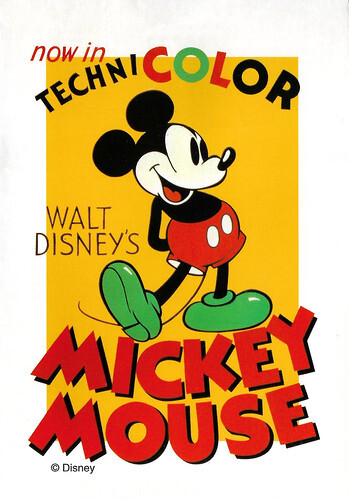
Swedish postcard by Scandecor, 1985, no. 3865. Image: Disney. Caption: Walt Disney's Mickey Mouse, now in Technicolor.
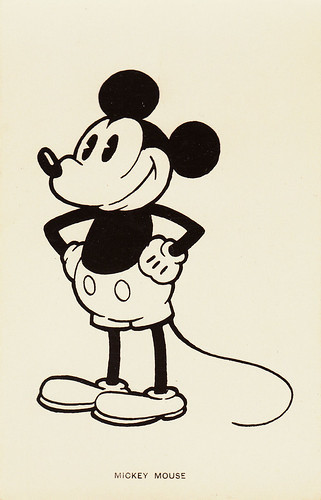
British postcard in the Picturegoer series. Image: Walt Disney. Collection: Marlene Pilaete.
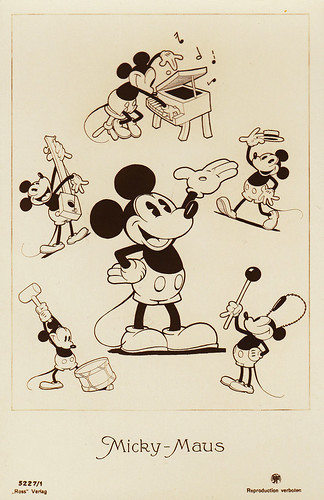
German postcard by Ross Verlag, no. 5227/1, 1930-1931. Image: Walt Disney. Collection: Marlene Pilaete.
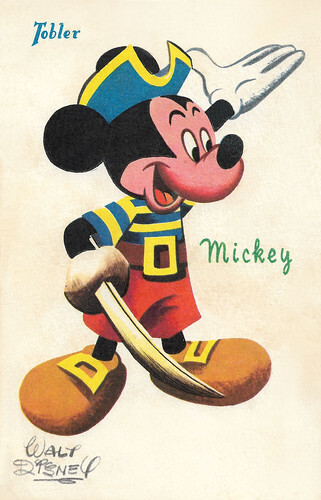
French postcard by Tobler. Image: The Walt Disney Company.
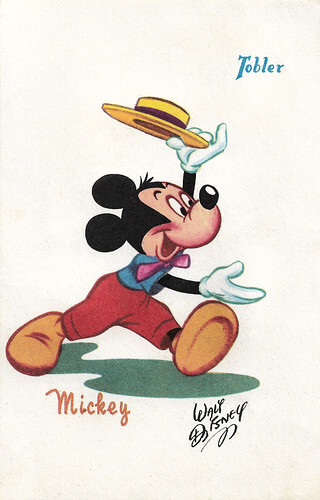
French postcard by Tobler. Image: The Walt Disney Company.
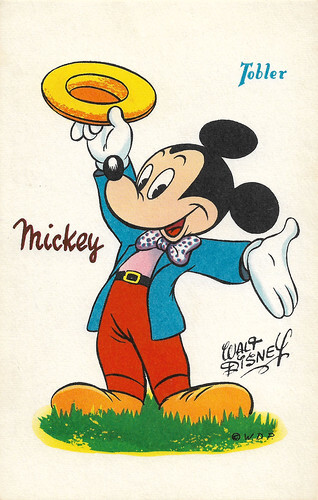
French postcard by Tobler. Image: The Walt Disney Company.
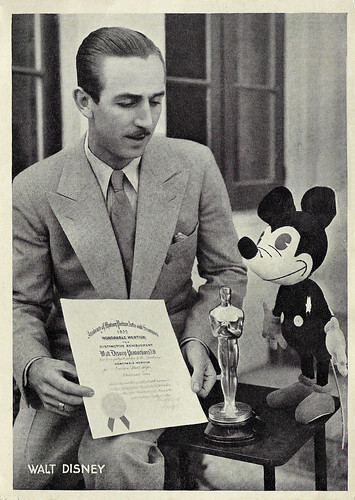
Vintage postcard. In 1932, Walt Disney received an honorary Academy Award for creating Mickey Mouse.
A mouse called Mortimer
Mickey Mouse was created as a replacement for a prior Disney character, Oswald the Lucky Rabbit. Walt Disney got the idea for the character from a mouse he saw in his Kansas City office. Initially, the character was to be named Mortimer Mouse, but Disney's wife Lillian Marie Bounds thought that name was too serious and not representative of the weaker members of the population. Therefore, the name Mickey was chosen.
The character's depiction as a small mouse is personified through his diminutive stature and falsetto voice. Mickey's voice was originally provided by Walt Disney. Mickey debuted publicly in the short film Steamboat Willie (1928), one of the first sound cartoons. It was co-directed by Walt Disney and Ub Iwerks. Iwerks again served as the head animator, assisted by Les Clark, Johnny Cannon, Wilfred Jackson and Dick Lundy.
This short was a nod to Buster Keaton 's Steamboat Bill, Jr. (Charles Reisner, Buster Keaton, 1928) released earlier that year. Although it was the third Mickey cartoon produced, it was the first to find a distributor and thus is considered by The Disney Company as Mickey's debut. Mickey Mouse went on to appear in over 130 films, including The Band Concert (Wilfred Jackson, 1935), Brave Little Tailor (Burt Gillett, Bill Roberts, 1938), and the feature Fantasia (James Algar, a.o., 1940).
The Band Concert (Wilfred Jackson, 1935) was Mickey's official first colour film. In 1932, he first appeared animated in colour in Parade of the Award Nominees. This film strip was created for the 5th Academy Awards ceremony and was not released to the public. In the production of The Band Concert (Wilfred Jackson, 1935), the Technicolor film process was used. Here Mickey conducted the 'William Tell Overture', but the band is swept up by a tornado.
By colourising and partially redesigning Mickey, Walt Disney put Mickey back on top once again. Mickey reached new heights of popularity. Brave Little Tailor (Burt Gillett, Bill Roberts, 1938), was an adaptation of the fairy tale 'The Valiant Little Tailor', which was nominated for an Academy Award. In total, ten of Mickey's cartoons were nominated for the Academy Award for Best Animated Short Film, one of which, Lend a Paw (Clyde Geronimi, 1941), won the award in 1942.
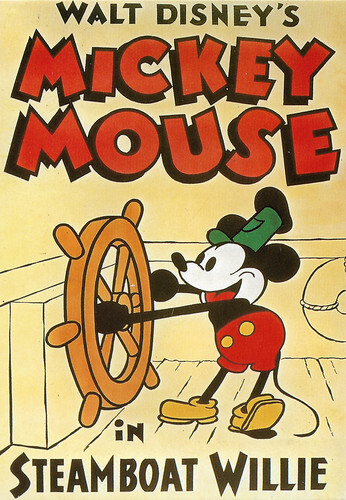
French poster postcard by Sonis, no. A 33. Image: The Walt Disney Company. Poster for Mickey Mouse in Steamboat Willie (Ub Iwerks, Walt Disney, 1928).
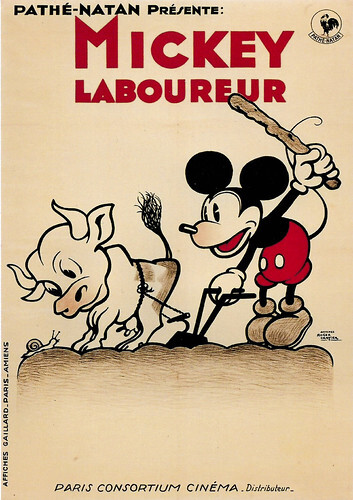
English poster postcard by Cinema. Image: Pathé Nathan / Roger Cartier / Paris Consortium Cinéma. French poster for Mickey Mouse in Mickey Laboureur/The Plowboy (Walt Disney, 1929).
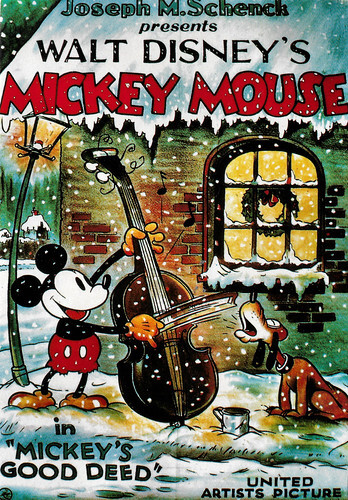
French poster postcard by Sonis, no. A 27. Image: The Walt Disney Company. Poster by United Artists for Mickey Mouse in Mickey's Good Deed (Burt Gillett, 1932).
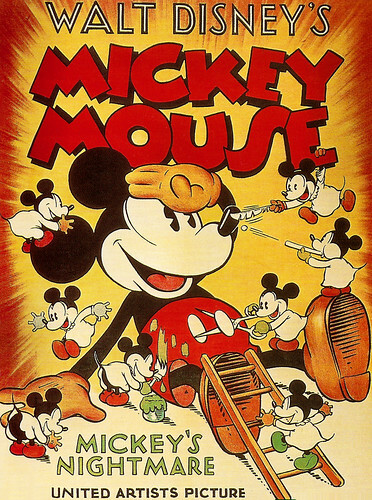
English poster postcard by Athena International, no. 334259. Image: The Walt Disney Co. Poster by United Artists for Mickey Mouse in Mickey's Nightmare (Clyde Geronimi, 1932).
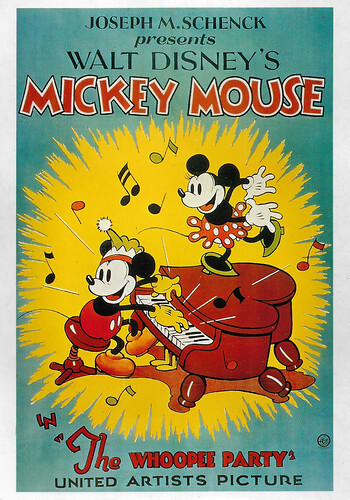
Vintage poster postcard by European Greetings, no. 535517. Image: Disney. Poster by United Artists for Mickey Mouse in The Whoopee Party (Burt Gillett, Wilfred Jackson, 1932).
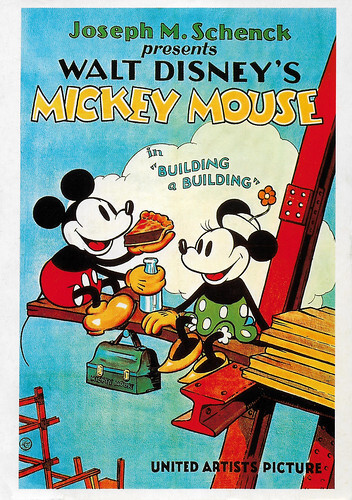
French poster postcard by EuroDisney, sent by mail in 1992. Image: Disney. Poster by United Artists for Mickey Mouse in Buidling a Building (David Hand, 1933).
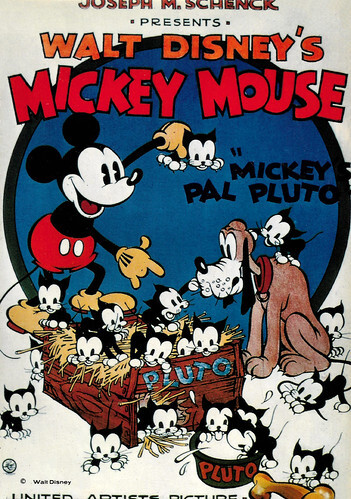
French poster postcard by Editions F. Nugeron, no. BD 26. Sent by mail in 1984. Image: Walt Disney. Poster by United Artists for Mickey Mouse and Pluto in Mickey's Pal Pluto (Burt Gillett, 1933).
A body of circles
Mickey Mouse's original design strongly resembled Oswald the Rabbit. Ub Iwerks designed Mickey's body out of circles (distinctly, the ears) to make the character easy to animate. Over the years, Mickey's appearance changed considerably. Pretty soon, Disney managed to give Mickey a friendlier face. In the oldest comics, Mickey wears red shorts with big buttons. In later versions, he dresses ‘normally’. Furthermore, he wears gloves that he never takes off.
In the 1930s, animator Fred Moore tried giving Mickey's body more of a pear shape to increase his acting range. Walt Disney liked this adaptation and declared, "That's the way I want Mickey to be drawn from now on." Mickey's character also changed quite a lot. In the first stories, he is predominantly a wanton little fellow who often plays strange pranks. Later, Mickey becomes much more serious and also quite sensible. Mickey is often the one who knows the right solution in difficult situations.
Mickey generally appears alongside his steady girlfriend Minnie Mouse, and his friends Donald Duck and Goofy. Remarkably, his pet dog Pluto behaves completely animal-like in every way, being the only one of the regular characters in the Mickey Mouse stories. Together, Mickey, Donald Duck, and Goofy would go on several adventures. Several of the films by the comic trio are some of Mickey's most critically acclaimed films.
These included Mickey's Fire Brigade (Ben Sharpsteen, 1935), Moose Hunters (Ben Sharpsteen, 1937), Clock Cleaners (Ben Sharpsteen, 1937), Lonesome Ghosts (Burt Gillett, 1937), Boat Builders (Ben Sharpsteen, 1938), and Mickey's Trailer (Ben Sharpsteen, 1938). In 1939, Mickey appeared in Mickey's Surprise Party (Hamilton Luske, 1939), along with Minnie, with a new design, which included pupils. Later on, in 1940, the character appeared in his first feature-length film, Fantasia (James Algar, a.o., 1940).
Fantasia (James Algar, a.o., 1940) used the redesigned version of Mickey with the pupils. His screen role as The Sorcerer's Apprentice set to the symphonic poem of the same name by Paul Dukas, is perhaps the most famous segment of the film and one of Mickey's most iconic roles. The apprentice (Mickey), not willing to do his chores, puts on the sorcerer's magic hat after the sorcerer goes to bed and casts a spell on a broom, which causes the broom to come to life and perform the most tiring chore—filling up a deep well using two buckets of water. When the well eventually overflows, Mickey finds himself unable to control the broom, leading to a near-flood. After the segment ends, Mickey is seen in silhouette shaking hands with conductor Leopold Stokowski. Mickey has often been pictured in the red robe and blue sorcerer's hat in merchandising.
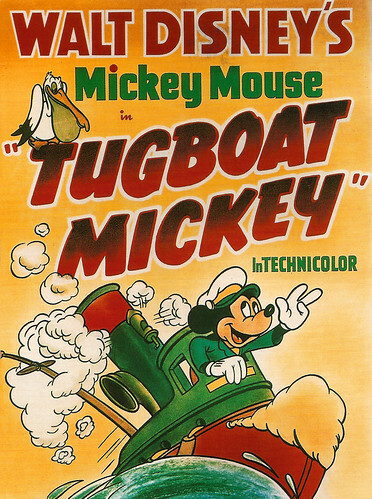
English poster postcard by Athena International, no. 334277. Image: The Walt Disney Co. Poster for Mickey Mouse in Tugboat Mickey (Clyde Geronimi, 1940).
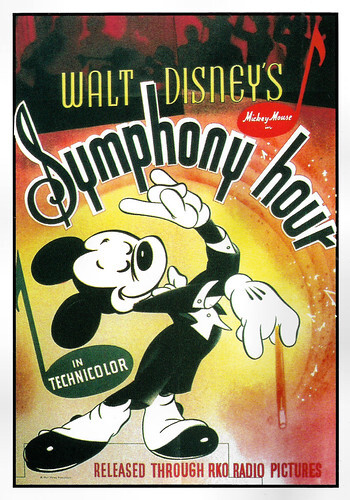
American poster postcard by Classico San Francisco Inc., no. 511-068. Image: The Walt Disney Company. Poster by RKO Radio Pictures for Mickey Mouse in Symphony Hour (Burt Gillett, 1942).
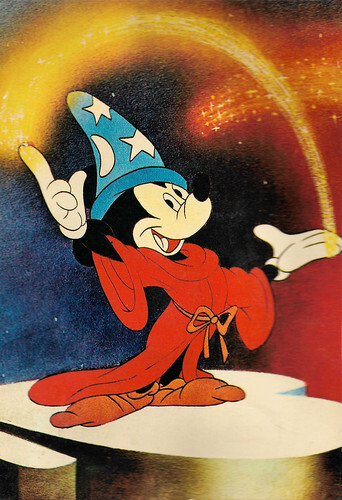
French postcard by Allain. Image: Walt Disney Productions. Mickey Mouse as the sorcerer's apprentice in Fantasia (James Algar, Wilfred Jackson, Hamilton Luske, Ben Sharpsteen, a.o., 1940).
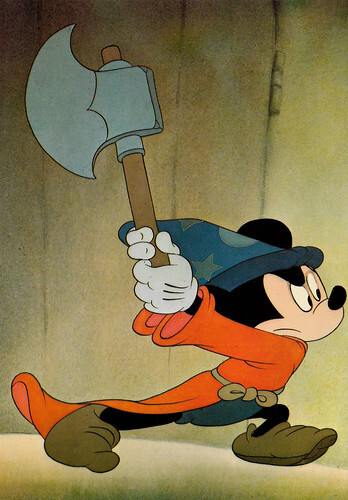
French postcard in the series The Wonderful World of Walt Disney by Editions Kroma, Caissargues, no. 5. Image: Walt Disney Productions. Mickey Mouse as the sorcerer's apprentice in Fantasia (James Algar, Wilfred Jackson, Hamilton Luske, Ben Sharpsteen, a.o., 1940).
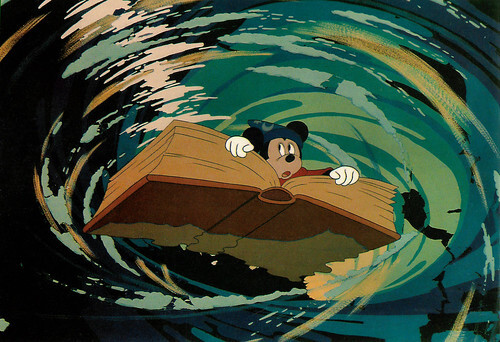
American postcard by Classico San Francisco, no. 328-008. Image: Walt Disney Productions. Mickey Mouse as the sorcerer's apprentice in Fantasia (James Algar, Wilfred Jackson, Hamilton Luske, Ben Sharpsteen, a.o., 1940).
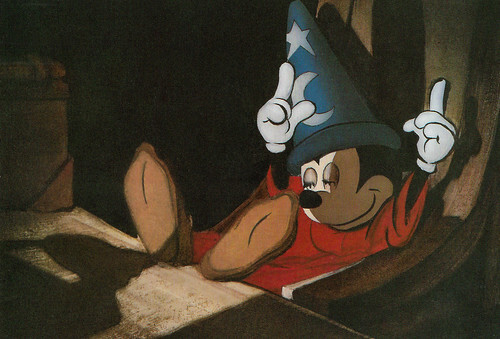
American postcard by Classico San Francisco, no. 328-009. Image: Walt Disney Productions. Mickey Mouse as the sorcerer's apprentice in Fantasia (James Algar, Wilfred Jackson, Hamilton Luske, Ben Sharpsteen, a.o., 1940).
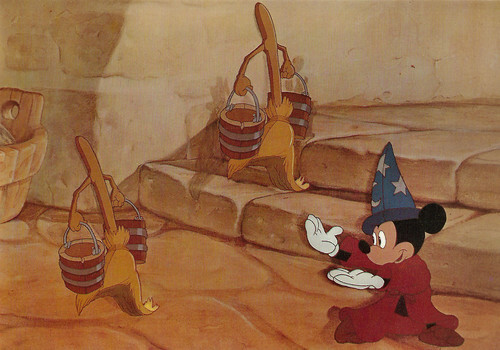
American postcard by Classico San Francisco, no. 328-0. Mickey Mouse as the sorcerer's apprentice in Fantasia (James Algar, Wilfred Jackson, Hamilton Luske, Ben Sharpsteen, a.o., 1940).
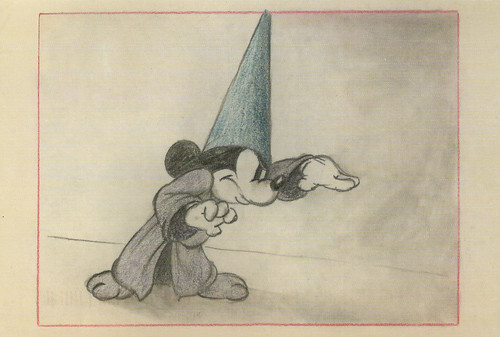
South Korean postcard by Disney Enterprises Inc, 2014. Image from 'The Art of Disney: The Golden Age (1937-1961)'. Sketch for Fantasia (James Algar, a.o., 1940).
Generation Mickey
Since 1930, Mickey Mouse has been featured extensively in comic strips and comic books. From 13 January 1930 to 29 July 1995, Mickey Mouse existed as a newspaper comic strip, published in numerous countries around the world. After 1940, Mickey's popularity declined until his 1955 re-emergence as a daily children's television personality.
Despite this, the character continued to appear regularly in animated shorts until 1943 (winning his only competitive Academy Award—with canine companion Pluto — for the short subject Lend a Paw) and again from 1946 to 1952. In these later cartoons, Mickey was often just a supporting character in his shorts. Pluto was instead used as the main character.
The character was featured in television series such as The Mickey Mouse Club (1955–1996). The last regular installment of the Mickey Mouse film series came in 1953 with The Simple Things in which Mickey and Pluto go fishing and are pestered by a flock of seagulls. A fan club for Mickey Mouse was founded in the 1960s, which is unprecedentedly popular and has thousands of members worldwide.
Mickey returned to theatrical animation with Mickey's Christmas Carol (Burny Mattinson, 1983) an adaptation of Charles Dickens' 'A Christmas Carol' in which Mickey played Bob Cratchit. This was followed up with The Prince and the Pauper (George Scribner, 1990). His most recent theatrical cartoon short was Get a Horse! (Lauren MacMullan, 2013) which was preceded by Runaway Brain (Chris Bailey, 1995).
From 1999 to 2004, he appeared in direct-to-video features like Mickey's Once Upon a Christmas (Jun Falkenstein, a.o., 1999), Mickey, Donald, Goofy: The Three Musketeers (Donovan Cook, 2004) and Mickey's Twice Upon a Christmas (Theresa Cullen, a.o., 2004). Mickey also appears in media such as video games as well as merchandising and is a meetable character at the Disney parks. He is one of the world's most recognisable and universally acclaimed fictional characters. In 1978, Mickey Mouse became the first cartoon character to have a star on the Hollywood Walk of Fame.
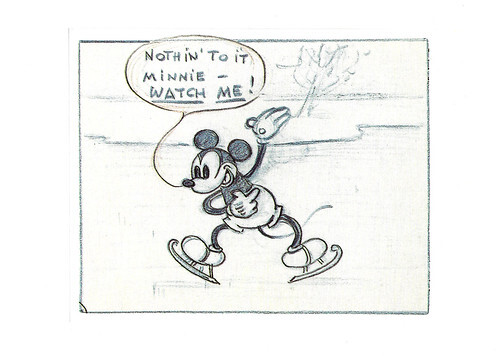
British postcard by The Art Group Ltd., no. 8780. Image: Disney. Original sketch of Mickey Mouse from On Ice (Ben Sharpsteen, 1935).
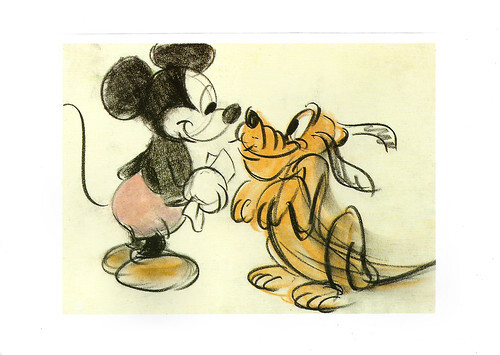
British postcard by The Art Group Ltd., no. 8262. Image: Disney. Original story sketch of Mickey Mouse and Pluto from Pluto's Purchase (Charles Nichols, Jack Kinney, 1948).
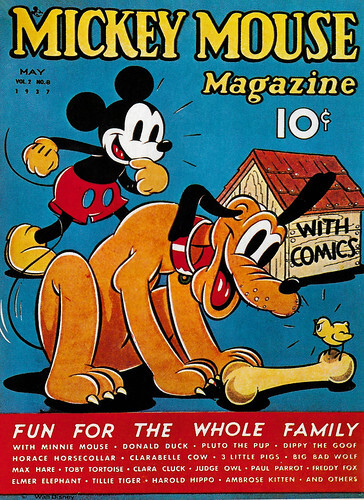
French postcard by Editions F. Nugeron, no. BD 16. Image: Walt Disney. Caption: Mickey Mouse 1937. Mickey Mouse Magazine, May 1937, Vol. 2, no. 8.
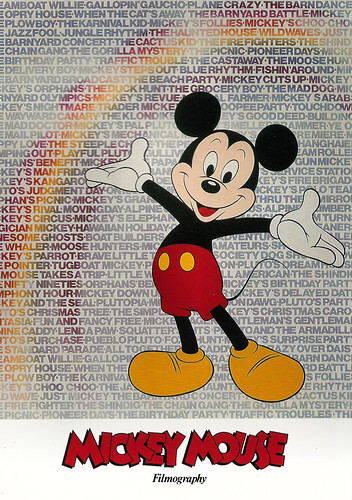
American postcard by The OSP Line - Lawson Mardon Post Card, Sparks, NV, no. HSC-614 (PC 709). Image: The Walt Disney Company. Caption: Mickey Filmography.
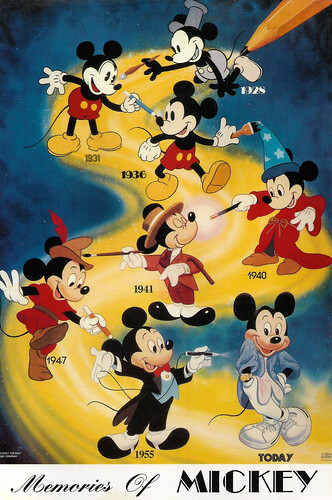
American postcard by Lawson Mardon Post Card, Sparks, NV / The O.S.P. Line, no. HSC-615 (PC 709). Image: The Walt Disney Company. Caption: Memories of Mickey. Generation Mickey.
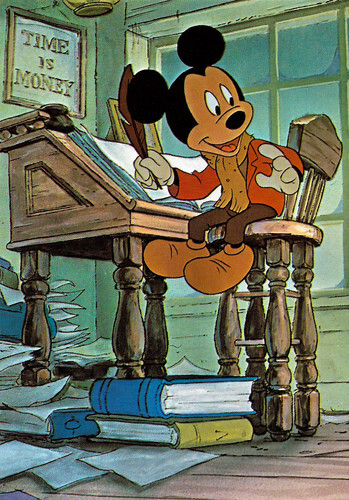
Italian postcard by Grafiche Biondetti srl, Verona, no. 133/4. Illustration: Walt Disney Productions. Film image of Mickey's Christmas Carol (Burny Mattinson, 1983). Sent by mail in 1988.
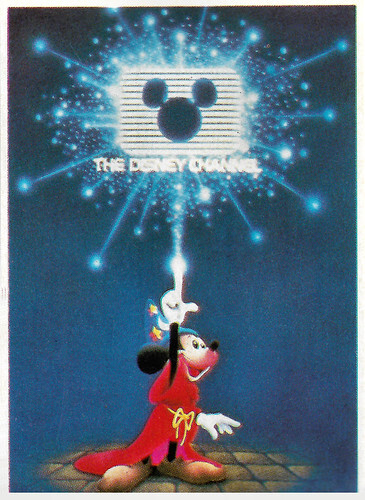
French collector card by Chocolat Poulain, Blois, series 42, no. 23. Image: Walt Disney Productions. Caption: Disney Channel.
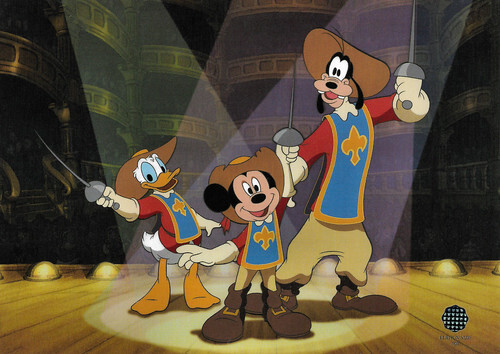
Vintage postcard by Animated Animations Company / Edition Size, no. 2000. Image: Walt Disney Animation Art. Postcard to promote a limited sericel of Mickey and Minnie as Romeo and Juliet.
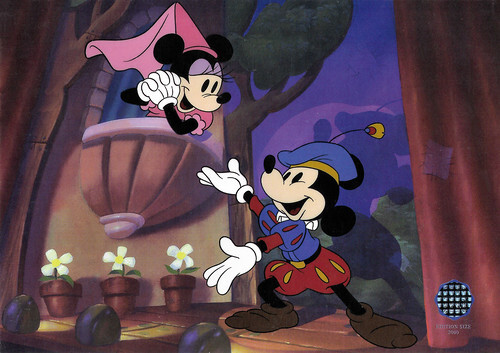
Vintage postcard by Animated Animations Company / Edition Size, no. 500. Image: Walt Disney Animation Art. Mickey Mouse, Donald Duck and Goofy in The Three Musketeers (Donovan Cook, 2004).
Sources: Wikipedia (English and Dutch) and .

Swedish postcard by Scandecor, 1985, no. 3865. Image: Disney. Caption: Walt Disney's Mickey Mouse, now in Technicolor.

British postcard in the Picturegoer series. Image: Walt Disney. Collection: Marlene Pilaete.

German postcard by Ross Verlag, no. 5227/1, 1930-1931. Image: Walt Disney. Collection: Marlene Pilaete.

French postcard by Tobler. Image: The Walt Disney Company.

French postcard by Tobler. Image: The Walt Disney Company.

French postcard by Tobler. Image: The Walt Disney Company.

Vintage postcard. In 1932, Walt Disney received an honorary Academy Award for creating Mickey Mouse.
A mouse called Mortimer
Mickey Mouse was created as a replacement for a prior Disney character, Oswald the Lucky Rabbit. Walt Disney got the idea for the character from a mouse he saw in his Kansas City office. Initially, the character was to be named Mortimer Mouse, but Disney's wife Lillian Marie Bounds thought that name was too serious and not representative of the weaker members of the population. Therefore, the name Mickey was chosen.
The character's depiction as a small mouse is personified through his diminutive stature and falsetto voice. Mickey's voice was originally provided by Walt Disney. Mickey debuted publicly in the short film Steamboat Willie (1928), one of the first sound cartoons. It was co-directed by Walt Disney and Ub Iwerks. Iwerks again served as the head animator, assisted by Les Clark, Johnny Cannon, Wilfred Jackson and Dick Lundy.
This short was a nod to Buster Keaton 's Steamboat Bill, Jr. (Charles Reisner, Buster Keaton, 1928) released earlier that year. Although it was the third Mickey cartoon produced, it was the first to find a distributor and thus is considered by The Disney Company as Mickey's debut. Mickey Mouse went on to appear in over 130 films, including The Band Concert (Wilfred Jackson, 1935), Brave Little Tailor (Burt Gillett, Bill Roberts, 1938), and the feature Fantasia (James Algar, a.o., 1940).
The Band Concert (Wilfred Jackson, 1935) was Mickey's official first colour film. In 1932, he first appeared animated in colour in Parade of the Award Nominees. This film strip was created for the 5th Academy Awards ceremony and was not released to the public. In the production of The Band Concert (Wilfred Jackson, 1935), the Technicolor film process was used. Here Mickey conducted the 'William Tell Overture', but the band is swept up by a tornado.
By colourising and partially redesigning Mickey, Walt Disney put Mickey back on top once again. Mickey reached new heights of popularity. Brave Little Tailor (Burt Gillett, Bill Roberts, 1938), was an adaptation of the fairy tale 'The Valiant Little Tailor', which was nominated for an Academy Award. In total, ten of Mickey's cartoons were nominated for the Academy Award for Best Animated Short Film, one of which, Lend a Paw (Clyde Geronimi, 1941), won the award in 1942.

French poster postcard by Sonis, no. A 33. Image: The Walt Disney Company. Poster for Mickey Mouse in Steamboat Willie (Ub Iwerks, Walt Disney, 1928).

English poster postcard by Cinema. Image: Pathé Nathan / Roger Cartier / Paris Consortium Cinéma. French poster for Mickey Mouse in Mickey Laboureur/The Plowboy (Walt Disney, 1929).

French poster postcard by Sonis, no. A 27. Image: The Walt Disney Company. Poster by United Artists for Mickey Mouse in Mickey's Good Deed (Burt Gillett, 1932).

English poster postcard by Athena International, no. 334259. Image: The Walt Disney Co. Poster by United Artists for Mickey Mouse in Mickey's Nightmare (Clyde Geronimi, 1932).

Vintage poster postcard by European Greetings, no. 535517. Image: Disney. Poster by United Artists for Mickey Mouse in The Whoopee Party (Burt Gillett, Wilfred Jackson, 1932).

French poster postcard by EuroDisney, sent by mail in 1992. Image: Disney. Poster by United Artists for Mickey Mouse in Buidling a Building (David Hand, 1933).

French poster postcard by Editions F. Nugeron, no. BD 26. Sent by mail in 1984. Image: Walt Disney. Poster by United Artists for Mickey Mouse and Pluto in Mickey's Pal Pluto (Burt Gillett, 1933).
A body of circles
Mickey Mouse's original design strongly resembled Oswald the Rabbit. Ub Iwerks designed Mickey's body out of circles (distinctly, the ears) to make the character easy to animate. Over the years, Mickey's appearance changed considerably. Pretty soon, Disney managed to give Mickey a friendlier face. In the oldest comics, Mickey wears red shorts with big buttons. In later versions, he dresses ‘normally’. Furthermore, he wears gloves that he never takes off.
In the 1930s, animator Fred Moore tried giving Mickey's body more of a pear shape to increase his acting range. Walt Disney liked this adaptation and declared, "That's the way I want Mickey to be drawn from now on." Mickey's character also changed quite a lot. In the first stories, he is predominantly a wanton little fellow who often plays strange pranks. Later, Mickey becomes much more serious and also quite sensible. Mickey is often the one who knows the right solution in difficult situations.
Mickey generally appears alongside his steady girlfriend Minnie Mouse, and his friends Donald Duck and Goofy. Remarkably, his pet dog Pluto behaves completely animal-like in every way, being the only one of the regular characters in the Mickey Mouse stories. Together, Mickey, Donald Duck, and Goofy would go on several adventures. Several of the films by the comic trio are some of Mickey's most critically acclaimed films.
These included Mickey's Fire Brigade (Ben Sharpsteen, 1935), Moose Hunters (Ben Sharpsteen, 1937), Clock Cleaners (Ben Sharpsteen, 1937), Lonesome Ghosts (Burt Gillett, 1937), Boat Builders (Ben Sharpsteen, 1938), and Mickey's Trailer (Ben Sharpsteen, 1938). In 1939, Mickey appeared in Mickey's Surprise Party (Hamilton Luske, 1939), along with Minnie, with a new design, which included pupils. Later on, in 1940, the character appeared in his first feature-length film, Fantasia (James Algar, a.o., 1940).
Fantasia (James Algar, a.o., 1940) used the redesigned version of Mickey with the pupils. His screen role as The Sorcerer's Apprentice set to the symphonic poem of the same name by Paul Dukas, is perhaps the most famous segment of the film and one of Mickey's most iconic roles. The apprentice (Mickey), not willing to do his chores, puts on the sorcerer's magic hat after the sorcerer goes to bed and casts a spell on a broom, which causes the broom to come to life and perform the most tiring chore—filling up a deep well using two buckets of water. When the well eventually overflows, Mickey finds himself unable to control the broom, leading to a near-flood. After the segment ends, Mickey is seen in silhouette shaking hands with conductor Leopold Stokowski. Mickey has often been pictured in the red robe and blue sorcerer's hat in merchandising.

English poster postcard by Athena International, no. 334277. Image: The Walt Disney Co. Poster for Mickey Mouse in Tugboat Mickey (Clyde Geronimi, 1940).

American poster postcard by Classico San Francisco Inc., no. 511-068. Image: The Walt Disney Company. Poster by RKO Radio Pictures for Mickey Mouse in Symphony Hour (Burt Gillett, 1942).

French postcard by Allain. Image: Walt Disney Productions. Mickey Mouse as the sorcerer's apprentice in Fantasia (James Algar, Wilfred Jackson, Hamilton Luske, Ben Sharpsteen, a.o., 1940).

French postcard in the series The Wonderful World of Walt Disney by Editions Kroma, Caissargues, no. 5. Image: Walt Disney Productions. Mickey Mouse as the sorcerer's apprentice in Fantasia (James Algar, Wilfred Jackson, Hamilton Luske, Ben Sharpsteen, a.o., 1940).

American postcard by Classico San Francisco, no. 328-008. Image: Walt Disney Productions. Mickey Mouse as the sorcerer's apprentice in Fantasia (James Algar, Wilfred Jackson, Hamilton Luske, Ben Sharpsteen, a.o., 1940).

American postcard by Classico San Francisco, no. 328-009. Image: Walt Disney Productions. Mickey Mouse as the sorcerer's apprentice in Fantasia (James Algar, Wilfred Jackson, Hamilton Luske, Ben Sharpsteen, a.o., 1940).

American postcard by Classico San Francisco, no. 328-0. Mickey Mouse as the sorcerer's apprentice in Fantasia (James Algar, Wilfred Jackson, Hamilton Luske, Ben Sharpsteen, a.o., 1940).

South Korean postcard by Disney Enterprises Inc, 2014. Image from 'The Art of Disney: The Golden Age (1937-1961)'. Sketch for Fantasia (James Algar, a.o., 1940).
Generation Mickey
Since 1930, Mickey Mouse has been featured extensively in comic strips and comic books. From 13 January 1930 to 29 July 1995, Mickey Mouse existed as a newspaper comic strip, published in numerous countries around the world. After 1940, Mickey's popularity declined until his 1955 re-emergence as a daily children's television personality.
Despite this, the character continued to appear regularly in animated shorts until 1943 (winning his only competitive Academy Award—with canine companion Pluto — for the short subject Lend a Paw) and again from 1946 to 1952. In these later cartoons, Mickey was often just a supporting character in his shorts. Pluto was instead used as the main character.
The character was featured in television series such as The Mickey Mouse Club (1955–1996). The last regular installment of the Mickey Mouse film series came in 1953 with The Simple Things in which Mickey and Pluto go fishing and are pestered by a flock of seagulls. A fan club for Mickey Mouse was founded in the 1960s, which is unprecedentedly popular and has thousands of members worldwide.
Mickey returned to theatrical animation with Mickey's Christmas Carol (Burny Mattinson, 1983) an adaptation of Charles Dickens' 'A Christmas Carol' in which Mickey played Bob Cratchit. This was followed up with The Prince and the Pauper (George Scribner, 1990). His most recent theatrical cartoon short was Get a Horse! (Lauren MacMullan, 2013) which was preceded by Runaway Brain (Chris Bailey, 1995).
From 1999 to 2004, he appeared in direct-to-video features like Mickey's Once Upon a Christmas (Jun Falkenstein, a.o., 1999), Mickey, Donald, Goofy: The Three Musketeers (Donovan Cook, 2004) and Mickey's Twice Upon a Christmas (Theresa Cullen, a.o., 2004). Mickey also appears in media such as video games as well as merchandising and is a meetable character at the Disney parks. He is one of the world's most recognisable and universally acclaimed fictional characters. In 1978, Mickey Mouse became the first cartoon character to have a star on the Hollywood Walk of Fame.

British postcard by The Art Group Ltd., no. 8780. Image: Disney. Original sketch of Mickey Mouse from On Ice (Ben Sharpsteen, 1935).

British postcard by The Art Group Ltd., no. 8262. Image: Disney. Original story sketch of Mickey Mouse and Pluto from Pluto's Purchase (Charles Nichols, Jack Kinney, 1948).

French postcard by Editions F. Nugeron, no. BD 16. Image: Walt Disney. Caption: Mickey Mouse 1937. Mickey Mouse Magazine, May 1937, Vol. 2, no. 8.

American postcard by The OSP Line - Lawson Mardon Post Card, Sparks, NV, no. HSC-614 (PC 709). Image: The Walt Disney Company. Caption: Mickey Filmography.

American postcard by Lawson Mardon Post Card, Sparks, NV / The O.S.P. Line, no. HSC-615 (PC 709). Image: The Walt Disney Company. Caption: Memories of Mickey. Generation Mickey.

Italian postcard by Grafiche Biondetti srl, Verona, no. 133/4. Illustration: Walt Disney Productions. Film image of Mickey's Christmas Carol (Burny Mattinson, 1983). Sent by mail in 1988.

French collector card by Chocolat Poulain, Blois, series 42, no. 23. Image: Walt Disney Productions. Caption: Disney Channel.

Vintage postcard by Animated Animations Company / Edition Size, no. 2000. Image: Walt Disney Animation Art. Postcard to promote a limited sericel of Mickey and Minnie as Romeo and Juliet.

Vintage postcard by Animated Animations Company / Edition Size, no. 500. Image: Walt Disney Animation Art. Mickey Mouse, Donald Duck and Goofy in The Three Musketeers (Donovan Cook, 2004).
Sources: Wikipedia (English and Dutch) and .
Published on December 21, 2024 22:00
December 20, 2024
Directed by Jacques Feyder
Jacques Feyder (1885-1948) was a Belgian-born, French film director, screenwriter actor, film producer and editor, who worked in France, England, Germany, Switzerland and Hollywood. In the 1930s he became associated with the style of poetic realism in French cinema and directed such classics as Le Grand Jeu (1934), Pension Mimosas (1934), and the satire La Kermesse héroïque (1935). Feyder made more than 40 films. His wife, the well-known actress Françoise Rosay starred in most of them.
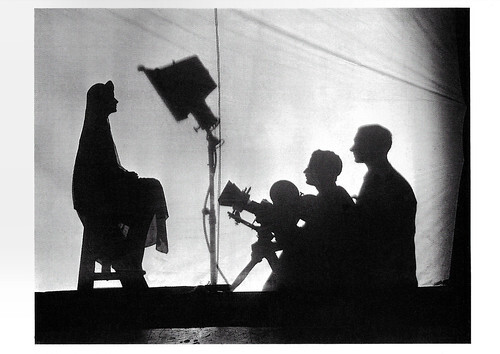
Swiss-German-British postcard by News Productions, Baulmes / Filmwelt Berlin, Bakede / News Productions, Stroud, no. 56492. Photo: Collection Cinémathèque Suisse, Lausanne. Set photo of Greta Garbo in The Kiss (Jacques Feyder, 1929), produced by MGM.
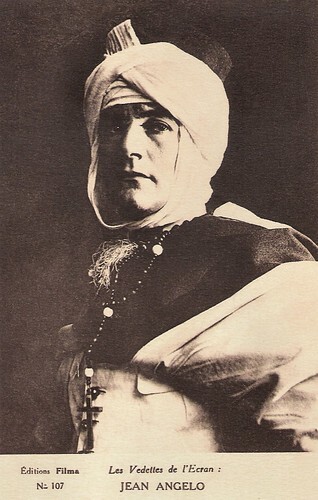
French postcard by Editions Filma in Les vedettes de l'Ecran series, no. 107. Jean Angelo in L’Atlantide/Lost Atlantis (Jacques Feyder, 1922).
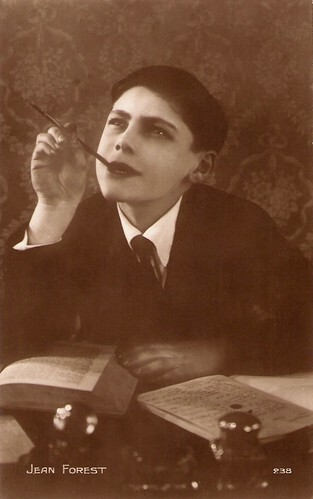
French postcard by Cinémagazine, no. 238. Jean Forest in Gribiche (Jacques Feyder, 1926).
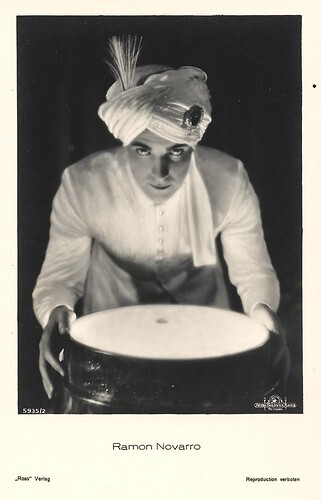
German postcard by Ross Verlag / Ballerini & Fratini, Firenze, no. 535/2. Photo: Metro-Goldwyn-Mayer. Ramon Novarro in Son of India (Jacques Feyder, 1931).
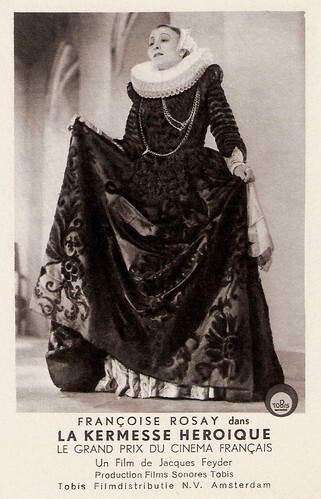
Dutch postcard by Tobis filmdistributie N.V. Amsterdam. Photo: Tobis. Francoise Rosay in La Kermesse Heroique (Jacques Feyder, 1935). Collection: Geoffrey Donaldson Institute.
Passion for filmmaking
Jacques Feyder was born Jacques Léon Louis Frédérix in Ixelles, Belgium, in 1885. He was the son of Alfred Frédérix, a lawyer, president of the Cercle artistique de Bruxelles and director of the Compagnie internationale des Wagons-Lits, and Angèle Picard. He was the grandson of Gustave Frédérix, a famous Belgian theatre critic.
In his bourgeois family, many members belonged to the military. Jacques was initially also destined for a military career but decided to pursue an interest in acting. In 1908, he made his stage debut At the age of 25, Feyder moved from Belgium to Paris. There he appeared in various theatres, but initially only in small roles.
His film career began in 1912 as an actor under such directors as Georges Méliès and Louis Feuillade . He became increasingly interested in filmmaking and assisted the director Gaston Ravel from 1914 to 1915 (some sources say from 1912). At the time, filmmaking was not recognised as a creative profession and Feyder was only rarely credited in the films.
From 1916, he directed his own films for the Gaumont film company. He was paid very little by Gaumont, one franc per metre of film shot. His passion for filmmaking led him to adopt a pseudonym. From Frédérix, he changed his surname to Feyder (in Brussels, he had lived near rue Faider). At first, Feyder mainly made small comedies.
In 1917, he married the actress Françoise Rosay . They remained married until his death. She starred in most of his films, from the short film Têtes de femmes, femmes de tête (1916) to Macadam (1946), of which he had only the artistic supervision. In 1917, Feyder was drafted into the Belgian army and worked as an actor in troop entertainment. He successfully returned to the film business in 1919.
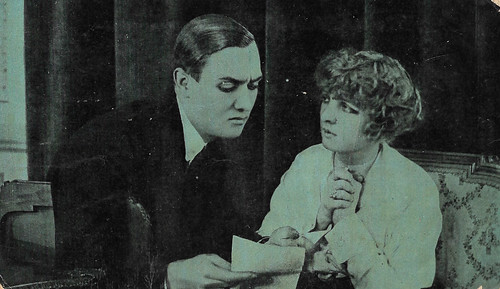
Spanish collector card (cromo) by Chocolate Salas, Sabadell, card no. 4. Photo: Gaumont. André Roanne as the adulterous Lord Stanley and Kitty Hot as his wife, who with her sister's help teaches him a lesson in the comedy Têtes de femmes, femmes de tête (1916), the debut of director Jacques Feyder.
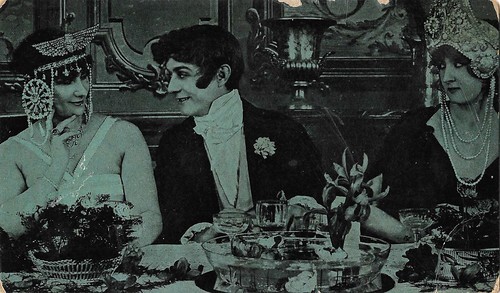
Spanish collector card (cromo) by Chocolate Salas, Sabadell, card no. 5. Photo: Gaumont. nother scene from Têtes de femmes, femmes de tête (Jacques Feyder, 1916). Before she leaves for the spas, Princess Orazzi (Georgette Faraboni, left) gives a farewell dinner as a 'bal costumé'. Here she flirts with the married Lord ( André Roanne ), who is head-over-heels in love with her. His sister-in-law (Suzanne Delvé, right) defends her sister.
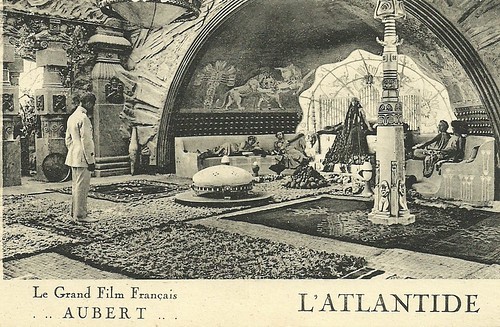
French postcard for the Louis Aubert production L'Atlantide/Lost Atlantis (Jacques Feyder, 1921). The card depicts the French captain Morhange ( Jean Angelo ) who is received by the mysterious and cruel desert queen Antinéa ( Stacia Napierkowska ). The sets were by Manuel Orazi.
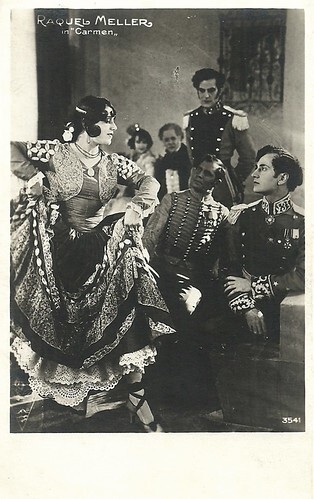
Italian postcard by G. Vettori, Bologna, no. 3541. Photo: Albatros. Raquel Meller in Carmen (Jacques Feyder, 1926).

Italian postcard by G. Vettori, Bologna, no. 3544. Raquel Meller and Raymond Guérin-Catelain in Carmen (Jacques Feyder, 1926). Collection: Marlene Pilaete.
A reputation as an innovative director
Jacques Feyder had his artistic breakthrough with the epic adventure film L'Atlantide/Lost Atlantis (1921), starring Jean Angelo as Capt. Morhange and Stacia Napierkowska as Queen Antinéa. He shot the film, based on a novel by Pierre Benoît in Africa over eight months. He wanted to film the Sahara and other locations as described by Benoit. L'Atlantide revealed his mastery of depicting wide-open spaces. Despite the 3-hour running time, the film ran at a Paris cinema for over one year and was widely sold abroad.
Another important feature film was the drama Crainquebille (1922) with Jean Forest , based on a novel by Anatole France. The film was also successful and received good reviews, so Feyder built up a reputation as an innovative director in the French film world.
Another masterpiece was Visages d'enfants/Children's Faces (1923), one of his most personal and enduring films made in Switzerland. The film deals with the emotional situation of stepchildren. The extras were real peasants, many of whom had never seen a camera or even attended a film screening. The scenes were shot in the village of Grimentz, where Feyder and Françoise Rosay would return almost twenty years later to make Une femme disparaît/Portrait of a Woman (1942). Only the interiors of the chalet and the chapel, buried under the avalanche, were shot in the studio in Paris. Visages d'enfants was finally released in 1925, hailed as a milestone film by the critics but shunned by the public.
He re-established himself with Gribiche (1926) and the literary adaptation Carmen (1926), starring Raquel Meller . Feyder became a naturalised French citizen inn 1928. His satirical comedy Les nouveaux messieurs/The New Gentlemen (1928) was censored for ‘offending the dignity of Parliament and its ministers’. He therefore turned his attention abroad for a while. In Germany, Feyder made Thérèse Raquin (1928), based on Émile Zola 's novel and starring Gina Manès .
Then MGM contacted Feyder to work in Hollywood. He accepted MGM’s proposal and directed the last silent film with Greta Garbo , The Kiss (1929) with Conrad Nagel and Lew Ayres . The film has no audible dialogue but features a synchronised musical score and sound effects. He had no problems with the switch to sound film and shot the German version of Garbo’s first sound film Anna Christie (1930) in the USA. In 1930, he directed Jetta Goudal in her only French language film made in Hollywood, Le Spectre vert/The Green Spectre. He also made two films with Ramon Novarro , Daybreak (1931) and Son of India (1931), in which his search for light and his sense of poetry were evident.
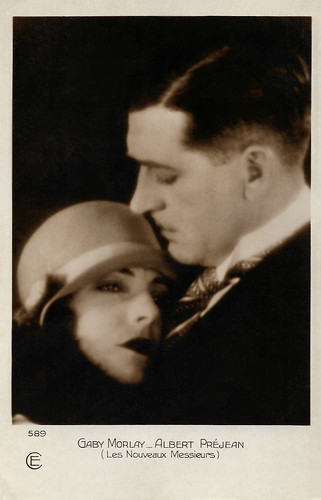
French postcard by Cinémagazine-Edition, Paris, no. 589. Albert Préjean and Gaby Morlay in Les nouveaux messieurs/The New Gentlemen (Jacques Feyder, 1928).
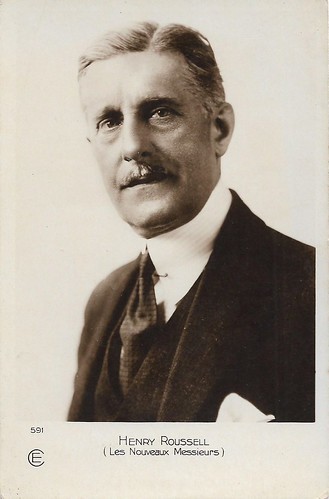
French postcard by Cinémagazine-Edition, Paris, no. 591. Henry Roussel in Les nouveaux messieurs/The New Gentlemen (Jacques Feyder, 1928).
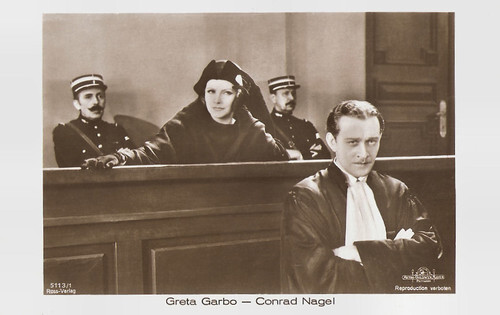
German postcard by Ross Verlag, no. 5113/1, 1930-1931. Photo: Metro-Goldwyn-Mayer (MGM). Greta Garbo and Conrad Nagel in The Kiss (Jacques Feyder, 1929).
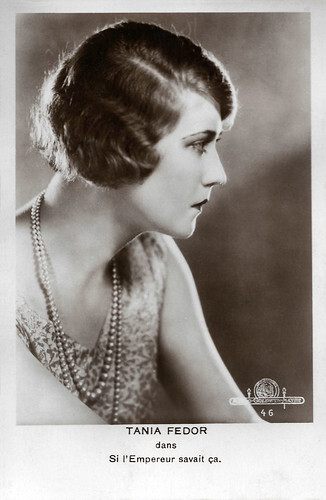
Belgian postcard by P.I.A. Belga phot, Bruxelles, no. 46. Photo: Metro-Goldwyn-Mayer. Tania Fédor in Si l’empereur savait ça/His Glorious Night (Jacques Feyder, 1930). Caption: The most beautiful films are performed by the stars of Metro Goldwyn Mayer.
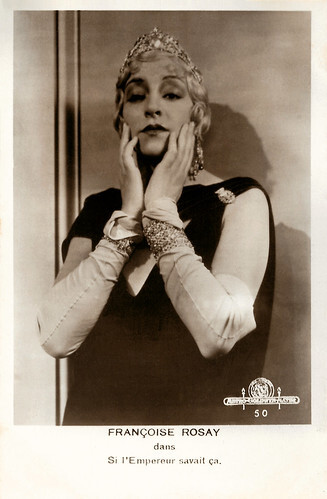
Belgian postcard by P.I.A. Belga phot, Bruxelles, no. 50. Photo: Metro-Goldwyn-Mayer. Francoise Rosay in Si l'empereur savait ça/His Glorious Night (Jacques Feyder, 1930).
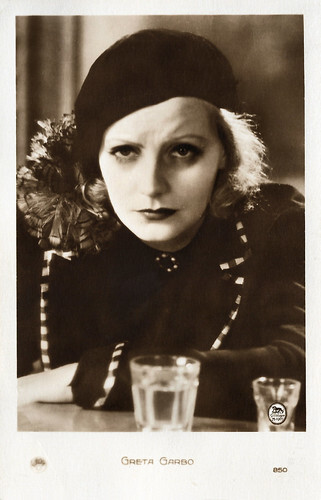
French postcard by Europe, no. 850. Photo: Metro-Goldwyn-Mayer / Clarence Sinclair Bull. Greta Garbo in the German version of Anna Christie (Jacques Feyder, 1930).
A craftsman of filmmaking
Disillusioned with the Hollywood system, Jacques Feyder returned to France in 1933. There he became one of the leading representatives and co-founders of French poetic realism in film in the 1930s. He directed, among others, the drama Le Grand Jeu (1934) set against the background of the French Foreign Legion, Pension Mimosas (1934) set largely in a small hotel on the Côte d'Azur, and the satire La Kermesse héroïque/Carnival in Flanders (1935).
He co-wrote the screenplay of these three classics with his compatriot Charles Spaak and he gave Marcel Carné his foot in the door by casting him as his assistant director. For La Kermesse héroïque, Feyder won the Grand Prix du cinéma français in 1935 and the prize for Best Direction at the Venice Film Festival in 1936.
Jacques Feyder made more foreign films, including Knight Without Armour (1937) with Marlene Dietrich, until the Second World War. By the time the war broke out, Feyder had been directing for some thirty years and had completed his career. He had gone from silent to sound cinema. He had seen the film industry become more structured and the importance of his work as a director was more widely recognised in the industry.
At the beginning of 1939, he shot an adventure drama with Michèle Morgan , La loi du nord/The Law of the North (1939). The film was selected for the first edition of the Cannes Film Festival, but this was cancelled following the outbreak of war. During the German Occupation, the Nazis changed the title to La Piste du Nord/The Trail of the North. Following the Nazi occupation, Feyder fled to neutral Switzerland. There he made his last film, the mystery Une femme disparaît/Portrait of a Woman (1942) starring Rosay, and gave readings at the conservatory in Geneva.
In 1944 Feyder and Françoise Rosay published ‘Le Cinéma, notre métier’, an autobiographical memoir of their work together in the cinema, in which Feyder stated that he regarded himself as an 'artisan', a craftsman of filmmaking. Towards the end of his life, he took on the artistic directorship of Marcel Blistène's dark crime drama Macadam/Back Streets of Paris (1946) starring Françoise Rosay once more. Two years later, Jacques Feyder died in Prangins, Switzerland, in 1948. at the age of 62. His funeral took place in Brussels and he is buried in the Brussels Cemetery in Evere. With Rosay, Feyder had three sons who also worked in the film industry: the set designer Marc Frédérix and the assistant directors Paul Feyder and Bernard Farre.
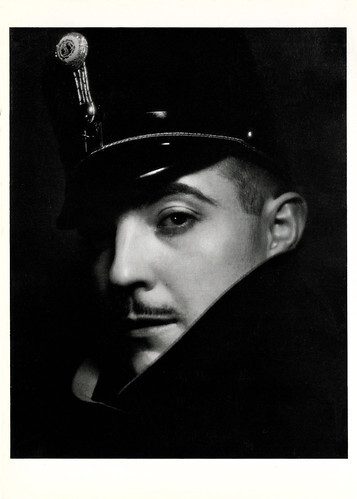
American postcard by Fotofolio, NY, NY, no. GH8. Photo: George Hurrell / Creative Art Images, Hollywood. Caption: Ramon Novarro , 1931. Publicity still for Daybreak (Jacques Feyder, 1931).
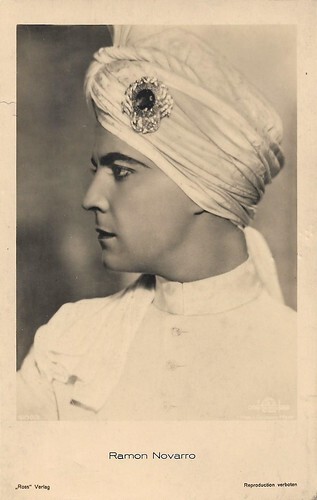
German postcard by Ross Verlag, unnumbered. Photo: Metro-Goldwyn-Mayer. Ramon Novarro in Son of India (Jacques Feyder, 1931).
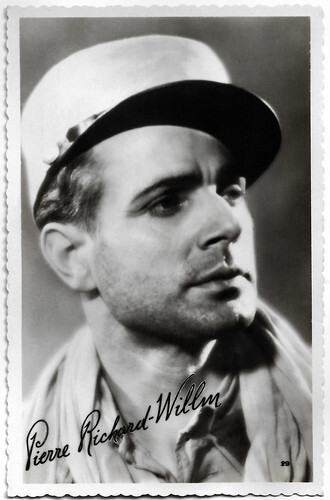
French postcard, no. 29. Pierre Richard Willm in Le grand jeu/The Great Game (Jacques Feyder, 1934).
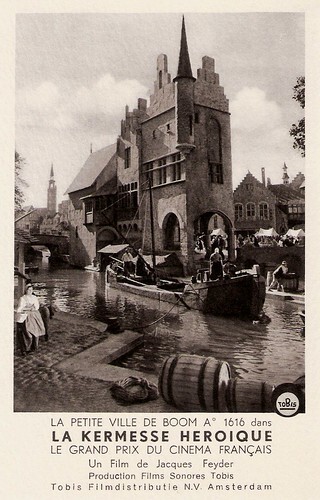
Dutch postcard by Tobis filmdistributie N.V. Amsterdam. Photo: Tobis. Publicity still for La Kermesse Heroique (1935). Collection: Geoffrey Donaldson Institute.
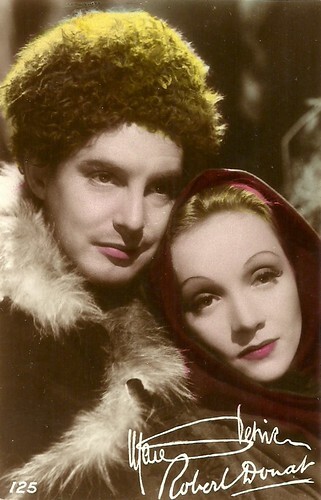
British postcard by Art Photo Postcard, no. 125. Marlene Dietrich and Robert Donat in the London Films production Knight Without Armour (Jacques Feyder, 1937). This historical drama set during the Russian Revolution and the Civil War was produced by Alexander Korda from a screenplay by Lajos Bíró adapted by Frances Marion from the 1933 novel of the same title by James Hilton.
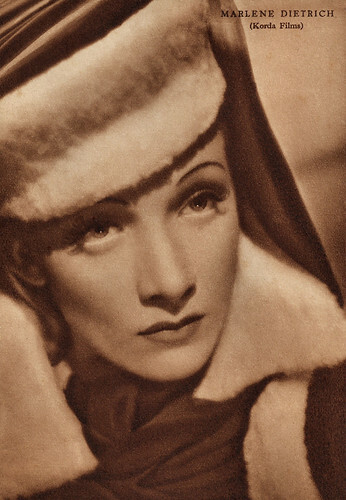
Italian postcard by Rizzoli & c., Milano, 1938 XVI Photo: Korda Films. Marlene Dietrich in Knight Without Armour (Jacques Feyder, 1937).
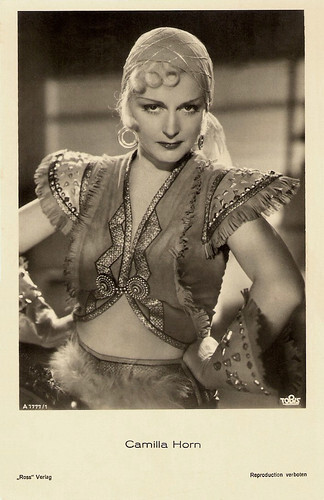
German postcard by Ross Verlag, no. A 1777/1, 1937-1938. Photo: Tobis. Camilla Horn in Fahrendes Volk/Travelling people (Jacques Feyder, 1938).
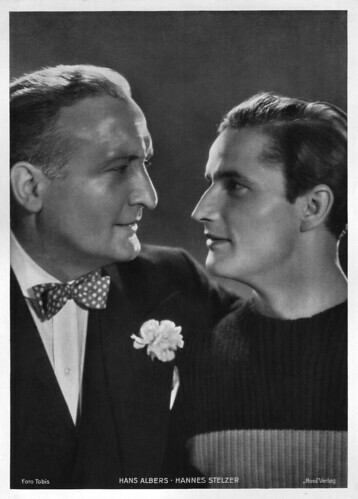
Big German collectors card by Ross Verlag. Photo: Tobis. Hans Albers and Hannes Stelzer in Fahrendes Volk/Travelling people (Jacques Feyder, 1938).
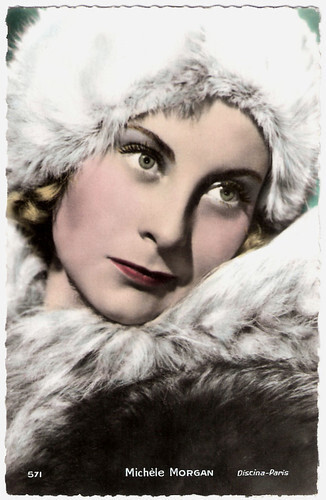
French postcard by Edit. Chantal, Rueil, no. 571. Photo: Discina, Paris. Michèle Morgan in La Loi du Nord/Law of the North (Jacques Feyder, 1939).
Sources: Wikipedia (Dutch, German, French and English) and .

Swiss-German-British postcard by News Productions, Baulmes / Filmwelt Berlin, Bakede / News Productions, Stroud, no. 56492. Photo: Collection Cinémathèque Suisse, Lausanne. Set photo of Greta Garbo in The Kiss (Jacques Feyder, 1929), produced by MGM.

French postcard by Editions Filma in Les vedettes de l'Ecran series, no. 107. Jean Angelo in L’Atlantide/Lost Atlantis (Jacques Feyder, 1922).

French postcard by Cinémagazine, no. 238. Jean Forest in Gribiche (Jacques Feyder, 1926).

German postcard by Ross Verlag / Ballerini & Fratini, Firenze, no. 535/2. Photo: Metro-Goldwyn-Mayer. Ramon Novarro in Son of India (Jacques Feyder, 1931).

Dutch postcard by Tobis filmdistributie N.V. Amsterdam. Photo: Tobis. Francoise Rosay in La Kermesse Heroique (Jacques Feyder, 1935). Collection: Geoffrey Donaldson Institute.
Passion for filmmaking
Jacques Feyder was born Jacques Léon Louis Frédérix in Ixelles, Belgium, in 1885. He was the son of Alfred Frédérix, a lawyer, president of the Cercle artistique de Bruxelles and director of the Compagnie internationale des Wagons-Lits, and Angèle Picard. He was the grandson of Gustave Frédérix, a famous Belgian theatre critic.
In his bourgeois family, many members belonged to the military. Jacques was initially also destined for a military career but decided to pursue an interest in acting. In 1908, he made his stage debut At the age of 25, Feyder moved from Belgium to Paris. There he appeared in various theatres, but initially only in small roles.
His film career began in 1912 as an actor under such directors as Georges Méliès and Louis Feuillade . He became increasingly interested in filmmaking and assisted the director Gaston Ravel from 1914 to 1915 (some sources say from 1912). At the time, filmmaking was not recognised as a creative profession and Feyder was only rarely credited in the films.
From 1916, he directed his own films for the Gaumont film company. He was paid very little by Gaumont, one franc per metre of film shot. His passion for filmmaking led him to adopt a pseudonym. From Frédérix, he changed his surname to Feyder (in Brussels, he had lived near rue Faider). At first, Feyder mainly made small comedies.
In 1917, he married the actress Françoise Rosay . They remained married until his death. She starred in most of his films, from the short film Têtes de femmes, femmes de tête (1916) to Macadam (1946), of which he had only the artistic supervision. In 1917, Feyder was drafted into the Belgian army and worked as an actor in troop entertainment. He successfully returned to the film business in 1919.

Spanish collector card (cromo) by Chocolate Salas, Sabadell, card no. 4. Photo: Gaumont. André Roanne as the adulterous Lord Stanley and Kitty Hot as his wife, who with her sister's help teaches him a lesson in the comedy Têtes de femmes, femmes de tête (1916), the debut of director Jacques Feyder.

Spanish collector card (cromo) by Chocolate Salas, Sabadell, card no. 5. Photo: Gaumont. nother scene from Têtes de femmes, femmes de tête (Jacques Feyder, 1916). Before she leaves for the spas, Princess Orazzi (Georgette Faraboni, left) gives a farewell dinner as a 'bal costumé'. Here she flirts with the married Lord ( André Roanne ), who is head-over-heels in love with her. His sister-in-law (Suzanne Delvé, right) defends her sister.

French postcard for the Louis Aubert production L'Atlantide/Lost Atlantis (Jacques Feyder, 1921). The card depicts the French captain Morhange ( Jean Angelo ) who is received by the mysterious and cruel desert queen Antinéa ( Stacia Napierkowska ). The sets were by Manuel Orazi.

Italian postcard by G. Vettori, Bologna, no. 3541. Photo: Albatros. Raquel Meller in Carmen (Jacques Feyder, 1926).

Italian postcard by G. Vettori, Bologna, no. 3544. Raquel Meller and Raymond Guérin-Catelain in Carmen (Jacques Feyder, 1926). Collection: Marlene Pilaete.
A reputation as an innovative director
Jacques Feyder had his artistic breakthrough with the epic adventure film L'Atlantide/Lost Atlantis (1921), starring Jean Angelo as Capt. Morhange and Stacia Napierkowska as Queen Antinéa. He shot the film, based on a novel by Pierre Benoît in Africa over eight months. He wanted to film the Sahara and other locations as described by Benoit. L'Atlantide revealed his mastery of depicting wide-open spaces. Despite the 3-hour running time, the film ran at a Paris cinema for over one year and was widely sold abroad.
Another important feature film was the drama Crainquebille (1922) with Jean Forest , based on a novel by Anatole France. The film was also successful and received good reviews, so Feyder built up a reputation as an innovative director in the French film world.
Another masterpiece was Visages d'enfants/Children's Faces (1923), one of his most personal and enduring films made in Switzerland. The film deals with the emotional situation of stepchildren. The extras were real peasants, many of whom had never seen a camera or even attended a film screening. The scenes were shot in the village of Grimentz, where Feyder and Françoise Rosay would return almost twenty years later to make Une femme disparaît/Portrait of a Woman (1942). Only the interiors of the chalet and the chapel, buried under the avalanche, were shot in the studio in Paris. Visages d'enfants was finally released in 1925, hailed as a milestone film by the critics but shunned by the public.
He re-established himself with Gribiche (1926) and the literary adaptation Carmen (1926), starring Raquel Meller . Feyder became a naturalised French citizen inn 1928. His satirical comedy Les nouveaux messieurs/The New Gentlemen (1928) was censored for ‘offending the dignity of Parliament and its ministers’. He therefore turned his attention abroad for a while. In Germany, Feyder made Thérèse Raquin (1928), based on Émile Zola 's novel and starring Gina Manès .
Then MGM contacted Feyder to work in Hollywood. He accepted MGM’s proposal and directed the last silent film with Greta Garbo , The Kiss (1929) with Conrad Nagel and Lew Ayres . The film has no audible dialogue but features a synchronised musical score and sound effects. He had no problems with the switch to sound film and shot the German version of Garbo’s first sound film Anna Christie (1930) in the USA. In 1930, he directed Jetta Goudal in her only French language film made in Hollywood, Le Spectre vert/The Green Spectre. He also made two films with Ramon Novarro , Daybreak (1931) and Son of India (1931), in which his search for light and his sense of poetry were evident.

French postcard by Cinémagazine-Edition, Paris, no. 589. Albert Préjean and Gaby Morlay in Les nouveaux messieurs/The New Gentlemen (Jacques Feyder, 1928).

French postcard by Cinémagazine-Edition, Paris, no. 591. Henry Roussel in Les nouveaux messieurs/The New Gentlemen (Jacques Feyder, 1928).

German postcard by Ross Verlag, no. 5113/1, 1930-1931. Photo: Metro-Goldwyn-Mayer (MGM). Greta Garbo and Conrad Nagel in The Kiss (Jacques Feyder, 1929).

Belgian postcard by P.I.A. Belga phot, Bruxelles, no. 46. Photo: Metro-Goldwyn-Mayer. Tania Fédor in Si l’empereur savait ça/His Glorious Night (Jacques Feyder, 1930). Caption: The most beautiful films are performed by the stars of Metro Goldwyn Mayer.

Belgian postcard by P.I.A. Belga phot, Bruxelles, no. 50. Photo: Metro-Goldwyn-Mayer. Francoise Rosay in Si l'empereur savait ça/His Glorious Night (Jacques Feyder, 1930).

French postcard by Europe, no. 850. Photo: Metro-Goldwyn-Mayer / Clarence Sinclair Bull. Greta Garbo in the German version of Anna Christie (Jacques Feyder, 1930).
A craftsman of filmmaking
Disillusioned with the Hollywood system, Jacques Feyder returned to France in 1933. There he became one of the leading representatives and co-founders of French poetic realism in film in the 1930s. He directed, among others, the drama Le Grand Jeu (1934) set against the background of the French Foreign Legion, Pension Mimosas (1934) set largely in a small hotel on the Côte d'Azur, and the satire La Kermesse héroïque/Carnival in Flanders (1935).
He co-wrote the screenplay of these three classics with his compatriot Charles Spaak and he gave Marcel Carné his foot in the door by casting him as his assistant director. For La Kermesse héroïque, Feyder won the Grand Prix du cinéma français in 1935 and the prize for Best Direction at the Venice Film Festival in 1936.
Jacques Feyder made more foreign films, including Knight Without Armour (1937) with Marlene Dietrich, until the Second World War. By the time the war broke out, Feyder had been directing for some thirty years and had completed his career. He had gone from silent to sound cinema. He had seen the film industry become more structured and the importance of his work as a director was more widely recognised in the industry.
At the beginning of 1939, he shot an adventure drama with Michèle Morgan , La loi du nord/The Law of the North (1939). The film was selected for the first edition of the Cannes Film Festival, but this was cancelled following the outbreak of war. During the German Occupation, the Nazis changed the title to La Piste du Nord/The Trail of the North. Following the Nazi occupation, Feyder fled to neutral Switzerland. There he made his last film, the mystery Une femme disparaît/Portrait of a Woman (1942) starring Rosay, and gave readings at the conservatory in Geneva.
In 1944 Feyder and Françoise Rosay published ‘Le Cinéma, notre métier’, an autobiographical memoir of their work together in the cinema, in which Feyder stated that he regarded himself as an 'artisan', a craftsman of filmmaking. Towards the end of his life, he took on the artistic directorship of Marcel Blistène's dark crime drama Macadam/Back Streets of Paris (1946) starring Françoise Rosay once more. Two years later, Jacques Feyder died in Prangins, Switzerland, in 1948. at the age of 62. His funeral took place in Brussels and he is buried in the Brussels Cemetery in Evere. With Rosay, Feyder had three sons who also worked in the film industry: the set designer Marc Frédérix and the assistant directors Paul Feyder and Bernard Farre.

American postcard by Fotofolio, NY, NY, no. GH8. Photo: George Hurrell / Creative Art Images, Hollywood. Caption: Ramon Novarro , 1931. Publicity still for Daybreak (Jacques Feyder, 1931).

German postcard by Ross Verlag, unnumbered. Photo: Metro-Goldwyn-Mayer. Ramon Novarro in Son of India (Jacques Feyder, 1931).

French postcard, no. 29. Pierre Richard Willm in Le grand jeu/The Great Game (Jacques Feyder, 1934).

Dutch postcard by Tobis filmdistributie N.V. Amsterdam. Photo: Tobis. Publicity still for La Kermesse Heroique (1935). Collection: Geoffrey Donaldson Institute.

British postcard by Art Photo Postcard, no. 125. Marlene Dietrich and Robert Donat in the London Films production Knight Without Armour (Jacques Feyder, 1937). This historical drama set during the Russian Revolution and the Civil War was produced by Alexander Korda from a screenplay by Lajos Bíró adapted by Frances Marion from the 1933 novel of the same title by James Hilton.

Italian postcard by Rizzoli & c., Milano, 1938 XVI Photo: Korda Films. Marlene Dietrich in Knight Without Armour (Jacques Feyder, 1937).

German postcard by Ross Verlag, no. A 1777/1, 1937-1938. Photo: Tobis. Camilla Horn in Fahrendes Volk/Travelling people (Jacques Feyder, 1938).

Big German collectors card by Ross Verlag. Photo: Tobis. Hans Albers and Hannes Stelzer in Fahrendes Volk/Travelling people (Jacques Feyder, 1938).

French postcard by Edit. Chantal, Rueil, no. 571. Photo: Discina, Paris. Michèle Morgan in La Loi du Nord/Law of the North (Jacques Feyder, 1939).
Sources: Wikipedia (Dutch, German, French and English) and .
Published on December 20, 2024 22:00
December 19, 2024
George Robey
George Robey (1869-1954) was an English comedian, singer and actor in musical theatre, who became known as one of the greatest music hall performers of the late 19th and early 20th centuries. As a comedian, Robey mixed everyday situations and observations with comic absurdity. Apart from his music hall acts, he was a popular Christmas pantomime performer in the English provinces, where he excelled in the 'pantomime Dame' roles. Robey only had modest success in the cinema.
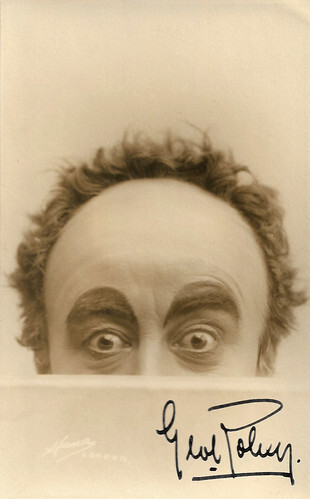
British postcard by K LTD. Photo: Hana, London.
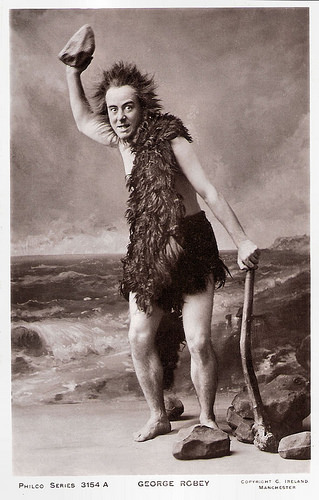
British postcard in the Philco Series by Rotary Photo EC., no. 3154 A. Photo: C. Ireland, Manchester. In 1902 Robey created the character The Prehistoric Man. He dressed as a caveman and spoke of modern political issues, often complaining about the government "slapping another pound of rock on his taxes". The character was received favourably by audiences, who found it easy to relate to his topical observations. That year he released The Prehistoric Man on a shellac disc using the early acoustic recording process.
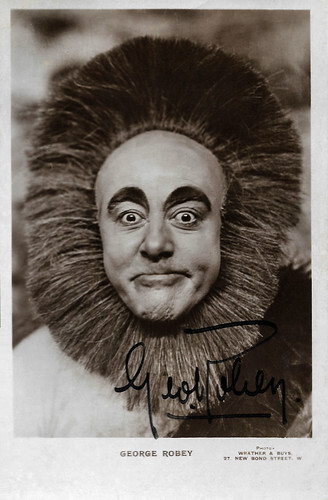
British postcard. Photo: Wrather & Buys.
The Prime Minister of Mirth
George Robey was born as George Edward Wade in London in 1869. He came from a middle-class family. His father, Charles Wade, was a civil engineer who spent much of his career on tramline design and construction. Robey's mother, Elizabeth Mary Wade née Keene, was a housewife. After schooling in England and Germany and a series of office jobs, he made his debut on the London stage, at the age of 21, as the straight man to a comic hypnotist. He soon developed his own act and appeared at the Oxford Music Hall in 1890, where he earned favourable notices singing 'The Simple Pimple' and 'He'll Get It Where He's Gone to Now'.
In 1892, Robey appeared in his first pantomime, 'Whittington Up-to-date' in Brighton, which brought him to a wider audience. With Robey's popularity came an eagerness to differentiate himself from his music hall rivals, and so he devised a signature costume when appearing as himself: an oversized black coat fastened from the neck down with large, wooden buttons; black, unkempt, baggy trousers and a partially bald wig with black, whispery strands of unbrushed, dirty-looking hair that poked below a large, dishevelled top-hat. He applied thick white face paint and exaggerated the redness on his cheeks and nose with bright red makeup. His eyeline and eyebrows were also enhanced with thick, black grease paint. He held a short, misshaped, wooden walking stick, which was curved at the top.
George Robey later used the costume for his character, The Prime Minister of Mirth. The outfit helped Robey become instantly recognisable on the London music hall circuit. More provincial engagements followed in Manchester, Birmingham and Liverpool, and he soon became a mainstay of the popular Christmas pantomime scene. By the start of the new century, Robey was a big name in pantomime, and he was able to choose his roles. Pantomime enjoyed wide popularity until the 1890s, but by the time Robey had reached his peak, interest in it was on the wane. A type of character he particularly enjoyed taking on was the pantomime dame, which historically was played by comedians from the music hall. Robey was inspired by the older comedians Herbert Campbell and Dan Leno , and, although post-dating them, he rivalled their eccentricity and popularity, earning the festive entertainment a new audience. Robey's music hall act matured in the first decade of the 1900s, and he undertook several foreign tours. He starred in the Royal Command Performance in 1912 and regularly entertained before the aristocracy.
Robey made his film debut in 1900, according to IMDb . The short comedy The Rats (N.N., 1900) offered a brief glimpse of some of the greatest entertainers from the late Victorian and early Edwardian stage, including Dan Leno , Herbert Campbell and George Robey. In 1913, Robey appeared in two early sound shorts: And Very Nice Too (Walter R. Boots, 1913) and Good Queen Bess (Walter R. Boots, 1913), made in the Kinoplasticon process, where the film was synchronised with phonograph records. The next year, he tried to emulate his music hall colleagues Billy Merson and Charlie Austin, who had set up Homeland Films and found success with the Squibs film series starring Betty Balfour . Robey met filmmakers from the Burns Film Company, who engaged him in a silent short entitled George Robey Turns Anarchist, in which he played a character who fails to blow up the Houses of Parliament. George Robey's Day Off (1919) showed the comedian acting out his daily domestic routines to comic effect, but the picture failed at the box office.
Producers obviously did not know how best to apply Robey's stage talents to the film. He continued to appear sporadically in film throughout the rest of his career, never achieving more than a modest amount of success. By the First World War, music hall entertainment had fallen out of favour with audiences. Revue appealed to wartime audiences, and Robey decided to capitalise on the medium's popularity. He achieved great success in The Bing Boys Are Here (1916). He was cast as Lucius Bing opposite Violet Loraine, who played his love interest Emma. The couple duetted in the show's signature song If You Were the Only Girl (In the World), which became an international success. Robey raised money for many war charities and was appointed a CBE in 1919. From 1918, George Robey created sketches based on his Prime Minister of Mirth character and used a costume he had designed in the 1890s as a basis for the character's attire.
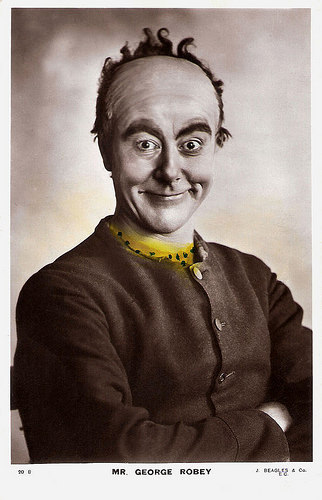
British postcard in the Rotary Photographic Series by Rotary Photo EC., no. 125 H.
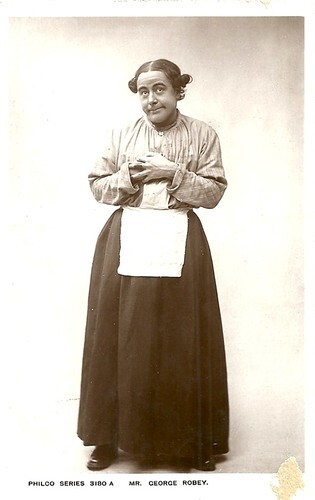
British postcard in the. Philco Series, no. 3180 a. A type of character Robey particularly enjoyed taking on was the 'pantomime dame', which historically was played by comedians from the music hall. Robey was inspired by the older comedians Dan Leno and Herbert Campbell, and, although post-dating them, he rivalled their eccentricity and popularity, earning the festive entertainment a new audience. In his 1972 biography of Robey, Neville Cardus thought that the comedian was "at his fullest as a pantomime Dame".
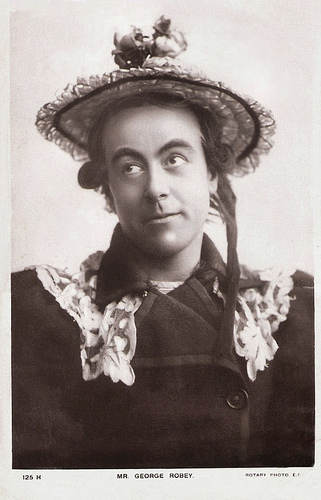
British postcard in the Rotary Photographic Series by Rotary Photo EC., no. 125 H.
Sancho Panza
George Robey starred in the revue 'Round in Fifty' in 1922, which earned him still wider notice. He returned to the cinema a further four times during 1923. The first two films were written to showcase his pantomime talents: One Arabian Night (Sinclair Hall, 1923) was a reworking of Aladdin and co-starred Lionelle Howard and Edward O'Neill. In Harlequinade (A.E. Coleby, 1923) visited the roots of pantomime. One of Robey's more notable film roles was Sancho Panza in Don Quixote (Maurice Elvey, 1923), for which he received a fee of £700 a week. The amount of time he spent working away from home led to the breakdown of his marriage, and he separated from Ethel in 1923. Except for his performances in revue and pantomime, he appeared as his Prime Minister of Mirth character in all the other entertainment media including variety, music hall and radio.
In the late 1920s Robey wrote and starred in two Phonofilm sound-on-film productions, Safety First (Hugh Croise, 1928) and Mrs. Mephistopheles (Hugh Croise, 1929). In 1932 Robey appeared in his first sound film, The Temperance Fête (Graham Cutts, 1932). It was followed by Marry Me (Wilhelm Thiele, 1932), starring German actress Renate Müller , which was one of the most successful musical films of his career. The film tells the story of a sound recordist in a gramophone company who romances a colleague when she becomes the family housekeeper. Robey continued to perform in variety theatre in the inter-war years and, in 1932, he starred in 'Helen!', his first straight theatre role. His appearance brought him to the attention of many influential directors, including Sydney Carroll, who signed him to appear on stage as Falstaff in Henry IV, Part 1 in 1935, a role that he later repeated in Laurence Olivier's film Henry V (1944).
Robey starred opposite Fritz Kortner and Anna May Wong in a film version of the hit musical Chu Chin Chow (Walter Forde, 1934). The New York Times called him "a lovable and laughable Ali Baba". In the summer of 1938, Robey appeared in the film A Girl Must Live (Carol Reed, 1939) in which he played the role of Horace Blount. A journalist for The Times opined that Robey's performance as an elderly furrier, the love interest of both Margaret Lockwood and Lilli Palmer , was "a perfect study in bewildered embarrassment".
During the Second World War, Robey raised money for charities and promoted recruitment into the forces. Robey starred in the film Salute John Citizen (Maurice Elvey, 1942), co-starring Edward Rigby and Stanley Holloway, about the effects that the war had on a normal British family. A further four films followed in 1943, one of which promoted war propaganda while the other two displayed the popular medium of cine-variety.
By the 1950s, his health had deteriorated, and he entered into semi-retirement. George Robey was knighted a few months before his death at his home in Saltdean, East Sussex, in 1954. He was 85. Robey was married twice. In 1898, Robey married his first wife, the Australian-born musical theatre actress Ethel Hayden. Ethel accompanied him on his tours and frequently starred alongside him. They had two children, a son Edward (1900) and a daughter Eileen. After his divorce from Ethel in 1938, he married Blanche Littler, who was more than two decades his junior.
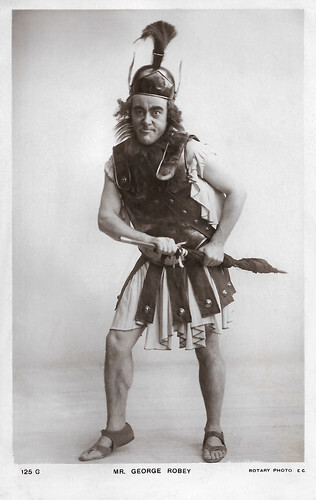
British postcard in the Rotary Photographic Series by Rotary Photo EC., no. 125 G. Sent by mail in 1906.
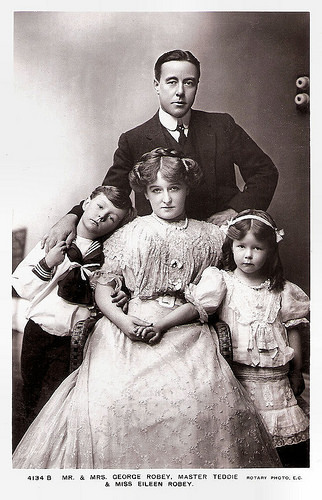
British postcard in the Rotary Photographic Series by Rotary Photo EC., no. 4134 B. Mr. and Mrs. George Robey, Master Teddie & Miss Eileen Robey.
Violet Lorraine and George Robey sing 'If You Were The Only Girl In The World' (1916). Source: gihiuh fvjjojo (YouTube).
George Robey and Thelma Tuson sing 'Any Time is Kissing Time' in Chu Chin Chow (1934). Source:
Sources: Wikipedia and .

British postcard by K LTD. Photo: Hana, London.

British postcard in the Philco Series by Rotary Photo EC., no. 3154 A. Photo: C. Ireland, Manchester. In 1902 Robey created the character The Prehistoric Man. He dressed as a caveman and spoke of modern political issues, often complaining about the government "slapping another pound of rock on his taxes". The character was received favourably by audiences, who found it easy to relate to his topical observations. That year he released The Prehistoric Man on a shellac disc using the early acoustic recording process.

British postcard. Photo: Wrather & Buys.
The Prime Minister of Mirth
George Robey was born as George Edward Wade in London in 1869. He came from a middle-class family. His father, Charles Wade, was a civil engineer who spent much of his career on tramline design and construction. Robey's mother, Elizabeth Mary Wade née Keene, was a housewife. After schooling in England and Germany and a series of office jobs, he made his debut on the London stage, at the age of 21, as the straight man to a comic hypnotist. He soon developed his own act and appeared at the Oxford Music Hall in 1890, where he earned favourable notices singing 'The Simple Pimple' and 'He'll Get It Where He's Gone to Now'.
In 1892, Robey appeared in his first pantomime, 'Whittington Up-to-date' in Brighton, which brought him to a wider audience. With Robey's popularity came an eagerness to differentiate himself from his music hall rivals, and so he devised a signature costume when appearing as himself: an oversized black coat fastened from the neck down with large, wooden buttons; black, unkempt, baggy trousers and a partially bald wig with black, whispery strands of unbrushed, dirty-looking hair that poked below a large, dishevelled top-hat. He applied thick white face paint and exaggerated the redness on his cheeks and nose with bright red makeup. His eyeline and eyebrows were also enhanced with thick, black grease paint. He held a short, misshaped, wooden walking stick, which was curved at the top.
George Robey later used the costume for his character, The Prime Minister of Mirth. The outfit helped Robey become instantly recognisable on the London music hall circuit. More provincial engagements followed in Manchester, Birmingham and Liverpool, and he soon became a mainstay of the popular Christmas pantomime scene. By the start of the new century, Robey was a big name in pantomime, and he was able to choose his roles. Pantomime enjoyed wide popularity until the 1890s, but by the time Robey had reached his peak, interest in it was on the wane. A type of character he particularly enjoyed taking on was the pantomime dame, which historically was played by comedians from the music hall. Robey was inspired by the older comedians Herbert Campbell and Dan Leno , and, although post-dating them, he rivalled their eccentricity and popularity, earning the festive entertainment a new audience. Robey's music hall act matured in the first decade of the 1900s, and he undertook several foreign tours. He starred in the Royal Command Performance in 1912 and regularly entertained before the aristocracy.
Robey made his film debut in 1900, according to IMDb . The short comedy The Rats (N.N., 1900) offered a brief glimpse of some of the greatest entertainers from the late Victorian and early Edwardian stage, including Dan Leno , Herbert Campbell and George Robey. In 1913, Robey appeared in two early sound shorts: And Very Nice Too (Walter R. Boots, 1913) and Good Queen Bess (Walter R. Boots, 1913), made in the Kinoplasticon process, where the film was synchronised with phonograph records. The next year, he tried to emulate his music hall colleagues Billy Merson and Charlie Austin, who had set up Homeland Films and found success with the Squibs film series starring Betty Balfour . Robey met filmmakers from the Burns Film Company, who engaged him in a silent short entitled George Robey Turns Anarchist, in which he played a character who fails to blow up the Houses of Parliament. George Robey's Day Off (1919) showed the comedian acting out his daily domestic routines to comic effect, but the picture failed at the box office.
Producers obviously did not know how best to apply Robey's stage talents to the film. He continued to appear sporadically in film throughout the rest of his career, never achieving more than a modest amount of success. By the First World War, music hall entertainment had fallen out of favour with audiences. Revue appealed to wartime audiences, and Robey decided to capitalise on the medium's popularity. He achieved great success in The Bing Boys Are Here (1916). He was cast as Lucius Bing opposite Violet Loraine, who played his love interest Emma. The couple duetted in the show's signature song If You Were the Only Girl (In the World), which became an international success. Robey raised money for many war charities and was appointed a CBE in 1919. From 1918, George Robey created sketches based on his Prime Minister of Mirth character and used a costume he had designed in the 1890s as a basis for the character's attire.

British postcard in the Rotary Photographic Series by Rotary Photo EC., no. 125 H.

British postcard in the. Philco Series, no. 3180 a. A type of character Robey particularly enjoyed taking on was the 'pantomime dame', which historically was played by comedians from the music hall. Robey was inspired by the older comedians Dan Leno and Herbert Campbell, and, although post-dating them, he rivalled their eccentricity and popularity, earning the festive entertainment a new audience. In his 1972 biography of Robey, Neville Cardus thought that the comedian was "at his fullest as a pantomime Dame".

British postcard in the Rotary Photographic Series by Rotary Photo EC., no. 125 H.
Sancho Panza
George Robey starred in the revue 'Round in Fifty' in 1922, which earned him still wider notice. He returned to the cinema a further four times during 1923. The first two films were written to showcase his pantomime talents: One Arabian Night (Sinclair Hall, 1923) was a reworking of Aladdin and co-starred Lionelle Howard and Edward O'Neill. In Harlequinade (A.E. Coleby, 1923) visited the roots of pantomime. One of Robey's more notable film roles was Sancho Panza in Don Quixote (Maurice Elvey, 1923), for which he received a fee of £700 a week. The amount of time he spent working away from home led to the breakdown of his marriage, and he separated from Ethel in 1923. Except for his performances in revue and pantomime, he appeared as his Prime Minister of Mirth character in all the other entertainment media including variety, music hall and radio.
In the late 1920s Robey wrote and starred in two Phonofilm sound-on-film productions, Safety First (Hugh Croise, 1928) and Mrs. Mephistopheles (Hugh Croise, 1929). In 1932 Robey appeared in his first sound film, The Temperance Fête (Graham Cutts, 1932). It was followed by Marry Me (Wilhelm Thiele, 1932), starring German actress Renate Müller , which was one of the most successful musical films of his career. The film tells the story of a sound recordist in a gramophone company who romances a colleague when she becomes the family housekeeper. Robey continued to perform in variety theatre in the inter-war years and, in 1932, he starred in 'Helen!', his first straight theatre role. His appearance brought him to the attention of many influential directors, including Sydney Carroll, who signed him to appear on stage as Falstaff in Henry IV, Part 1 in 1935, a role that he later repeated in Laurence Olivier's film Henry V (1944).
Robey starred opposite Fritz Kortner and Anna May Wong in a film version of the hit musical Chu Chin Chow (Walter Forde, 1934). The New York Times called him "a lovable and laughable Ali Baba". In the summer of 1938, Robey appeared in the film A Girl Must Live (Carol Reed, 1939) in which he played the role of Horace Blount. A journalist for The Times opined that Robey's performance as an elderly furrier, the love interest of both Margaret Lockwood and Lilli Palmer , was "a perfect study in bewildered embarrassment".
During the Second World War, Robey raised money for charities and promoted recruitment into the forces. Robey starred in the film Salute John Citizen (Maurice Elvey, 1942), co-starring Edward Rigby and Stanley Holloway, about the effects that the war had on a normal British family. A further four films followed in 1943, one of which promoted war propaganda while the other two displayed the popular medium of cine-variety.
By the 1950s, his health had deteriorated, and he entered into semi-retirement. George Robey was knighted a few months before his death at his home in Saltdean, East Sussex, in 1954. He was 85. Robey was married twice. In 1898, Robey married his first wife, the Australian-born musical theatre actress Ethel Hayden. Ethel accompanied him on his tours and frequently starred alongside him. They had two children, a son Edward (1900) and a daughter Eileen. After his divorce from Ethel in 1938, he married Blanche Littler, who was more than two decades his junior.

British postcard in the Rotary Photographic Series by Rotary Photo EC., no. 125 G. Sent by mail in 1906.

British postcard in the Rotary Photographic Series by Rotary Photo EC., no. 4134 B. Mr. and Mrs. George Robey, Master Teddie & Miss Eileen Robey.
Violet Lorraine and George Robey sing 'If You Were The Only Girl In The World' (1916). Source: gihiuh fvjjojo (YouTube).
George Robey and Thelma Tuson sing 'Any Time is Kissing Time' in Chu Chin Chow (1934). Source:
Sources: Wikipedia and .
Published on December 19, 2024 22:00
December 18, 2024
Ross Verlag, Part 15: Moderne Schönheitsgalerie
During the 1920s and 1930s, Ross Verlag in Berlin produced some colourful collector card series for several cigarette factories in Germany. 'Unsere Bunten Filmbilder' (Our Colourful Film Images) is a well-known example, 'Moderne Schönheitsgalerie' (Modern Beauty Gallery) is another one. Ross Verlag produced three series of 300 small cards for the Garbaty Cigarette Company as a supplement for their 'Edelzigarette' (precious cigarettes): 'Moderne Schönheitsgalerie' in 1934, 'Galerie Schöner Frauen Des Films' (Gallery of Beautiful Women in Film) in 1936, and Film-Lieblinge (Film Favourites) in 1937. These cigarette cards of glamorous female film stars from Hollywood and Germany are wonderful miniatures. Each card is in full colour, is embossed with an individual pattern, and has a varnish coat. We reproduce 15 of them, bigger-than-life.
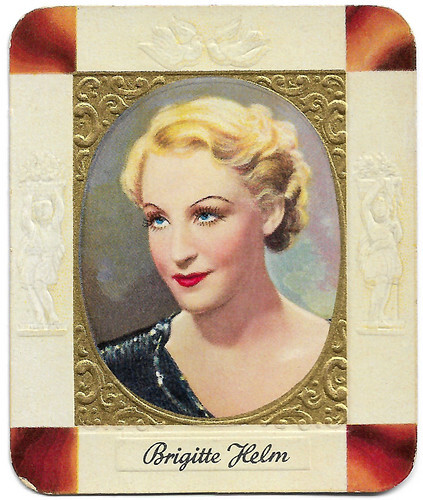
German collector card in the Moderne Schönheitsgalerie Series by Ross Verlag, no 6 (of 300). Photo: Ufa. The card was a supplement to 'Edelzigarette' Kurmark of the Garbaty Cigarette Company.
German actress Brigitte Helm (1908-1996) is still famous for her dual role as Maria and her double the evil Maria, the Maschinenmensch, in the silent SF classic Metropolis (Fritz Lang, 1927). After Metropolis she made a string of over 30 films in which she almost always had the starring role. She easily made the transition to sound films, before she abruptly retired in 1935.
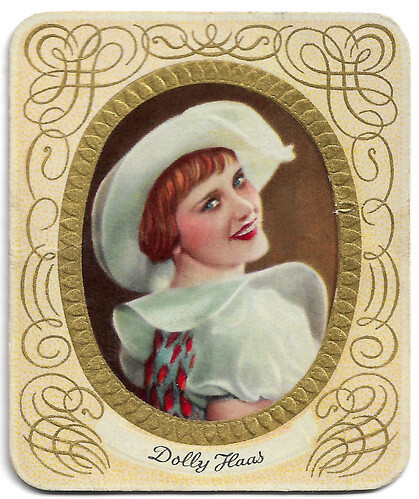
German collectors card in the Moderne Schönheitsgalerie by Ross Verlag for 'Edelzigarette' Kurmark of the Garbaty Cigarette Company, no. 55. Photo: Hisa-Film.
German-born, British stage and screen actress Dolly Haas (1910-1994) was popular in the 1930s as a vivacious, red-haired 'gamine' often wearing trousers in German and British films. Although she got a 3-year contract with Columbia and worked in Hollywood with Alfred Hitchcock, Dolly's American career mainly took place on and Off-Broadway.
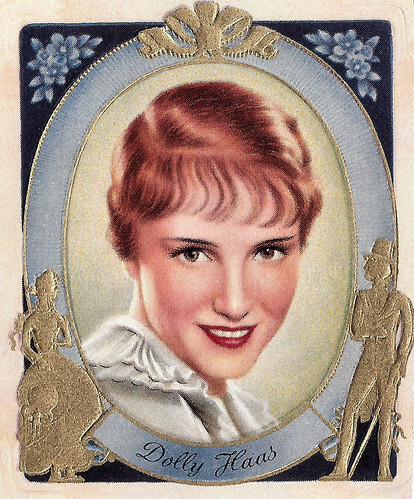
German collector card in the Moderne Schönheitsgalerie by Ross Verlag for 'Edelzigarette' Kurmark of the Garbaty Cigarette Company, no. 56. Photo: Dolly Haas in Warum lügt Fräulein Käthe?/Why is Miss Käthe lying? (Georg Jacoby, 1935).
The Jewish Garbaty Family
In the 1930s, the Nazi regime in Germany was not happy with Hollywood. One of the reasons was the Jewish background of many of the Hollywood studio moguls, another reason was the themes of the films.
However, American movies, and their stars, were quite popular with German audiences, and it wasn't until late in the decade that Hollywood studio product was heavily suppressed.
The Garbaty family, which had owned their cigarette firm for nearly half a century, was Jewish. In late 1938, the Nazis staged Kristallnacht, where several hundred Jews were murdered and their property seized.
Owner Moritz Garbaty hid out at the home of his Catholic secretary, and his wife and 8-year-old son Thomas were visited by the Gestapo, which was seeking his father.
Several days later, Moritz was reunited with his family. He sold the company for a fraction of its worth and left for America, securing the family's safety with a million-dollar bribe to authorities. The family survived in the USA.
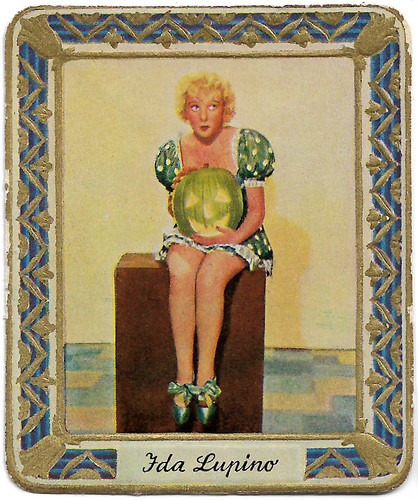
German collector card in the Moderne Schönheitsgalerie series by Ross Verlag for 'Edelzigarette' Kurmark of the Garbaty Cigarette Company, no. 142. Photo: Paramount.
Ida Lupino (1918-1995) was an English-American actress and singer, who became a pioneering director and producer — the only woman working within the 1950s Hollywood studio system to do so.
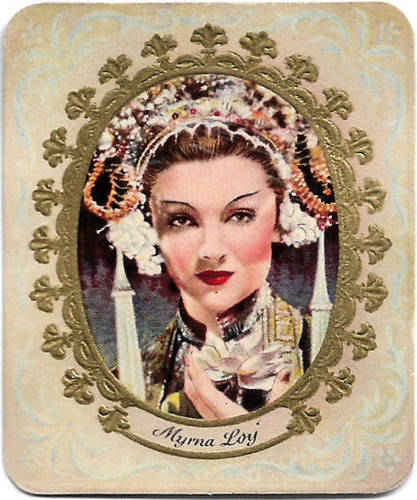
German collector card in the Moderne Schönheitsgalerie series, no. 149 (out of 300). The series was produced by Ross Verlag for the Garbaty Cigarette Company as a supplement for their 'Edelzigarette' Kurmark. Photo: Metro Goldwyn Mayer (M.G.M.). Myrna Loy in The Mask of Fu Manchu (Charles Brabin, 1932).
Myrna Loy (1905-1993) was an American film, television, and stage actress. She was originally typecast in exotic roles, often as a vamp or a woman of Asian descent, but her career prospects improved greatly following her portrayal of Nora Charles in The Thin Man (W.S. Van Dyke, 1934). Suddenly she was the 'Queen of the Movies' and remained so until the late 1940s.
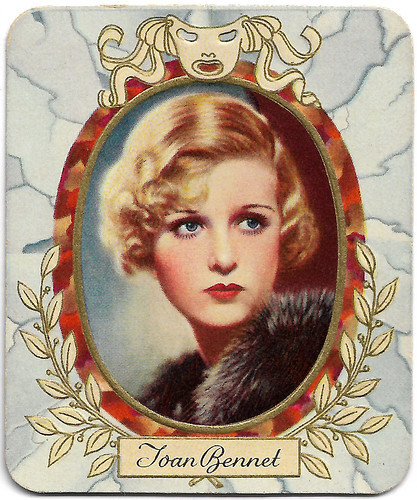
German collector card in the Moderne Schönheitsgalerie by Ross Verlag for the Garbaty Cigarette Company as a supplement for their 'Edelzigarette' Kurmark, no. 151 of 300. Photo: Fox.
Joan Bennett (1910–1990) was an American actress who had her breakthrough in Little Women (George Cukor, 1933). Producer Walter Wanger helped to manage her career and eventually married her in 1940. At the beginning of the 1940s, Bennett appeared in four films by Fritz Lang. These turned her into a femme fatale of the Film Noir.
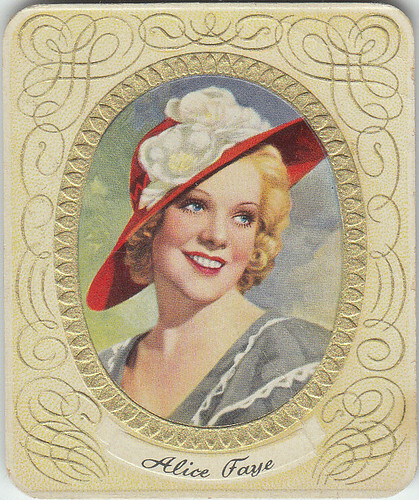
German collector card in the Moderne Schönheitsgalerie by Ross Verlag for the Garbaty Cigarette Company as a supplement for their 'Edelzigarette' Kurmark, no. 167 of 300. Collection: Marlène Pilaete.
In the second half of the 1930s and the first half of the 1940s, Alice Faye (1915-1998) was a name to reckon with in the world of Hollywood musicals. Her compelling voice, her remarkable ability to put over a song and her endearing screen persona made her a top star. In the U.S. Quigley’s Motion Picture Exhibitors’ Poll, which was the barometer of the stars’ box-office power, she placed 9th in 1938, 7th in 1939, 13th in 1940, 12th in 1941 and 1943 and 15th in 1944 (in 1942, she had been away from the screen).
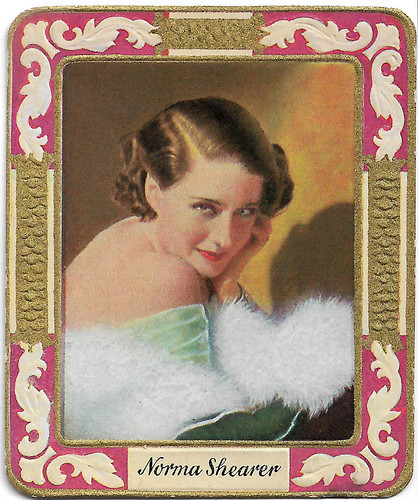
German cigarette card by Ross Verlag in the 'Moderne Schönheitsgalerie' series for the Garbaty Cigarette Company as a supplement for their 'Edelzigarette' Kurmark, no. 289. Photo: Metro-Goldwyn-Mayer (MGM).
American actress Norma Shearer (1902-1983) was the 'First Lady of MGM'. She often played spunky, sexually liberated ingenues, and was the first person to be nominated five times for an Academy Award for acting. Shearer won the Best Actress Oscar for The Divorcee (1930).
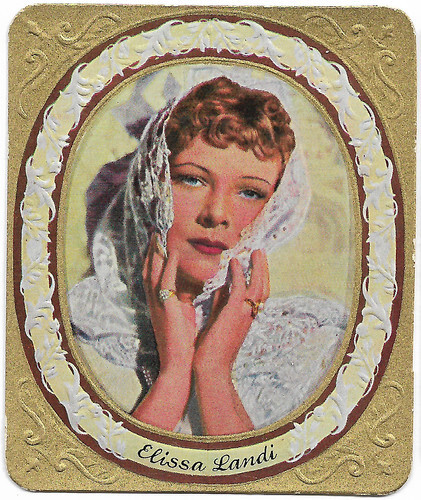
German collector card in the 'Moderne Schönheitsgalerie' by Ross Verlag for the Garbaty Cigarette Company as a supplement for their 'Edelzigarette' Kurmark, no 292 (of 300). Photo: Paramount.
Austrian-born actress and writer Elissa Landi (1904–1948) was (falsely) rumoured to be a descendant of Emperor Franz Joseph of Austria. During the 1920s, she appeared in British, French, and German films before travelling to the United States. In Hollywood, she became a popular star of the 1930s.
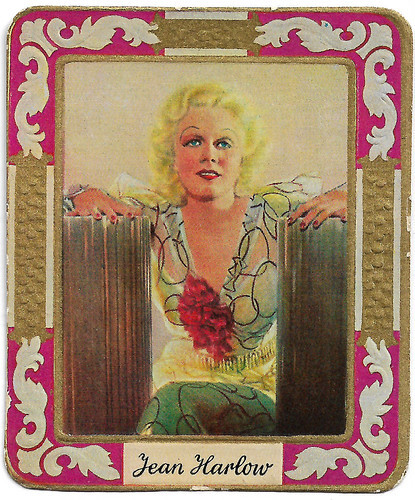
German collector card in the 'Moderne Schönheitsgalerie' by Ross Verlag for the Garbaty Cigarette Company as a supplement for their 'Edelzigarette' Kurmark, second series, no. 64 (of 300). Photo: Metro-Goldwyn-Mayer.
American film actress Jean Harlow (1911–1937) was with her come-hither body, platinum blonde hair, and keen sense of humour, one of Hollywood's sex symbols of the 1930s. She had her breakthrough in Howard Hughes' World War I epic Hell's Angels (1930). Frank Capra's Platinum Blonde (1931) cemented her role as America's new sex symbol. In 1932, she signed with Metro-Goldwyn-Mayer and became the leading lady in a string of hit films. These included Red Dust (1932), Dinner at Eight (1933), Reckless (1935) and Suzy (1936). Among her frequent co-stars were William Powell, Spencer Tracy and, in six films, Clark Gable.
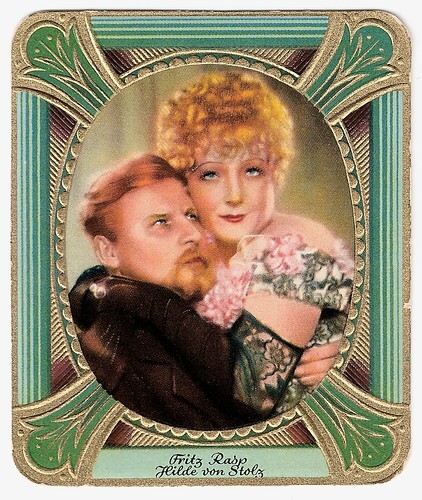
German collector card in the Moderne Schönheitsgalerie by Ross Verlag for the Garbaty Cigarette Company as a supplement for their 'Edelzigarette' Kurmark, series 2, no. 188. Fritz Rasp and Hilde von Stolz in Lockspitzel Asew/Decoy Asew (Phil Jutzi, 1935).
German film actor Fritz Rasp (1891–1976) appeared in 104 films between 1916 and 1976. He excelled in dark roles: villains, rapists, traitors. His most notable film parts were Der Schmale (The Thin Man) in Fritz Lang's Metropolis (1927), Meinert in Tagebuch einer Verlorenen/Diary of a Lost Girl (1929), and J. J. Peachum in Die 3-Groschen-Oper/The Threepenny Opera (1931). Hilde von Stolz (1903-1973) was a blonde Austrian leading lady and supporting actress in Ufa films of the 1930s and 1940s.
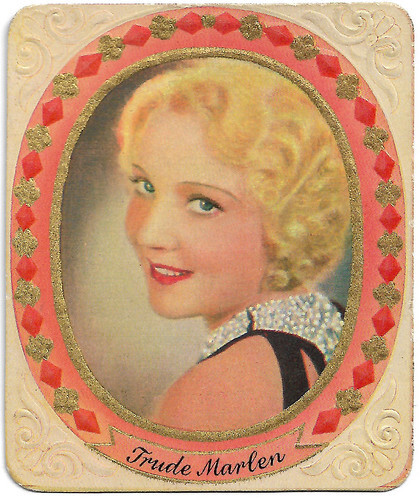
German collector card in the 'Moderne Schönheitsgalerie' by Ross Verlag for the Garbaty Cigarette Company as a supplement for their 'Edelzigarette' Kurmark, series 2, no. 255 of 300. Photo: Europa.
Trude Marlen (1912-2005), was a curly-locked Austrian leading lady of the 1930s. From 1933 until the 1940s, she made mostly light entertainment films as a Ufa star. Willi Forst was often her partner. The Ufa traded her as the German answer to Jean Harlow, but for the most part, she was rather the Viennese equivalent of the 'girl next door', engaging and uncomplicated.
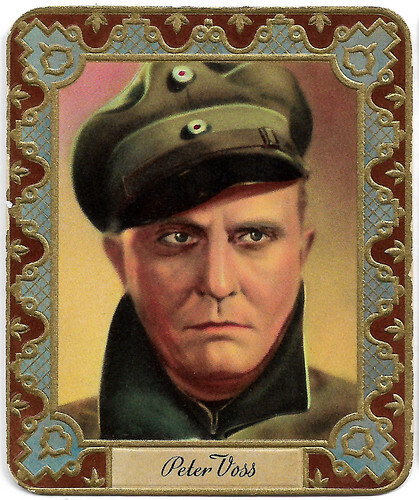
German collector card in the 'Moderne Schönheitsgalerie' by Ross Verlag for the Garbaty Cigarette Company as a supplement for their 'Edelzigarette' Kurmark, series 2, no. 257, issued by Kur Mark Cigarettes. Photo: Lloyd - Rota. Peter Voss in Mein Leben für Maria Isabell/My Life for Maria Isabella (Erich Waschneck, 1935).
Peter Voss (1891-1979) was a German character actor and occasional leading man. Following military service in World War I, he first appeared on stage. He was often seen as bon vivants, titled landowners or sea captains. Voss never quite established himself as a major star.
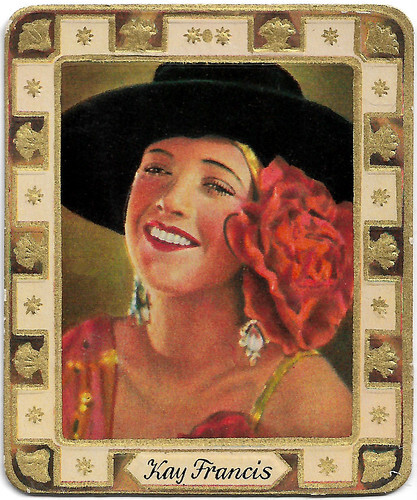
German collector card in the Moderne Schönheitsgalerie by Ross Verlag for the Garbaty Cigarette Company as a supplement for their 'Edelzigarette' Kurmark, series 2, no. 267 of 300. Photo: Paramount. Kay Francis as Carmen in the episode 'The Toreador' in Paramount on Parade (Edmund Goulding a.o., 1930).
American stage and film actress Kay Francis (1905-1968) was a tall, attractive, grey-eyed brunette with undeniable style and poise, known for films such as Ernst Lubitsch's Trouble in Paradise (1932). For a while, in the 1930s she ranked as one of America's most popular actresses, tagged the 'Queen of Warner Brothers'.
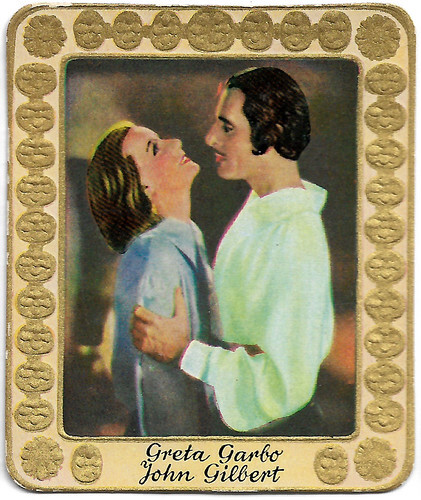
German collector card in the 'Galerie Schöner Frauen Des Films' (Gallery of Beautiful Women in Film) in 1936 by Ross Verlag for the Garbaty Cigarette Company as a supplement for their 'Edelzigarette' Kurmark, series 2, no. 47 (of 300). Photo: Metro-Goldwyn-Mayer. Greta Garbo and John Gilbert in Queen Christina (Rouben Mamoulian, 1933).
Swedish-born Greta Garbo (1905-1990) was one of the greatest and most glamorous film stars ever produced by the Hollywood studio system. She was part of the Golden Age of the silent cinema of the 1920s but Garbo was one of the few Hollywood actors who made a glorious transition to the talkies.
American actor, screenwriter, and director John Gilbert (1899-1936) rose to fame during the silent film era and became a popular leading man known as 'The Great Lover'. With Great Garbo, he began a highly publicised, torrid off-screen affair. The studio publicity department worked overtime to publicise the romance between the two. His career did not survive the arrival of sound film.
Sources: Virtual History, Carole & Co, and Garbo Forever.
Our Ross Verlag Tribute will be continued in 2025. In the meantime, please check out the Ross Verlag Movie Stars Postcards website.

German collector card in the Moderne Schönheitsgalerie Series by Ross Verlag, no 6 (of 300). Photo: Ufa. The card was a supplement to 'Edelzigarette' Kurmark of the Garbaty Cigarette Company.
German actress Brigitte Helm (1908-1996) is still famous for her dual role as Maria and her double the evil Maria, the Maschinenmensch, in the silent SF classic Metropolis (Fritz Lang, 1927). After Metropolis she made a string of over 30 films in which she almost always had the starring role. She easily made the transition to sound films, before she abruptly retired in 1935.

German collectors card in the Moderne Schönheitsgalerie by Ross Verlag for 'Edelzigarette' Kurmark of the Garbaty Cigarette Company, no. 55. Photo: Hisa-Film.
German-born, British stage and screen actress Dolly Haas (1910-1994) was popular in the 1930s as a vivacious, red-haired 'gamine' often wearing trousers in German and British films. Although she got a 3-year contract with Columbia and worked in Hollywood with Alfred Hitchcock, Dolly's American career mainly took place on and Off-Broadway.

German collector card in the Moderne Schönheitsgalerie by Ross Verlag for 'Edelzigarette' Kurmark of the Garbaty Cigarette Company, no. 56. Photo: Dolly Haas in Warum lügt Fräulein Käthe?/Why is Miss Käthe lying? (Georg Jacoby, 1935).
The Jewish Garbaty Family
In the 1930s, the Nazi regime in Germany was not happy with Hollywood. One of the reasons was the Jewish background of many of the Hollywood studio moguls, another reason was the themes of the films.
However, American movies, and their stars, were quite popular with German audiences, and it wasn't until late in the decade that Hollywood studio product was heavily suppressed.
The Garbaty family, which had owned their cigarette firm for nearly half a century, was Jewish. In late 1938, the Nazis staged Kristallnacht, where several hundred Jews were murdered and their property seized.
Owner Moritz Garbaty hid out at the home of his Catholic secretary, and his wife and 8-year-old son Thomas were visited by the Gestapo, which was seeking his father.
Several days later, Moritz was reunited with his family. He sold the company for a fraction of its worth and left for America, securing the family's safety with a million-dollar bribe to authorities. The family survived in the USA.

German collector card in the Moderne Schönheitsgalerie series by Ross Verlag for 'Edelzigarette' Kurmark of the Garbaty Cigarette Company, no. 142. Photo: Paramount.
Ida Lupino (1918-1995) was an English-American actress and singer, who became a pioneering director and producer — the only woman working within the 1950s Hollywood studio system to do so.

German collector card in the Moderne Schönheitsgalerie series, no. 149 (out of 300). The series was produced by Ross Verlag for the Garbaty Cigarette Company as a supplement for their 'Edelzigarette' Kurmark. Photo: Metro Goldwyn Mayer (M.G.M.). Myrna Loy in The Mask of Fu Manchu (Charles Brabin, 1932).
Myrna Loy (1905-1993) was an American film, television, and stage actress. She was originally typecast in exotic roles, often as a vamp or a woman of Asian descent, but her career prospects improved greatly following her portrayal of Nora Charles in The Thin Man (W.S. Van Dyke, 1934). Suddenly she was the 'Queen of the Movies' and remained so until the late 1940s.

German collector card in the Moderne Schönheitsgalerie by Ross Verlag for the Garbaty Cigarette Company as a supplement for their 'Edelzigarette' Kurmark, no. 151 of 300. Photo: Fox.
Joan Bennett (1910–1990) was an American actress who had her breakthrough in Little Women (George Cukor, 1933). Producer Walter Wanger helped to manage her career and eventually married her in 1940. At the beginning of the 1940s, Bennett appeared in four films by Fritz Lang. These turned her into a femme fatale of the Film Noir.

German collector card in the Moderne Schönheitsgalerie by Ross Verlag for the Garbaty Cigarette Company as a supplement for their 'Edelzigarette' Kurmark, no. 167 of 300. Collection: Marlène Pilaete.
In the second half of the 1930s and the first half of the 1940s, Alice Faye (1915-1998) was a name to reckon with in the world of Hollywood musicals. Her compelling voice, her remarkable ability to put over a song and her endearing screen persona made her a top star. In the U.S. Quigley’s Motion Picture Exhibitors’ Poll, which was the barometer of the stars’ box-office power, she placed 9th in 1938, 7th in 1939, 13th in 1940, 12th in 1941 and 1943 and 15th in 1944 (in 1942, she had been away from the screen).

German cigarette card by Ross Verlag in the 'Moderne Schönheitsgalerie' series for the Garbaty Cigarette Company as a supplement for their 'Edelzigarette' Kurmark, no. 289. Photo: Metro-Goldwyn-Mayer (MGM).
American actress Norma Shearer (1902-1983) was the 'First Lady of MGM'. She often played spunky, sexually liberated ingenues, and was the first person to be nominated five times for an Academy Award for acting. Shearer won the Best Actress Oscar for The Divorcee (1930).

German collector card in the 'Moderne Schönheitsgalerie' by Ross Verlag for the Garbaty Cigarette Company as a supplement for their 'Edelzigarette' Kurmark, no 292 (of 300). Photo: Paramount.
Austrian-born actress and writer Elissa Landi (1904–1948) was (falsely) rumoured to be a descendant of Emperor Franz Joseph of Austria. During the 1920s, she appeared in British, French, and German films before travelling to the United States. In Hollywood, she became a popular star of the 1930s.

German collector card in the 'Moderne Schönheitsgalerie' by Ross Verlag for the Garbaty Cigarette Company as a supplement for their 'Edelzigarette' Kurmark, second series, no. 64 (of 300). Photo: Metro-Goldwyn-Mayer.
American film actress Jean Harlow (1911–1937) was with her come-hither body, platinum blonde hair, and keen sense of humour, one of Hollywood's sex symbols of the 1930s. She had her breakthrough in Howard Hughes' World War I epic Hell's Angels (1930). Frank Capra's Platinum Blonde (1931) cemented her role as America's new sex symbol. In 1932, she signed with Metro-Goldwyn-Mayer and became the leading lady in a string of hit films. These included Red Dust (1932), Dinner at Eight (1933), Reckless (1935) and Suzy (1936). Among her frequent co-stars were William Powell, Spencer Tracy and, in six films, Clark Gable.

German collector card in the Moderne Schönheitsgalerie by Ross Verlag for the Garbaty Cigarette Company as a supplement for their 'Edelzigarette' Kurmark, series 2, no. 188. Fritz Rasp and Hilde von Stolz in Lockspitzel Asew/Decoy Asew (Phil Jutzi, 1935).
German film actor Fritz Rasp (1891–1976) appeared in 104 films between 1916 and 1976. He excelled in dark roles: villains, rapists, traitors. His most notable film parts were Der Schmale (The Thin Man) in Fritz Lang's Metropolis (1927), Meinert in Tagebuch einer Verlorenen/Diary of a Lost Girl (1929), and J. J. Peachum in Die 3-Groschen-Oper/The Threepenny Opera (1931). Hilde von Stolz (1903-1973) was a blonde Austrian leading lady and supporting actress in Ufa films of the 1930s and 1940s.

German collector card in the 'Moderne Schönheitsgalerie' by Ross Verlag for the Garbaty Cigarette Company as a supplement for their 'Edelzigarette' Kurmark, series 2, no. 255 of 300. Photo: Europa.
Trude Marlen (1912-2005), was a curly-locked Austrian leading lady of the 1930s. From 1933 until the 1940s, she made mostly light entertainment films as a Ufa star. Willi Forst was often her partner. The Ufa traded her as the German answer to Jean Harlow, but for the most part, she was rather the Viennese equivalent of the 'girl next door', engaging and uncomplicated.

German collector card in the 'Moderne Schönheitsgalerie' by Ross Verlag for the Garbaty Cigarette Company as a supplement for their 'Edelzigarette' Kurmark, series 2, no. 257, issued by Kur Mark Cigarettes. Photo: Lloyd - Rota. Peter Voss in Mein Leben für Maria Isabell/My Life for Maria Isabella (Erich Waschneck, 1935).
Peter Voss (1891-1979) was a German character actor and occasional leading man. Following military service in World War I, he first appeared on stage. He was often seen as bon vivants, titled landowners or sea captains. Voss never quite established himself as a major star.

German collector card in the Moderne Schönheitsgalerie by Ross Verlag for the Garbaty Cigarette Company as a supplement for their 'Edelzigarette' Kurmark, series 2, no. 267 of 300. Photo: Paramount. Kay Francis as Carmen in the episode 'The Toreador' in Paramount on Parade (Edmund Goulding a.o., 1930).
American stage and film actress Kay Francis (1905-1968) was a tall, attractive, grey-eyed brunette with undeniable style and poise, known for films such as Ernst Lubitsch's Trouble in Paradise (1932). For a while, in the 1930s she ranked as one of America's most popular actresses, tagged the 'Queen of Warner Brothers'.

German collector card in the 'Galerie Schöner Frauen Des Films' (Gallery of Beautiful Women in Film) in 1936 by Ross Verlag for the Garbaty Cigarette Company as a supplement for their 'Edelzigarette' Kurmark, series 2, no. 47 (of 300). Photo: Metro-Goldwyn-Mayer. Greta Garbo and John Gilbert in Queen Christina (Rouben Mamoulian, 1933).
Swedish-born Greta Garbo (1905-1990) was one of the greatest and most glamorous film stars ever produced by the Hollywood studio system. She was part of the Golden Age of the silent cinema of the 1920s but Garbo was one of the few Hollywood actors who made a glorious transition to the talkies.
American actor, screenwriter, and director John Gilbert (1899-1936) rose to fame during the silent film era and became a popular leading man known as 'The Great Lover'. With Great Garbo, he began a highly publicised, torrid off-screen affair. The studio publicity department worked overtime to publicise the romance between the two. His career did not survive the arrival of sound film.
Sources: Virtual History, Carole & Co, and Garbo Forever.
Our Ross Verlag Tribute will be continued in 2025. In the meantime, please check out the Ross Verlag Movie Stars Postcards website.
Published on December 18, 2024 22:00
December 17, 2024
D’ou viens tu Johnny (1963)
Johnny Hallyday (1943-2017) was the father of French Rock and Roll and a teenager idol with record-breaking crowds and mass hysteria. Like Elvis Presley, Hallyday's fame as a rock and roll heartthrob landed him parts in several films as the 'good bad boy'. D'où viens-tu, Johnny?/Where Are You From, Johnny? (Noel Howard, 1964) was his film debut. Johnny performs three solo songs and one duet with Sylvie Vartan.
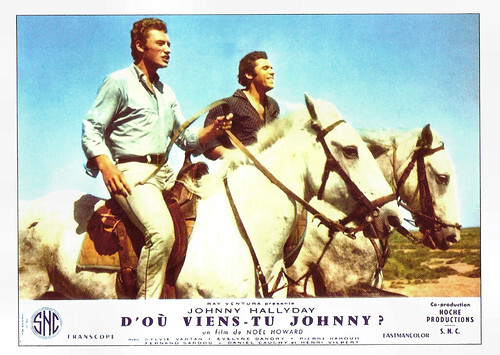
French postcard by Encyclopédie du Cinéma, no. EDC 546 Vis. 1. Photo: Johnny Hallyday in D'où viens-tu... Johnny?/Where Are You From, Johnny? (Noël Howard, 1963).
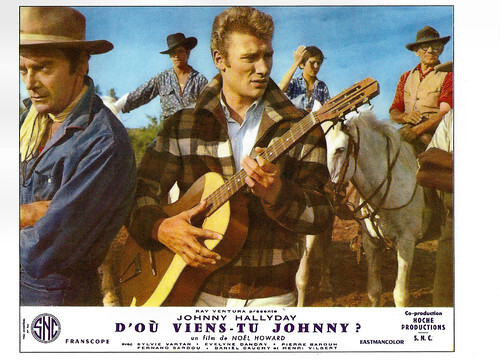
French postcard by Encyclopédie du Cinéma, no. EDC 547 Vis. 2. Photo: Johnny Hallyday and Sylvie Vartan in D'où viens-tu... Johnny?/Where Are You From, Johnny? (Noël Howard, 1963).
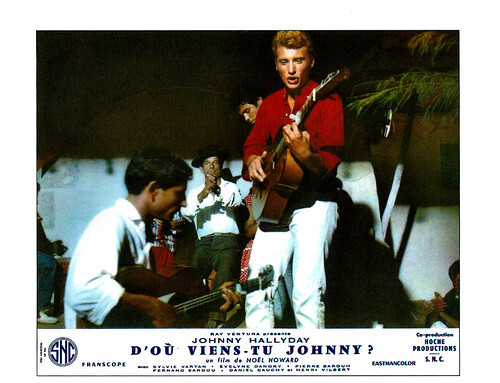
French postcard by Encyclopédie du Cinéma, no. EDC 548 Vis. 3. Photo: Johnny Hallyday in D'où viens-tu... Johnny?/Where Are You From, Johnny? (Noël Howard, 1963).
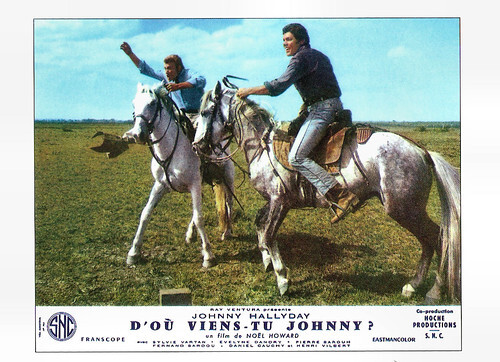
French postcard by Encyclopédie du Cinéma, no. EDC 550 Vis. 4. Photo: Johnny Hallyday in D'où viens-tu... Johnny?/Where Are You From, Johnny? (Noël Howard, 1963).
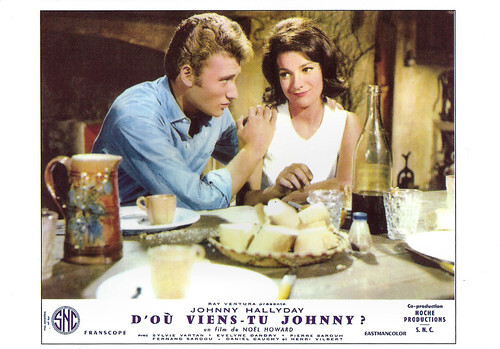
French postcard by Encyclopédie du Cinéma, no. EDC 551 Vis. 5. Photo: Johnny Hallyday and Evelyne Dandry in D'où viens-tu... Johnny?/Where Are You From, Johnny? (Noël Howard, 1963).
The good bad boy
In D'où viens-tu... Johnny?/Where Are You From, Johnny? (Noël Howard, 1963), Johnny Hallyday is Johnny Rivière, a young musician in Paris. Johnny enjoys life and is always in need of money. The young Parisian with a passion for rock ‘n’ roll and his musicians use the basement of a bar as a rehearsal room, in exchange for the small services he provides for the owner, Mr Franck. He does not know that Franck is working for the mafia. When he discovers that the men deal with drugs, Johnny throws them in the Seine. He flees to the Camargue, a region in southern France, where his uncle lives. Now, Johnny's pursued by two mafia killers but doesn't know it. In the wonderful landscape of the Camargue, he finds his uncle and his childhood love, but also an enemy, Django, and more trouble awaits him.
D'où viens-tu... Johnny?/Where Are You From, Johnny? (Noël Howard, 1963) started Johnny Hallyday 's relationship with the cinema. Johnny's girlfriend is played by his soon-to-be wife Sylvie Vartan whose performance is so dismal it's much fun to watch her. DB DuMonteil at IMDb : 'By no means a good film, by a long shot, Johnny's debut retains some freshness, whereas the rest of his cinematographic career - even when he was directed by more ambitious people like Costa-Gavras or Robert Hossein -can easily be dismissed.'
With D'où viens-tu... Johnny?/Where Are You From, Johnny? (1963), director Noël Howard tried to imitate the Elvis Presley features. The whole film's premise is to hear Johnny Hallyday sing and see him ride through the Camargue. By following Johnny from Paris to the Camargue, the film undergoes a visual metamorphosis, moving from black and white to colour. Cinematographer Walter Wottitz really created a Western atmosphere by emphasizing the beauty of the landscape in the Camargue. The Camargue in the south of France with its horses, its 'gardians' (French cowboys) and its wilderness fits the bill of a French Western quite well.
The cinematography and the songs are the highlights of the film. Since both Johnny and Sylvie Vartan were popular singers at the time, they got to interpret some songs. The four songs of the soundtrack are originals, composed by fellow yéyé singer Jean-Jacques Debout. They are quite pleasant, particularly the infectious 'Pour moi la vie va commencer' and the romantic ballad 'Rien n'a changé'. D'où viens-tu Johnny? was one of the biggest hits of 1963 at the French box office, coming 10th with 2,785,185 admissions.
Hallyday impersonated a character that was at the same time the role model of the disenchanted young and one respecting the morals of the older generation. This contradiction is the nature of the 'good bad boy'. He was good when facing the authorities, but bad before his fans, who searched for a counterpoint to their more conservative parents. In his essay, 'D'où viens-tu Johnny?, Le survivant mythique', essayist Olivier Mongin characterised Johnny Hallyday as a person full of contradictions. Hallyday loved appearing on the stage and on film despite his shy nature. According to Mongin, Johnny employed the persona of the 'good bad boy' as a facade to hide his real, sensitive character, marked by many pains.
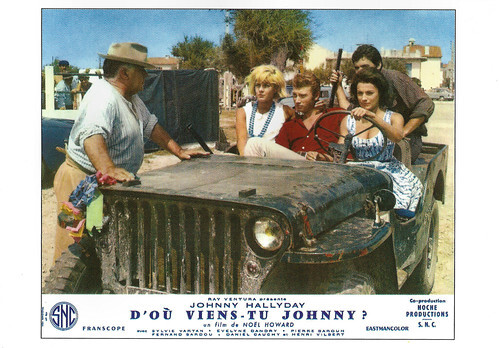
French postcard by Encyclopédie du Cinéma, no. EDC 552 Vis. 6. Photo: Johnny Hallyday and Sylvie Vartan in D'où viens-tu... Johnny?/Where Are You From, Johnny? (Noël Howard, 1963).
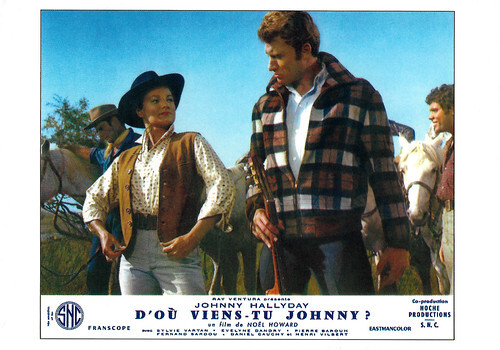
French postcard by Encyclopédie du Cinéma, no. EDC 541 Vis. 7. Photo: Johnny Hallyday and Evelyne Dandry in D'où viens-tu... Johnny?/Where Are You From, Johnny? (Noël Howard, 1963).
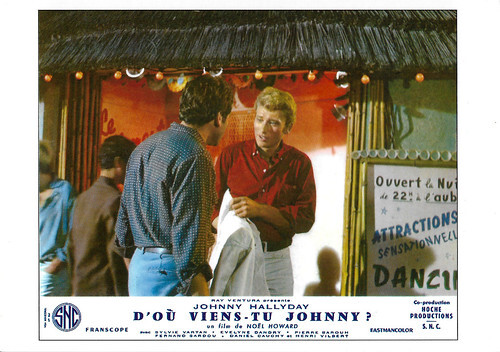
French postcard by Encyclopédie du Cinéma, no. EDC 542 Vis. 8. Photo: Johnny Hallyday and Evelyne Dandry in D'où viens-tu... Johnny?/Where Are You From, Johnny? (Noël Howard, 1963).
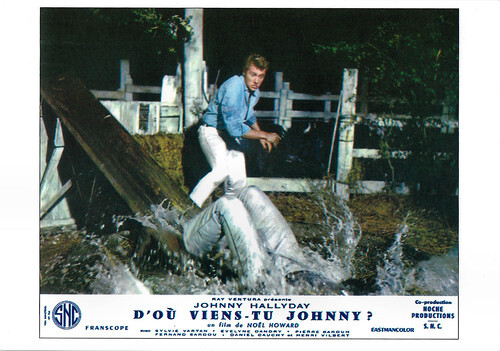
French postcard by Encyclopédie du Cinéma, no. EDC 543 Vis. 9. Photo: Johnny Hallyday and Pierre Barouh and Henri Vilbert in D'où viens-tu... Johnny?/Where Are You From, Johnny? (Noël Howard, 1963).
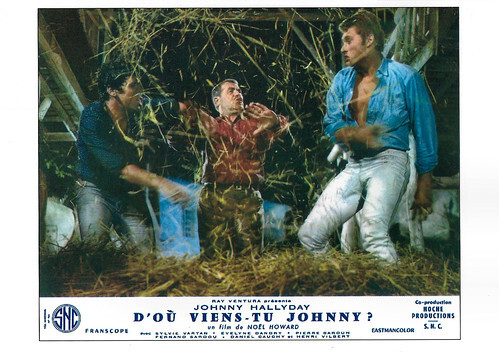
French postcard by Encyclopédie du Cinéma, no. EDC 544 Vis. 10. Photo: Johnny Hallyday and Pierre Barouh and Henri Vilbert in D'où viens-tu... Johnny?/Where Are You From, Johnny? (Noël Howard, 1963).
Sources: DB DuMonteil (IMDb), Wikipedia (French and English) and IMDb.

French postcard by Encyclopédie du Cinéma, no. EDC 546 Vis. 1. Photo: Johnny Hallyday in D'où viens-tu... Johnny?/Where Are You From, Johnny? (Noël Howard, 1963).

French postcard by Encyclopédie du Cinéma, no. EDC 547 Vis. 2. Photo: Johnny Hallyday and Sylvie Vartan in D'où viens-tu... Johnny?/Where Are You From, Johnny? (Noël Howard, 1963).

French postcard by Encyclopédie du Cinéma, no. EDC 548 Vis. 3. Photo: Johnny Hallyday in D'où viens-tu... Johnny?/Where Are You From, Johnny? (Noël Howard, 1963).

French postcard by Encyclopédie du Cinéma, no. EDC 550 Vis. 4. Photo: Johnny Hallyday in D'où viens-tu... Johnny?/Where Are You From, Johnny? (Noël Howard, 1963).

French postcard by Encyclopédie du Cinéma, no. EDC 551 Vis. 5. Photo: Johnny Hallyday and Evelyne Dandry in D'où viens-tu... Johnny?/Where Are You From, Johnny? (Noël Howard, 1963).
The good bad boy
In D'où viens-tu... Johnny?/Where Are You From, Johnny? (Noël Howard, 1963), Johnny Hallyday is Johnny Rivière, a young musician in Paris. Johnny enjoys life and is always in need of money. The young Parisian with a passion for rock ‘n’ roll and his musicians use the basement of a bar as a rehearsal room, in exchange for the small services he provides for the owner, Mr Franck. He does not know that Franck is working for the mafia. When he discovers that the men deal with drugs, Johnny throws them in the Seine. He flees to the Camargue, a region in southern France, where his uncle lives. Now, Johnny's pursued by two mafia killers but doesn't know it. In the wonderful landscape of the Camargue, he finds his uncle and his childhood love, but also an enemy, Django, and more trouble awaits him.
D'où viens-tu... Johnny?/Where Are You From, Johnny? (Noël Howard, 1963) started Johnny Hallyday 's relationship with the cinema. Johnny's girlfriend is played by his soon-to-be wife Sylvie Vartan whose performance is so dismal it's much fun to watch her. DB DuMonteil at IMDb : 'By no means a good film, by a long shot, Johnny's debut retains some freshness, whereas the rest of his cinematographic career - even when he was directed by more ambitious people like Costa-Gavras or Robert Hossein -can easily be dismissed.'
With D'où viens-tu... Johnny?/Where Are You From, Johnny? (1963), director Noël Howard tried to imitate the Elvis Presley features. The whole film's premise is to hear Johnny Hallyday sing and see him ride through the Camargue. By following Johnny from Paris to the Camargue, the film undergoes a visual metamorphosis, moving from black and white to colour. Cinematographer Walter Wottitz really created a Western atmosphere by emphasizing the beauty of the landscape in the Camargue. The Camargue in the south of France with its horses, its 'gardians' (French cowboys) and its wilderness fits the bill of a French Western quite well.
The cinematography and the songs are the highlights of the film. Since both Johnny and Sylvie Vartan were popular singers at the time, they got to interpret some songs. The four songs of the soundtrack are originals, composed by fellow yéyé singer Jean-Jacques Debout. They are quite pleasant, particularly the infectious 'Pour moi la vie va commencer' and the romantic ballad 'Rien n'a changé'. D'où viens-tu Johnny? was one of the biggest hits of 1963 at the French box office, coming 10th with 2,785,185 admissions.
Hallyday impersonated a character that was at the same time the role model of the disenchanted young and one respecting the morals of the older generation. This contradiction is the nature of the 'good bad boy'. He was good when facing the authorities, but bad before his fans, who searched for a counterpoint to their more conservative parents. In his essay, 'D'où viens-tu Johnny?, Le survivant mythique', essayist Olivier Mongin characterised Johnny Hallyday as a person full of contradictions. Hallyday loved appearing on the stage and on film despite his shy nature. According to Mongin, Johnny employed the persona of the 'good bad boy' as a facade to hide his real, sensitive character, marked by many pains.

French postcard by Encyclopédie du Cinéma, no. EDC 552 Vis. 6. Photo: Johnny Hallyday and Sylvie Vartan in D'où viens-tu... Johnny?/Where Are You From, Johnny? (Noël Howard, 1963).

French postcard by Encyclopédie du Cinéma, no. EDC 541 Vis. 7. Photo: Johnny Hallyday and Evelyne Dandry in D'où viens-tu... Johnny?/Where Are You From, Johnny? (Noël Howard, 1963).

French postcard by Encyclopédie du Cinéma, no. EDC 542 Vis. 8. Photo: Johnny Hallyday and Evelyne Dandry in D'où viens-tu... Johnny?/Where Are You From, Johnny? (Noël Howard, 1963).

French postcard by Encyclopédie du Cinéma, no. EDC 543 Vis. 9. Photo: Johnny Hallyday and Pierre Barouh and Henri Vilbert in D'où viens-tu... Johnny?/Where Are You From, Johnny? (Noël Howard, 1963).

French postcard by Encyclopédie du Cinéma, no. EDC 544 Vis. 10. Photo: Johnny Hallyday and Pierre Barouh and Henri Vilbert in D'où viens-tu... Johnny?/Where Are You From, Johnny? (Noël Howard, 1963).
Sources: DB DuMonteil (IMDb), Wikipedia (French and English) and IMDb.
Published on December 17, 2024 22:00
December 15, 2024
Spartacus (1960)
In Spartacus (1960), Kirk Douglas played his most famous role as the Thracian slave and rebel who led a revolt in the Roman empire in 73 B.C. The historical epic, written by blacklisted Dalton Trumbo, parallels 1950s American history with the House Committee on un-American Activities hearings and the civil rights movement. The film became a huge box-office success and won four Oscars. Although it is considered a classic, director Stanley Kubrick disowned the film. The clashes behind the scenes rivalled those in the film.
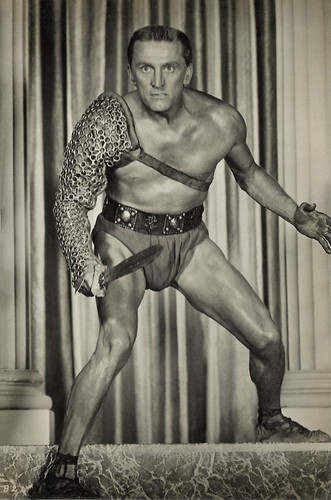
Spanish postcard by Archivo Bermejo, no. 7143. Photo: Universal International, 1960. Kirk Douglas in Spartacus (Stanley Kubrick, 1960).
[image error]
Yugoslavian postcard by Z.K., no. 1399. Tony Curtis in Spartacus (Stanley Kubrick, 1960).
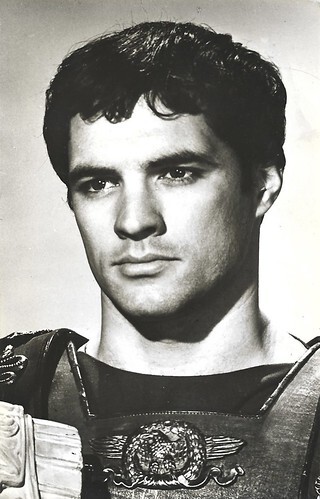
Spanish postcard by Archivo Bermejo, no. 7206. Photo: Universal International. John Gavin as Julius Caesar in Spartacus (Stanley Kubrick, 1960).
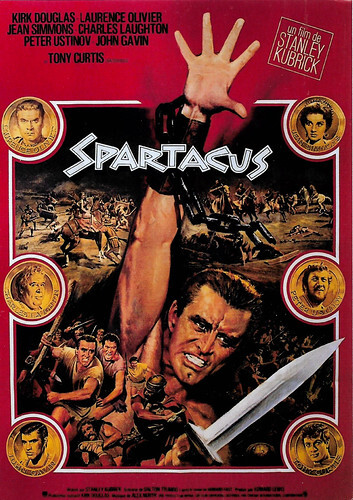
British postcard in the Cinema series. French affiche for Spartacus (Stanley Kubrick, 1960).
A very rebellious slave
Spartacus (Stanley Kubrick, 1960) is based on a novel by Howard Fast about the historical slave leader Spartacus. The story is situated in 73 B.C. The Roman Republic has slid into corruption, its menial work done by slaves. The hero is a Thracian slave working in a salt mine in Libya. Spartacus ( Kirk Douglas ) is known as a very rebellious person and after defending an older slave one day, he is sentenced to death by starvation.
Before that happens, however, Spartacus is spotted by Roman businessman Lentulus Batiatus (Peter Ustinov) who buys him with the plan to train him as a gladiator. Amid the abuse at the gladiatorial school, Spartacus forms a quiet relationship with Varinia ( Jean Simmons ), a serving woman whom he refuses to rape when she is sent to 'entertain' him in his cell. One day, the school is visited by wealthy Roman senator Marcus Licinius Crassus ( Laurence Olivier ), who aims to become the dictator of Rome. Crassus eventually buys Varinia, and for the amusement of his companions arranges for Spartacus and others to fight to the death. When Spartacus is disarmed, his opponent, an Ethiopian named Draba (Woody Strode), spares his life in a burst of defiance. Draba attacks the Roman audience, only to be speared in the back by a guard and killed by Crassus.
When Crassus then also takes Varinia as his slave, Spartacus has had enough. He calls on all the gladiators to revolt. Batiatus flees while the gladiators overwhelm their guards and escape into the countryside. Spartacus is elected chief of the fugitives and decides to lead them out of Italy and back to their homes. He starts training an army of slaves and gladiators, which soon grows to 70,000 men. The uprising soon spreads across the Italian Peninsula involving thousands of slaves. The slaves' plan is to acquire sufficient funds to buy ships from Silesian pirates who could then transport them to other lands from Brandisium in the south.
Spartacus is successful as his army wins one victory after another. He also finds Varinia again. The Roman Senate deployed all means to stop Spartacus' army. Every attempt fails and several Senate members retreat in shame over these defeats. The Roman Senate becomes increasingly alarmed as Spartacus defeats every army sent against him. Crassus' opponent the Roman Senator Gracchus ( Charles Laughton ) knows that his rival will try to use the crisis as a justification for seizing control of the Roman army. To try to prevent this, Gracchus channels as much military power as possible into the hands of his own protégé, the young senator Julius Caesar ( John Gavin ). Although Caesar lacks Crassus' contempt for the lower classes of Rome, he mistakes the man's rigid outlook for a patrician. Thus, when Gracchus reveals that he has bribed the Silesians to get Spartacus out of Italy and rid Rome of the slave army, Caesar regards such tactics as beneath him and goes over to Crassus.
Crassus uses a bribe of his own to make the pirates abandon Spartacus and has the Roman army secretly force the rebels away from the coastline towards Rome. Amid panic that Spartacus means to sack the city, the Senate gives Crassus absolute power. Now surrounded by Roman legions, Spartacus persuades his men to die fighting. Just by rebelling and proving themselves human, he says that they have struck a blow against slavery. In the ensuing battle, most of the slave army is massacred. The Romans try to locate the rebel leader for special punishment by offering a pardon (and return to enslavement) if the men identify Spartacus. Every surviving man responds by shouting "I'm Spartacus!". Crassus has them all sentenced to death by crucifixion along the Via Appia, where the revolt began.
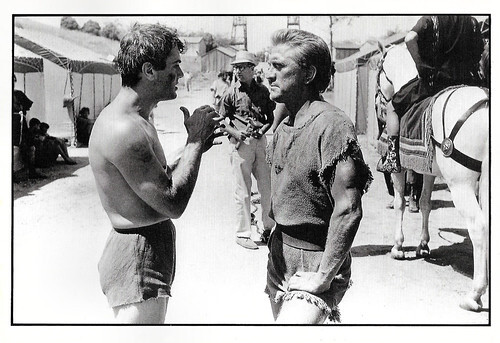
French postcard in the Entr'acte series by Éditions Asphodèle. Mâcon, no. 001/27. Photo: Tony Curtis and Kirk Douglas at the set of Spartacus (Stanley Kubrick, 1960). Caption: Tony Curtis and Kirk Douglas discuss a film shot.
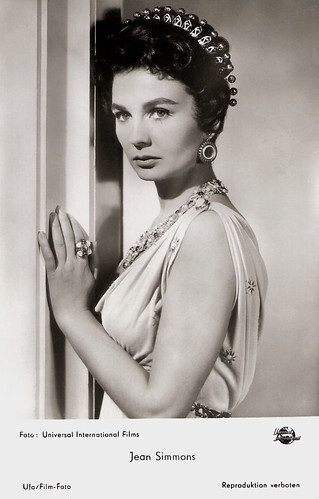
West German postcard by Ufa/Film-Foto, Berlin-Tempelhof, no. FK 4978. Photo: Universal International Films. Jean Simmons in Spartacus (Stanley Kubrick, 1960).
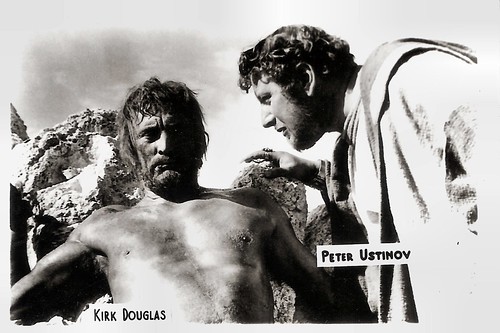
Romanian collectors card. Photo: Kirk Douglas and Peter Ustinov in Spartacus (Stanley Kubrick, 1960).
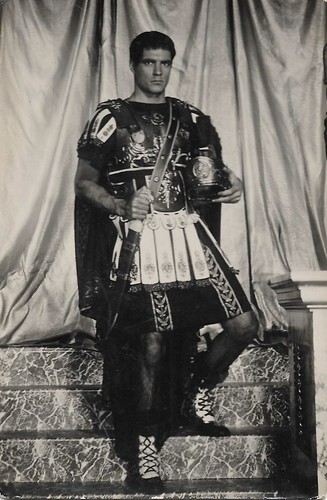
Spanish postcard by Archivo Bermejo, no. 7210. Photo: Universal International. John Gavin as Julius Caesar in the Technirama film Spartacus (Stanley Kubrick, 1960).
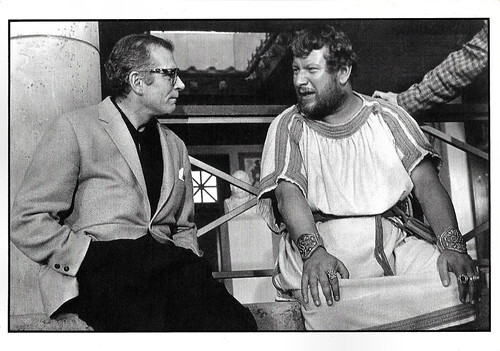
French postcard in the Entr'acte series by Éditions Asphodèle, Mâcon, no. 004/8. Photo: Collection B. Courtel / D.R. Laurence Olivier and Peter Ustinov on the set of Spartacus (Stanley Kubrick, 1960). Caption: Contrast of eras between the clothing of Laurence Olivier and that of the director and actor Peter Ustinov.
Clashes on the set
Kirk Douglas was the star of Spartacus (196O) and he was also the co-producer of the film through his company, Bryna Productions. Douglas had an unhappy time for most of the production. First, Douglas purchased the rights to Howard Fast's novel out of his own money. Universal agreed to finance the film after Douglas told them that he had secured Laurence Olivier , Charles Laughton and Peter Ustinov to appear in it. Author Howard Fast was originally hired to adapt his own novel as a screenplay, but he had difficulty working in the format. Douglas then insisted on hiring Dalton Trumbo to adapt the film against the wishes of the other producers. Trumbo had been blacklisted as one of the Hollywood 10, and intended to use the pseudonym 'Sam Jackson'. Trumbo had been jailed for contempt of Congress in 1950, after which he had survived by writing screenplays under assumed names. After the first week of shooting, Douglas had a major falling out with the original director, Anthony Mann. Mann was fired and according to Peter Ustinov, the salt mines sequence in the final film was the only footage shot by Mann. Douglas asked thirty-year-old Stanley Kubrick, with whom he had collaborated well three years previously on Paths of Glory (Stanley Kubrick, 1957), to direct. However, he had an equally difficult time working with Kubrick. Because he was only brought in at the last minute, Kubrick felt he had too little input in the final result and later disowned the film.
There were more clashes during production. Kubrick immediately fired Sabine Bethmann, who had only worked two days on the film. He and Douglas felt that she wasn't right for the role, so she was paid $3,000 to go home. Bethmann was replaced with Jean Simmons, who had been campaigning for the role. Saul Bass' main title sequence originally ran five minutes, but was cut to three and a half at Kubrick's insistence. Cinematographer Russell Metty walked off the set, complaining that Kubrick was not letting him do his job. Metty was used to directors allowing him to call his own shots with little oversight, while Kubrick was a professional photographer who had shot some of his previous films by himself. Subsequently, Kubrick did the majority of the cinematography work. Metty complained about this up until the release of the film and even, at one point, asked to have his name removed from the credits. However, because his name was in the credits when the film won the Academy Award for Best Cinematography, it was given to Metty, although he actually didn't shoot most of it. Kubrick spent $40,000 on the over-ten-acre gladiator camp set. On the side of the set that bordered the freeway, a 125-foot asbestos curtain was erected to film the burning of the camp, which was organised with collaboration from the Los Angeles Fire and Police Departments. Studio press materials state that 5,000 uniforms and seven tons of armour were borrowed from Italian museums and that every one of Hollywood's 187 stuntmen was trained in the gladiatorial rituals of combat to the death. The production used approximately 10,500 people. Eight thousand trained troops from the Spanish were used to double as the Roman infantry. Kubrick directed the armies from the top of specially constructed towers. In July 1959, Hollywood Reporter announced that the budget had "spiralled" from $5,000,000 to $9,000,000, and according to studio press materials, the final budget was $12,000,000.
The filming was also plagued by the conflicting visions of Kurbrick and screenwriter Dalton Trumbo. Kubrick complained that the character of Spartacus had no faults nor quirks, and was completely interchangeable with any other slave gladiator. As the blacklisted Trumbo wasn't allowed on the set, Kubrick could order re-writes without much opposition. The disagreements between Kubrick and Douglas got so bad that both men reportedly went into therapy together. After shooting, Kubrick was not allowed to be present during editing. This was the only occasion on which Kubrick did not exercise such control over one of his films. Dalton Trumbo still got his way. During the shooting, he was reportedly being smuggled into the studio several times under a blanket so that he could attend screenings of a rough cut of the film. This early version was deemed a disaster, and Trumbo made elaborate notes of what he perceived to be the problem with it. These notes were subsequently used to re-edit the film into its final form, which was well received. At first, the studio did not want to give the openly communist Trumbo screen credit for his screenplay. Douglas publicly announced that Trumbo was the screenwriter of Spartacus, and President John F. Kennedy crossed American Legion picket lines to view the film, helping to end blacklisting.
Universal Pictures' advertising campaign, which began in December 1959, declared that "1960 is the year of Spartacus." The world premiere was held on 22 September 1960, at the DeMille Theatre in New York City. The film parallels 1950s American history, specifically the House Committee on un-American Activities hearings and the civil rights movement. The hearings, where witnesses were ordered under penalty of imprisonment to 'name names' of supposed Communist sympathisers, closely resemble the climactic scene when the slaves, asked by Crassus to give up their leader by pointing him out from the multitude, each stand up to proclaim, "I am Spartacus". Author Howard Fast was jailed for his refusal to testify, and wrote the novel 'Spartacus' while in prison. The comment of how slavery was a central part of American history is pointed to in the beginning in the scenes featuring Draba and Spartacus. Draba, who denies the friendship of Spartacus claiming "gladiators can have no friends", sacrifices himself by attacking Crassus rather than killing Spartacus. This scene points to the fact that Americans are indebted to the suffering of black slaves, who played a major role in building the country - a fact then never mentioned in U.S. history books. The fight to end segregation and to promote the equality of African Americans is seen in the mixing of races within the gladiator school and in the army of Spartacus, where all fight for freedom.
Spartacus (1960) won four Academy Awards: Best Supporting Actor for Peter Ustinov, Best Cinematography, Best Art Direction and Best Costume Design. At the time of the film’s release, it was the biggest moneymaker in Universal Studios' history. Although the film was disowned by its director, Spartacus (1960) is now considered a classic. The original version included a scene where Marcus Licinius Crassus ( Laurence Olivier ) attempts to seduce the handsome slave Antoninus ( Tony Curtis ) in the bath. The Production Code Administration and the Legion of Decency both objected. At one point Geoffrey Shurlock, representing the censors, suggested it would help if the reference in the scene to a preference for oysters or snails was changed to truffles and artichokes. In the end, the scene was cut, but it was put back in for the 1991 restoration. However, the soundtrack had been lost in the meantime and the dialogue had to be dubbed. Tony Curtis was able to redo his lines, but Olivier had died. Joan Plowright, his widow, remembered that Anthony Hopkins had done a dead-on impression of Olivier and she mentioned this to the restoration team. They approached Hopkins and he agreed to voice Olivier's lines in that scene. Hopkins is thanked in the credits for the restored version. In 2017, Spartacus was selected for preservation in the United States National Film Registry by the Library of Congress as being "culturally, historically, or aesthetically significant".
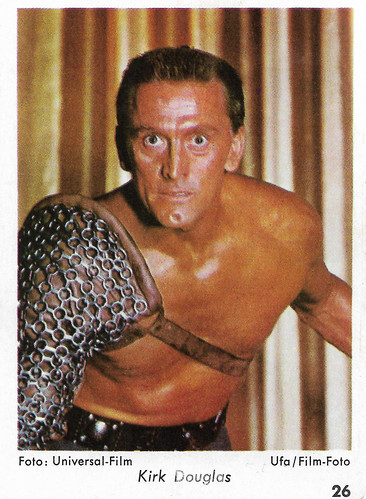
West German collector card by Ufa/Film-Foto, no. 26. Photo: Universal Film. Kirk Douglas in Spartacus (Stanley Kubrick, 1960).
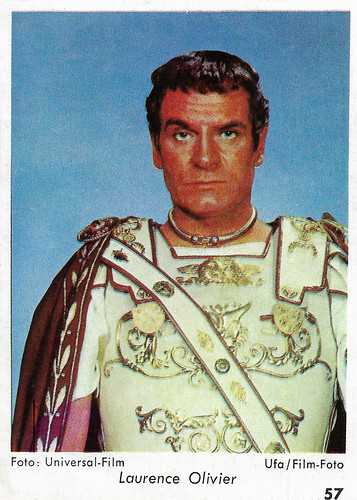
West German collector card by Ufa/Film-Foto, no. 57. Photo: Universal Film. Laurence Olivier in Spartacus (Stanley Kubrick, 1960).
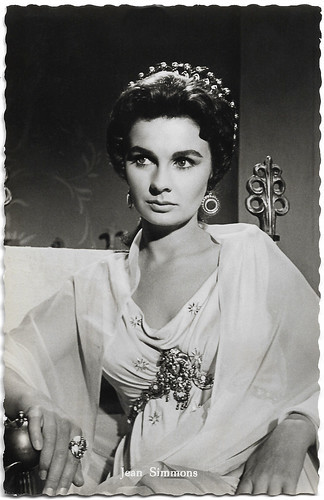
Dutch postcard, no. 860. Photo: Universal-Film. Jean Simmons in Spartacus (Stanley Kubrick, 1960). Collection: Geoffrey Donaldson Institute.
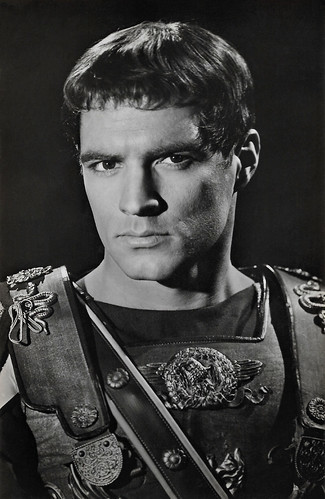
Spanish postcard by Archivo Bermejo, no. 7142. Photo: Universal International. John Gavin in Spartacus (Stanley Kubrick, 1960).
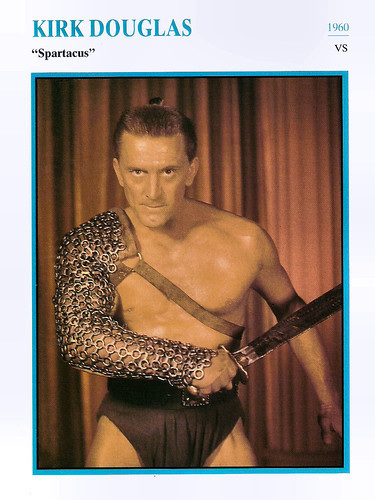
Dutch collectors card in the series 'Filmsterren: een Portret' by Edito Service, 1994. Photo: Collection Christophe L. Kirk Douglas in Spartacus (Stanley Kubrick, 1960).
Sources: Wikipedia (Dutch and English) and IMDb.

Spanish postcard by Archivo Bermejo, no. 7143. Photo: Universal International, 1960. Kirk Douglas in Spartacus (Stanley Kubrick, 1960).
[image error]
Yugoslavian postcard by Z.K., no. 1399. Tony Curtis in Spartacus (Stanley Kubrick, 1960).

Spanish postcard by Archivo Bermejo, no. 7206. Photo: Universal International. John Gavin as Julius Caesar in Spartacus (Stanley Kubrick, 1960).

British postcard in the Cinema series. French affiche for Spartacus (Stanley Kubrick, 1960).
A very rebellious slave
Spartacus (Stanley Kubrick, 1960) is based on a novel by Howard Fast about the historical slave leader Spartacus. The story is situated in 73 B.C. The Roman Republic has slid into corruption, its menial work done by slaves. The hero is a Thracian slave working in a salt mine in Libya. Spartacus ( Kirk Douglas ) is known as a very rebellious person and after defending an older slave one day, he is sentenced to death by starvation.
Before that happens, however, Spartacus is spotted by Roman businessman Lentulus Batiatus (Peter Ustinov) who buys him with the plan to train him as a gladiator. Amid the abuse at the gladiatorial school, Spartacus forms a quiet relationship with Varinia ( Jean Simmons ), a serving woman whom he refuses to rape when she is sent to 'entertain' him in his cell. One day, the school is visited by wealthy Roman senator Marcus Licinius Crassus ( Laurence Olivier ), who aims to become the dictator of Rome. Crassus eventually buys Varinia, and for the amusement of his companions arranges for Spartacus and others to fight to the death. When Spartacus is disarmed, his opponent, an Ethiopian named Draba (Woody Strode), spares his life in a burst of defiance. Draba attacks the Roman audience, only to be speared in the back by a guard and killed by Crassus.
When Crassus then also takes Varinia as his slave, Spartacus has had enough. He calls on all the gladiators to revolt. Batiatus flees while the gladiators overwhelm their guards and escape into the countryside. Spartacus is elected chief of the fugitives and decides to lead them out of Italy and back to their homes. He starts training an army of slaves and gladiators, which soon grows to 70,000 men. The uprising soon spreads across the Italian Peninsula involving thousands of slaves. The slaves' plan is to acquire sufficient funds to buy ships from Silesian pirates who could then transport them to other lands from Brandisium in the south.
Spartacus is successful as his army wins one victory after another. He also finds Varinia again. The Roman Senate deployed all means to stop Spartacus' army. Every attempt fails and several Senate members retreat in shame over these defeats. The Roman Senate becomes increasingly alarmed as Spartacus defeats every army sent against him. Crassus' opponent the Roman Senator Gracchus ( Charles Laughton ) knows that his rival will try to use the crisis as a justification for seizing control of the Roman army. To try to prevent this, Gracchus channels as much military power as possible into the hands of his own protégé, the young senator Julius Caesar ( John Gavin ). Although Caesar lacks Crassus' contempt for the lower classes of Rome, he mistakes the man's rigid outlook for a patrician. Thus, when Gracchus reveals that he has bribed the Silesians to get Spartacus out of Italy and rid Rome of the slave army, Caesar regards such tactics as beneath him and goes over to Crassus.
Crassus uses a bribe of his own to make the pirates abandon Spartacus and has the Roman army secretly force the rebels away from the coastline towards Rome. Amid panic that Spartacus means to sack the city, the Senate gives Crassus absolute power. Now surrounded by Roman legions, Spartacus persuades his men to die fighting. Just by rebelling and proving themselves human, he says that they have struck a blow against slavery. In the ensuing battle, most of the slave army is massacred. The Romans try to locate the rebel leader for special punishment by offering a pardon (and return to enslavement) if the men identify Spartacus. Every surviving man responds by shouting "I'm Spartacus!". Crassus has them all sentenced to death by crucifixion along the Via Appia, where the revolt began.

French postcard in the Entr'acte series by Éditions Asphodèle. Mâcon, no. 001/27. Photo: Tony Curtis and Kirk Douglas at the set of Spartacus (Stanley Kubrick, 1960). Caption: Tony Curtis and Kirk Douglas discuss a film shot.

West German postcard by Ufa/Film-Foto, Berlin-Tempelhof, no. FK 4978. Photo: Universal International Films. Jean Simmons in Spartacus (Stanley Kubrick, 1960).

Romanian collectors card. Photo: Kirk Douglas and Peter Ustinov in Spartacus (Stanley Kubrick, 1960).

Spanish postcard by Archivo Bermejo, no. 7210. Photo: Universal International. John Gavin as Julius Caesar in the Technirama film Spartacus (Stanley Kubrick, 1960).

French postcard in the Entr'acte series by Éditions Asphodèle, Mâcon, no. 004/8. Photo: Collection B. Courtel / D.R. Laurence Olivier and Peter Ustinov on the set of Spartacus (Stanley Kubrick, 1960). Caption: Contrast of eras between the clothing of Laurence Olivier and that of the director and actor Peter Ustinov.
Clashes on the set
Kirk Douglas was the star of Spartacus (196O) and he was also the co-producer of the film through his company, Bryna Productions. Douglas had an unhappy time for most of the production. First, Douglas purchased the rights to Howard Fast's novel out of his own money. Universal agreed to finance the film after Douglas told them that he had secured Laurence Olivier , Charles Laughton and Peter Ustinov to appear in it. Author Howard Fast was originally hired to adapt his own novel as a screenplay, but he had difficulty working in the format. Douglas then insisted on hiring Dalton Trumbo to adapt the film against the wishes of the other producers. Trumbo had been blacklisted as one of the Hollywood 10, and intended to use the pseudonym 'Sam Jackson'. Trumbo had been jailed for contempt of Congress in 1950, after which he had survived by writing screenplays under assumed names. After the first week of shooting, Douglas had a major falling out with the original director, Anthony Mann. Mann was fired and according to Peter Ustinov, the salt mines sequence in the final film was the only footage shot by Mann. Douglas asked thirty-year-old Stanley Kubrick, with whom he had collaborated well three years previously on Paths of Glory (Stanley Kubrick, 1957), to direct. However, he had an equally difficult time working with Kubrick. Because he was only brought in at the last minute, Kubrick felt he had too little input in the final result and later disowned the film.
There were more clashes during production. Kubrick immediately fired Sabine Bethmann, who had only worked two days on the film. He and Douglas felt that she wasn't right for the role, so she was paid $3,000 to go home. Bethmann was replaced with Jean Simmons, who had been campaigning for the role. Saul Bass' main title sequence originally ran five minutes, but was cut to three and a half at Kubrick's insistence. Cinematographer Russell Metty walked off the set, complaining that Kubrick was not letting him do his job. Metty was used to directors allowing him to call his own shots with little oversight, while Kubrick was a professional photographer who had shot some of his previous films by himself. Subsequently, Kubrick did the majority of the cinematography work. Metty complained about this up until the release of the film and even, at one point, asked to have his name removed from the credits. However, because his name was in the credits when the film won the Academy Award for Best Cinematography, it was given to Metty, although he actually didn't shoot most of it. Kubrick spent $40,000 on the over-ten-acre gladiator camp set. On the side of the set that bordered the freeway, a 125-foot asbestos curtain was erected to film the burning of the camp, which was organised with collaboration from the Los Angeles Fire and Police Departments. Studio press materials state that 5,000 uniforms and seven tons of armour were borrowed from Italian museums and that every one of Hollywood's 187 stuntmen was trained in the gladiatorial rituals of combat to the death. The production used approximately 10,500 people. Eight thousand trained troops from the Spanish were used to double as the Roman infantry. Kubrick directed the armies from the top of specially constructed towers. In July 1959, Hollywood Reporter announced that the budget had "spiralled" from $5,000,000 to $9,000,000, and according to studio press materials, the final budget was $12,000,000.
The filming was also plagued by the conflicting visions of Kurbrick and screenwriter Dalton Trumbo. Kubrick complained that the character of Spartacus had no faults nor quirks, and was completely interchangeable with any other slave gladiator. As the blacklisted Trumbo wasn't allowed on the set, Kubrick could order re-writes without much opposition. The disagreements between Kubrick and Douglas got so bad that both men reportedly went into therapy together. After shooting, Kubrick was not allowed to be present during editing. This was the only occasion on which Kubrick did not exercise such control over one of his films. Dalton Trumbo still got his way. During the shooting, he was reportedly being smuggled into the studio several times under a blanket so that he could attend screenings of a rough cut of the film. This early version was deemed a disaster, and Trumbo made elaborate notes of what he perceived to be the problem with it. These notes were subsequently used to re-edit the film into its final form, which was well received. At first, the studio did not want to give the openly communist Trumbo screen credit for his screenplay. Douglas publicly announced that Trumbo was the screenwriter of Spartacus, and President John F. Kennedy crossed American Legion picket lines to view the film, helping to end blacklisting.
Universal Pictures' advertising campaign, which began in December 1959, declared that "1960 is the year of Spartacus." The world premiere was held on 22 September 1960, at the DeMille Theatre in New York City. The film parallels 1950s American history, specifically the House Committee on un-American Activities hearings and the civil rights movement. The hearings, where witnesses were ordered under penalty of imprisonment to 'name names' of supposed Communist sympathisers, closely resemble the climactic scene when the slaves, asked by Crassus to give up their leader by pointing him out from the multitude, each stand up to proclaim, "I am Spartacus". Author Howard Fast was jailed for his refusal to testify, and wrote the novel 'Spartacus' while in prison. The comment of how slavery was a central part of American history is pointed to in the beginning in the scenes featuring Draba and Spartacus. Draba, who denies the friendship of Spartacus claiming "gladiators can have no friends", sacrifices himself by attacking Crassus rather than killing Spartacus. This scene points to the fact that Americans are indebted to the suffering of black slaves, who played a major role in building the country - a fact then never mentioned in U.S. history books. The fight to end segregation and to promote the equality of African Americans is seen in the mixing of races within the gladiator school and in the army of Spartacus, where all fight for freedom.
Spartacus (1960) won four Academy Awards: Best Supporting Actor for Peter Ustinov, Best Cinematography, Best Art Direction and Best Costume Design. At the time of the film’s release, it was the biggest moneymaker in Universal Studios' history. Although the film was disowned by its director, Spartacus (1960) is now considered a classic. The original version included a scene where Marcus Licinius Crassus ( Laurence Olivier ) attempts to seduce the handsome slave Antoninus ( Tony Curtis ) in the bath. The Production Code Administration and the Legion of Decency both objected. At one point Geoffrey Shurlock, representing the censors, suggested it would help if the reference in the scene to a preference for oysters or snails was changed to truffles and artichokes. In the end, the scene was cut, but it was put back in for the 1991 restoration. However, the soundtrack had been lost in the meantime and the dialogue had to be dubbed. Tony Curtis was able to redo his lines, but Olivier had died. Joan Plowright, his widow, remembered that Anthony Hopkins had done a dead-on impression of Olivier and she mentioned this to the restoration team. They approached Hopkins and he agreed to voice Olivier's lines in that scene. Hopkins is thanked in the credits for the restored version. In 2017, Spartacus was selected for preservation in the United States National Film Registry by the Library of Congress as being "culturally, historically, or aesthetically significant".

West German collector card by Ufa/Film-Foto, no. 26. Photo: Universal Film. Kirk Douglas in Spartacus (Stanley Kubrick, 1960).

West German collector card by Ufa/Film-Foto, no. 57. Photo: Universal Film. Laurence Olivier in Spartacus (Stanley Kubrick, 1960).

Dutch postcard, no. 860. Photo: Universal-Film. Jean Simmons in Spartacus (Stanley Kubrick, 1960). Collection: Geoffrey Donaldson Institute.

Spanish postcard by Archivo Bermejo, no. 7142. Photo: Universal International. John Gavin in Spartacus (Stanley Kubrick, 1960).

Dutch collectors card in the series 'Filmsterren: een Portret' by Edito Service, 1994. Photo: Collection Christophe L. Kirk Douglas in Spartacus (Stanley Kubrick, 1960).
Sources: Wikipedia (Dutch and English) and IMDb.
Published on December 15, 2024 22:00
December 14, 2024
George Brent
George Brent (1904- 1979) was an Irish-born actor who was mainly active in American cinema in the 1930s and 1940s. He was the favourite leading man of Bette Davis and they were onscreen paired eleven times in such classics as Jezebel (1938) and Dark Victory (1939).
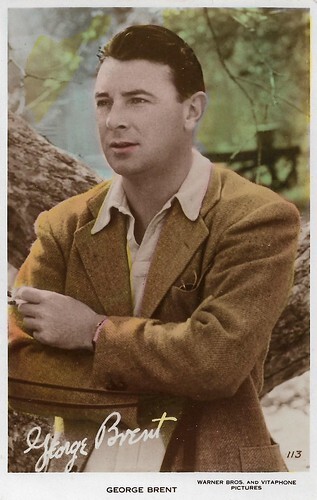
British postcard by Art Photo, no. 113 / 37-I. Photo: Warner Bros. and Vitaphone Pictures.
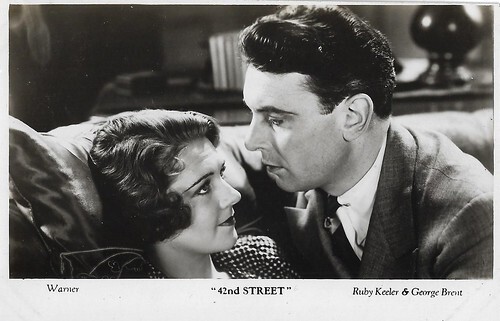
British postcard in the Film Shots series by Film Weekly. Photo: Warner Bros. George Brent and Ruby Keeler in 42nd Street (Lloyd Bacon, 1933).
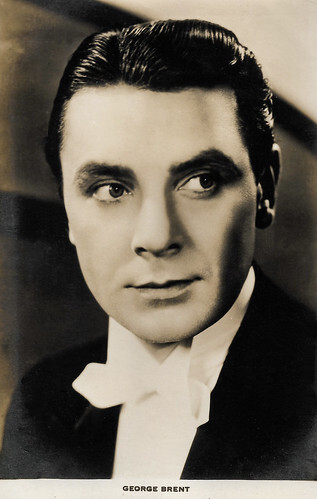
British postcard in the Film Weekly Series, London, no. 2.
An errand boy for the IRA
George Brent was born George Brendan Nolan in 1904 in Ballinasloe, a small village in County Roscommon, Ireland. He was the son of John J. Nolan and Mary (née McGuinness) Nolan. His father was a shopkeeper (according to some sources a British Army officer). In September 1915, George moved with his younger sister Kathleen to New York City. There, they joined their mother, who was living in the US after her separation from her husband. Again according to some sources, both his parents had died and he moved to his aunt in the US.
There are many discrepancies regarding Brent's year of birth, life, and activities during the 1919 to 1922 period. According to Dutch Wikipedia , he later returned to study at Dublin University. In 1921, at the time of the Irish War of Independence, Brent was part of the IRA. In his later life, he claimed to have been active only as an errand boy for Irish revolutionary, soldier and politician Michael Collins.
During this period he also became involved with the Abbey Theatre. He fled Ireland, travelled from England to Canada and returned to the United States in August 1921. He decided to become a professional actor. He made his Broadway debut in director Guthrie McClintic’s ‘The Dover Road’. He did numerous plays throughout the 1920s, including running several of his own stock companies.
He appeared in productions of ‘Abie's Irish Rose’ (on tour for two years), ‘Stella Dallas’, ‘Up in Mabel's Room’, ‘Elmer the Great’, ‘Seventh Heaven’, ‘White Cargo’ and ‘Lilac Time’. He acted in stock companies at Elitch Theatre, in Denver, Colorado (1929), as well as Rhode Island, Florida, and Massachusetts. In 1930, he appeared on Broadway in ‘Love, Honor, and Betray’, alongside Clark Gable .
George Brent took up residence in Hollywood sometime later to focus on a film career. He debuted for Fox Film Corporation with a supporting role in the musical drama Under Suspicion (A. F. Erickson, 1930), starring J. Harold Murray and Lois Moran. He continued in supporting roles for Fox in Once a Sinner (Guthrie McClintic, 1931) with Dorothy Mackaill and Joel McCrea , the Western Fair Warning (Alfred L. Werker, 1931) starring George O’Brien , and Charlie Chan Carries On (Hamilton MacFadden, 1931) with the first appearance of Warner Oland as Charlie Chan.
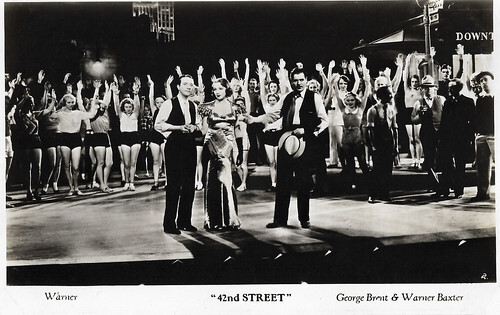
British postcard in the Film Shots series by Film Weekly. Photo: Warner Bros. Publicity still for 42nd Street (Lloyd Bacon, 1933) with George Brent, Bebe Daniels and Warren Baxter .
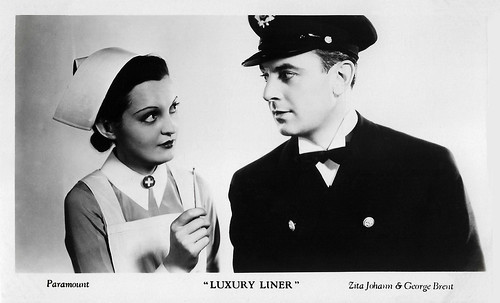
British postcard in the Film Shots series by Film Weekly. Photo: Paramount. Zita Johann and George Brent in Luxury Liner (Lothar Mendes, 1933).
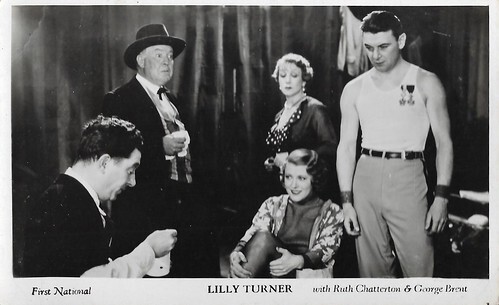
British postcard in the Film Shots series by Film Weekly. Photo: First National Films. Ruth Chatterton, George Brent (right), Marjorie Gateson, Guy Kibbee and Frank McHugh in the American pre-code movie Lilly Turner (William Wellman, 1933).
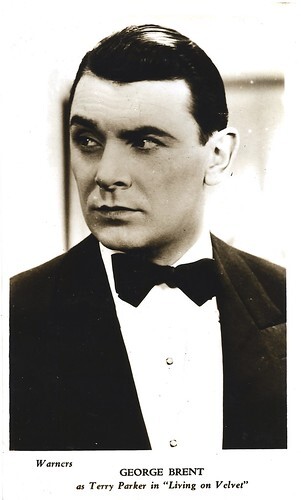
British postcard. Photo: Warner Bros. George Brent as Terry Parker in Living on Velvet (Frank Borzage, 1935).
11 films with Bette Davis
George Brent's breakthrough followed after he signed a contract with Warner Brothers in 1931. He worked for the studio for 20 years and soon became a star. Warner Brothers recognised his potential as a handsome leading man for some of their more temperamental female stars. He played opposite Barbara Stanwyck in the drama So Big! (William A. Wellman, 1932), in which Bette Davis had a small role.
Another hot-tempered star was Ruth Chatterton who picked him to play opposite her in The Rich Are Always with Us (Alfred E. Green, 1932). This was the first of four films he made with the actress, who eventually became his second wife that year. Davis again had a supporting role. Paramount borrowed Brent for the leading-man role in Luxury Liner (Lothar Mendes, 1933).
Back at Warners, he was one of several studio names in the musical 42nd Street (Lloyd Bacon, 1933), playing the lover of Bebe Daniels . 42nd Street was one of the most successful motion pictures of 1933, earning almost $1.5 million at the box office. At the 6th Academy Awards, the film was nominated for Best Picture. He returned to supporting female stars, like Barbara Stanwyck in Baby Face (Alfred E. Green, 1933). He was top-billed in the murder mystery From Headquarters (William Dieterle, 1933) with Margaret Lindsay. Metro-Goldwyn-Mayer borrowed him to play Myrna Loy 's leading man in the Spy film Stamboul Quest (Sam Wood, 1934). In September 1934, Chatterton filed for divorce.
Brent was top billed in Housewife (Alfred E. Green, 1934) with Bette Davis as his costar. MGM used him for the Greta Garbo vehicle The Painted Veil (Richard Boleslawski, 1934). The following year he made two films with Davis, where she was top-billed: the comedy Front Page Woman (Michael Curtiz, 1935) and the crime drama Special Agent (William Keighley, 1935). They were again reunited in the comedy The Golden Arrow (Alfred E. Green, 1936). Warners then put Brent in his first male-orientated movie: Submarine D-1 (Lloyd Bacon, 1937) with Pat O'Brien and Wayne Morris. In November 1937 George Brent became an American citizen.
In 1938, he appeared with Bette Davis in Jezebel (William Wyler, 1938) - only he was the second male lead, with Henry Fonda playing Davis' main love interest. Just after his divorce from his third wife, Constance Worth, Brent made Dark Victory (Edmund Goulding, 1939) with Davis who was also divorced. The two found comfort with each other and embarked on an affair that continued throughout filming and for a year – and three films – after. Goulding shot the film in sequence, and the arc of Judith's relationship with Dr. Steele mirrored Davis' relationship with Brent. Davis was later to say that she wanted to marry Brent but thought that it wouldn't work out. Still, "Of the men I didn't marry, the dearest was George Brent. Dark Victory was a huge success and so was The Old Maid (Edmund Goulding, 1939) where Davis and Miriam Hopkins fought over Brent. Brent also supported Davis in The Great Lie (Edmund Goulding, 1941) and In This Our Life (John Huston, Raoul Walsh, 1942). Brent and Davis appeared in 11 films together.
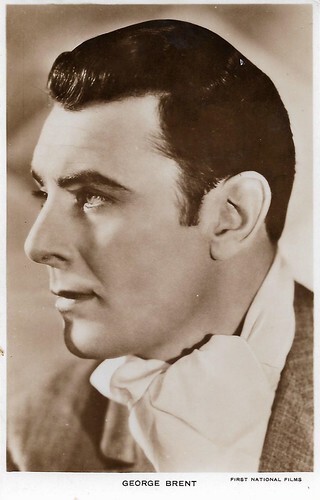
British Real Photograph postcard. Photo: First National Films.
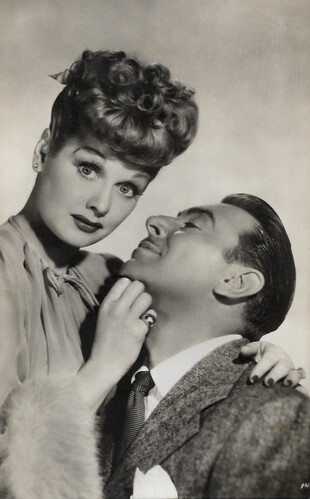
Spanish postcard, no. 1113. Lucille Ball and George Brent in Lover Come Back (William A. Seiter, 1946).
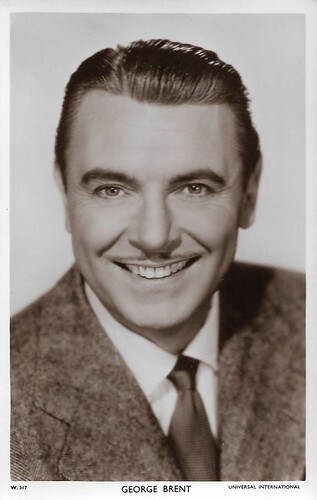
British postcard by Picturegoer, London, no. W 517. Photo: Universal International.
Against type as a maniacal murderer
George Brent was an accomplished pilot who had tried and, because of age, failed to enlist in the armed services. In 1942, he temporarily retired from films to teach flying as a civilian flight instructor with the Civilian Pilot Training Program. He later became a pilot in the US Coast Guard for the duration of the war. His final film for Warner Bros. My Reputation (Curtis Bernhardt, 1946) was his fifth and last film with Barbara Stanwyck , filmed from November 1943 to January 1944, but released in 1946.
Brent acted on the radio during this period. While he returned to his acting career after WWII, George Brent never recaptured his former popularity. However, during the immediate post-war period, he remained a star of big-budget films. RKO used him as Hedy Lamarr's leading man in Experiment Perilous (Jacques Tourneur, 1944). For Hal Wallis, he did The Affairs of Susan (William A. Seiter, 1945) with Joan Fontaine and he appeared in Tomorrow Is Forever (Irvin Pichel, 1946) at International with Claudette Colbert and Orson Welles .
He returned to RKO for The Spiral Staircase (Robert Siodmak, 1946), starring Dorothy McGuire as a mute young woman in an early-20th century Vermont town who is stalked and terrorized in a rural mansion by a serial killer targeting women with disabilities. Brent played against type the maniacal murderer. The psychological Horror film was a huge success. At Universal he was teamed with Lucille Ball in the romantic comedy Lover Come Back (William A. Seiter, 1946). In the late 1940s, Brent appeared in numerous B-movies and the budgets of his films continued to shrink. After two films for Monogram. he retired in 1953.
He made a few more guest roles in TV series and returned to the big screen once for a supporting role in Born Again (Irving Rapper, 1978). The film depicts the involvement of President Richard Nixon's special counsel, Charles Colson (Dean Jones), in the Watergate scandal, his subsequent conversion to Christianity and his prison term. Brent retired from acting to concentrate on breeding race horses. During his heyday, Brent was known in Hollywood as a notorious womaniser. Besides a long-term relationship with Davis, five of his marriages are known, he married Helen Louise Campbell (1925-1927), Ruth Chatterton (1932-1934), Constance Worth (1937) and Ann Sheridan (1942-1943). In 1947, he married model and fashion designer Janet Michaels, with whom he had two children. They remained married until she died in 1974. After a long period of illness, George Brent died of pulmonary emphysema in 1979 in Solana Beach, California. He was 75.
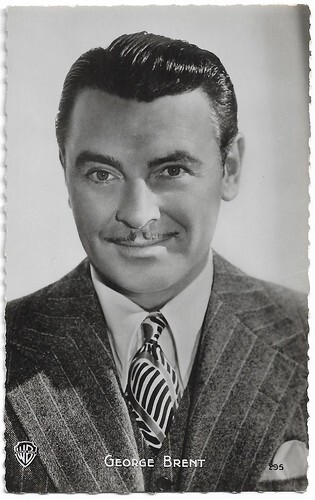
French postcard by Editions P.I., Paris, no. 295. Photo: Warner Bros.
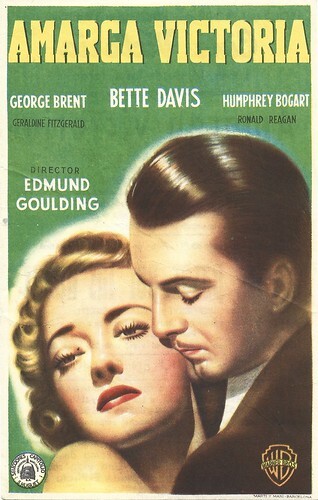
Spanish leaflet by Cifesa Produccion. Image: Warner Bros. Spanish poster for the American film Dark Victory (Edmund Goulding, 1939), starring Bette Davis and George Brent. The film alternated with the Italian film Quattro passi fra le nuvole (Alessandro Blasetti, 1942) at the Madrid-based Cine Victoria, which opened in 1940. The film was the eighth of eleven films in which Davis and Brent were paired.
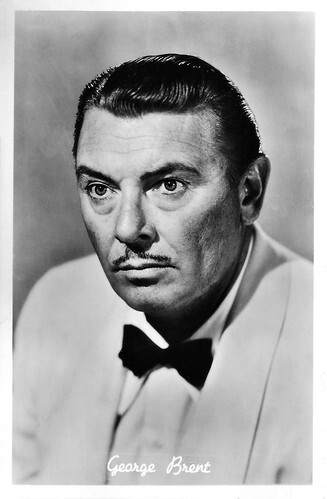
Belgian postcard by Nieuwe Merksemsche Chocolaterie S.P.R.L., Merksem (Antwerp). Photo: Republic Pictures.
Sources: (IMDb), Wikipedia (Dutch and English) and .

British postcard by Art Photo, no. 113 / 37-I. Photo: Warner Bros. and Vitaphone Pictures.

British postcard in the Film Shots series by Film Weekly. Photo: Warner Bros. George Brent and Ruby Keeler in 42nd Street (Lloyd Bacon, 1933).

British postcard in the Film Weekly Series, London, no. 2.
An errand boy for the IRA
George Brent was born George Brendan Nolan in 1904 in Ballinasloe, a small village in County Roscommon, Ireland. He was the son of John J. Nolan and Mary (née McGuinness) Nolan. His father was a shopkeeper (according to some sources a British Army officer). In September 1915, George moved with his younger sister Kathleen to New York City. There, they joined their mother, who was living in the US after her separation from her husband. Again according to some sources, both his parents had died and he moved to his aunt in the US.
There are many discrepancies regarding Brent's year of birth, life, and activities during the 1919 to 1922 period. According to Dutch Wikipedia , he later returned to study at Dublin University. In 1921, at the time of the Irish War of Independence, Brent was part of the IRA. In his later life, he claimed to have been active only as an errand boy for Irish revolutionary, soldier and politician Michael Collins.
During this period he also became involved with the Abbey Theatre. He fled Ireland, travelled from England to Canada and returned to the United States in August 1921. He decided to become a professional actor. He made his Broadway debut in director Guthrie McClintic’s ‘The Dover Road’. He did numerous plays throughout the 1920s, including running several of his own stock companies.
He appeared in productions of ‘Abie's Irish Rose’ (on tour for two years), ‘Stella Dallas’, ‘Up in Mabel's Room’, ‘Elmer the Great’, ‘Seventh Heaven’, ‘White Cargo’ and ‘Lilac Time’. He acted in stock companies at Elitch Theatre, in Denver, Colorado (1929), as well as Rhode Island, Florida, and Massachusetts. In 1930, he appeared on Broadway in ‘Love, Honor, and Betray’, alongside Clark Gable .
George Brent took up residence in Hollywood sometime later to focus on a film career. He debuted for Fox Film Corporation with a supporting role in the musical drama Under Suspicion (A. F. Erickson, 1930), starring J. Harold Murray and Lois Moran. He continued in supporting roles for Fox in Once a Sinner (Guthrie McClintic, 1931) with Dorothy Mackaill and Joel McCrea , the Western Fair Warning (Alfred L. Werker, 1931) starring George O’Brien , and Charlie Chan Carries On (Hamilton MacFadden, 1931) with the first appearance of Warner Oland as Charlie Chan.

British postcard in the Film Shots series by Film Weekly. Photo: Warner Bros. Publicity still for 42nd Street (Lloyd Bacon, 1933) with George Brent, Bebe Daniels and Warren Baxter .

British postcard in the Film Shots series by Film Weekly. Photo: Paramount. Zita Johann and George Brent in Luxury Liner (Lothar Mendes, 1933).

British postcard in the Film Shots series by Film Weekly. Photo: First National Films. Ruth Chatterton, George Brent (right), Marjorie Gateson, Guy Kibbee and Frank McHugh in the American pre-code movie Lilly Turner (William Wellman, 1933).

British postcard. Photo: Warner Bros. George Brent as Terry Parker in Living on Velvet (Frank Borzage, 1935).
11 films with Bette Davis
George Brent's breakthrough followed after he signed a contract with Warner Brothers in 1931. He worked for the studio for 20 years and soon became a star. Warner Brothers recognised his potential as a handsome leading man for some of their more temperamental female stars. He played opposite Barbara Stanwyck in the drama So Big! (William A. Wellman, 1932), in which Bette Davis had a small role.
Another hot-tempered star was Ruth Chatterton who picked him to play opposite her in The Rich Are Always with Us (Alfred E. Green, 1932). This was the first of four films he made with the actress, who eventually became his second wife that year. Davis again had a supporting role. Paramount borrowed Brent for the leading-man role in Luxury Liner (Lothar Mendes, 1933).
Back at Warners, he was one of several studio names in the musical 42nd Street (Lloyd Bacon, 1933), playing the lover of Bebe Daniels . 42nd Street was one of the most successful motion pictures of 1933, earning almost $1.5 million at the box office. At the 6th Academy Awards, the film was nominated for Best Picture. He returned to supporting female stars, like Barbara Stanwyck in Baby Face (Alfred E. Green, 1933). He was top-billed in the murder mystery From Headquarters (William Dieterle, 1933) with Margaret Lindsay. Metro-Goldwyn-Mayer borrowed him to play Myrna Loy 's leading man in the Spy film Stamboul Quest (Sam Wood, 1934). In September 1934, Chatterton filed for divorce.
Brent was top billed in Housewife (Alfred E. Green, 1934) with Bette Davis as his costar. MGM used him for the Greta Garbo vehicle The Painted Veil (Richard Boleslawski, 1934). The following year he made two films with Davis, where she was top-billed: the comedy Front Page Woman (Michael Curtiz, 1935) and the crime drama Special Agent (William Keighley, 1935). They were again reunited in the comedy The Golden Arrow (Alfred E. Green, 1936). Warners then put Brent in his first male-orientated movie: Submarine D-1 (Lloyd Bacon, 1937) with Pat O'Brien and Wayne Morris. In November 1937 George Brent became an American citizen.
In 1938, he appeared with Bette Davis in Jezebel (William Wyler, 1938) - only he was the second male lead, with Henry Fonda playing Davis' main love interest. Just after his divorce from his third wife, Constance Worth, Brent made Dark Victory (Edmund Goulding, 1939) with Davis who was also divorced. The two found comfort with each other and embarked on an affair that continued throughout filming and for a year – and three films – after. Goulding shot the film in sequence, and the arc of Judith's relationship with Dr. Steele mirrored Davis' relationship with Brent. Davis was later to say that she wanted to marry Brent but thought that it wouldn't work out. Still, "Of the men I didn't marry, the dearest was George Brent. Dark Victory was a huge success and so was The Old Maid (Edmund Goulding, 1939) where Davis and Miriam Hopkins fought over Brent. Brent also supported Davis in The Great Lie (Edmund Goulding, 1941) and In This Our Life (John Huston, Raoul Walsh, 1942). Brent and Davis appeared in 11 films together.

British Real Photograph postcard. Photo: First National Films.

Spanish postcard, no. 1113. Lucille Ball and George Brent in Lover Come Back (William A. Seiter, 1946).

British postcard by Picturegoer, London, no. W 517. Photo: Universal International.
Against type as a maniacal murderer
George Brent was an accomplished pilot who had tried and, because of age, failed to enlist in the armed services. In 1942, he temporarily retired from films to teach flying as a civilian flight instructor with the Civilian Pilot Training Program. He later became a pilot in the US Coast Guard for the duration of the war. His final film for Warner Bros. My Reputation (Curtis Bernhardt, 1946) was his fifth and last film with Barbara Stanwyck , filmed from November 1943 to January 1944, but released in 1946.
Brent acted on the radio during this period. While he returned to his acting career after WWII, George Brent never recaptured his former popularity. However, during the immediate post-war period, he remained a star of big-budget films. RKO used him as Hedy Lamarr's leading man in Experiment Perilous (Jacques Tourneur, 1944). For Hal Wallis, he did The Affairs of Susan (William A. Seiter, 1945) with Joan Fontaine and he appeared in Tomorrow Is Forever (Irvin Pichel, 1946) at International with Claudette Colbert and Orson Welles .
He returned to RKO for The Spiral Staircase (Robert Siodmak, 1946), starring Dorothy McGuire as a mute young woman in an early-20th century Vermont town who is stalked and terrorized in a rural mansion by a serial killer targeting women with disabilities. Brent played against type the maniacal murderer. The psychological Horror film was a huge success. At Universal he was teamed with Lucille Ball in the romantic comedy Lover Come Back (William A. Seiter, 1946). In the late 1940s, Brent appeared in numerous B-movies and the budgets of his films continued to shrink. After two films for Monogram. he retired in 1953.
He made a few more guest roles in TV series and returned to the big screen once for a supporting role in Born Again (Irving Rapper, 1978). The film depicts the involvement of President Richard Nixon's special counsel, Charles Colson (Dean Jones), in the Watergate scandal, his subsequent conversion to Christianity and his prison term. Brent retired from acting to concentrate on breeding race horses. During his heyday, Brent was known in Hollywood as a notorious womaniser. Besides a long-term relationship with Davis, five of his marriages are known, he married Helen Louise Campbell (1925-1927), Ruth Chatterton (1932-1934), Constance Worth (1937) and Ann Sheridan (1942-1943). In 1947, he married model and fashion designer Janet Michaels, with whom he had two children. They remained married until she died in 1974. After a long period of illness, George Brent died of pulmonary emphysema in 1979 in Solana Beach, California. He was 75.

French postcard by Editions P.I., Paris, no. 295. Photo: Warner Bros.

Spanish leaflet by Cifesa Produccion. Image: Warner Bros. Spanish poster for the American film Dark Victory (Edmund Goulding, 1939), starring Bette Davis and George Brent. The film alternated with the Italian film Quattro passi fra le nuvole (Alessandro Blasetti, 1942) at the Madrid-based Cine Victoria, which opened in 1940. The film was the eighth of eleven films in which Davis and Brent were paired.

Belgian postcard by Nieuwe Merksemsche Chocolaterie S.P.R.L., Merksem (Antwerp). Photo: Republic Pictures.
Sources: (IMDb), Wikipedia (Dutch and English) and .
Published on December 14, 2024 22:00
December 13, 2024
Directed by Walt Disney
On 16 October 1923, Walt Disney (1901-1966) and his brother Roy O. Disney founded the Disney Brothers Cartoon Studio. Later the studio operated under The Walt Disney Studio and Walt Disney Productions. The company established itself as a leader in the American animation industry before diversifying into live-action film production, television, and theme parks. But it all started with Mickey Mouse, who Disney created in 1928 and is still Disney's signature mascot and emblem.
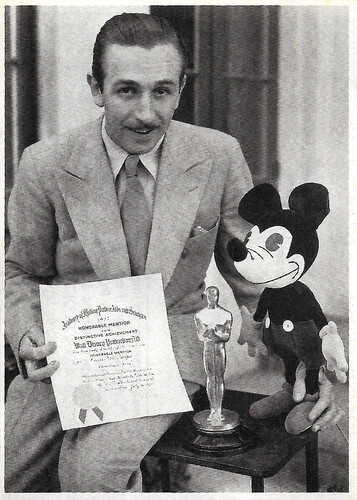
French collector card by Chocolat Poulain, Blois, series 42, no. 21. Photo: Walt Disney Productions. Caption: Cinema Father Christmas. Walt Disney won his first Oscar in 1932.

Vintage postcard. In 1932, Walt Disney received an honorary Academy Award for creating Mickey Mouse.

German postcard by Ross Verlag, no. 5227/1, 1930-1931. Image: Walt Disney. Collection: Marlene Pilaete. Mickey Mouse.

British postcard in the Picturegoer series. Image: Walt Disney. Collection: Marlene Pilaete.
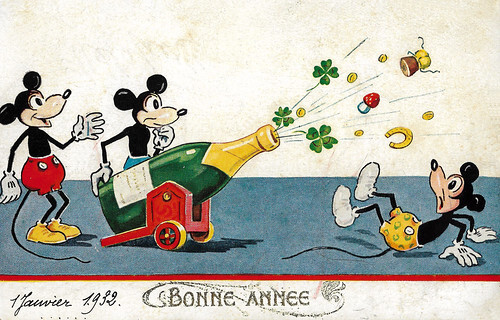
German postcard by WHB, no. 8969. Image: Walt Disney. Sent by mail in 1932.
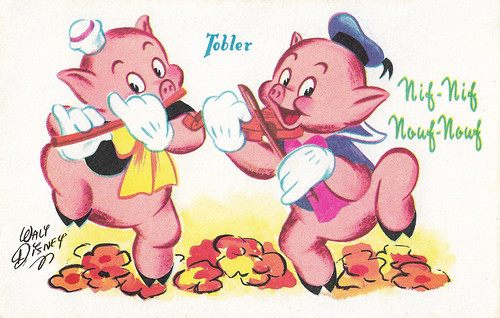
French postcard by Imp. Georges Lang, Paris, offered by Chocolats Tobler. Image: Walt Disney. Fifer Pig and Fiddler Pig.
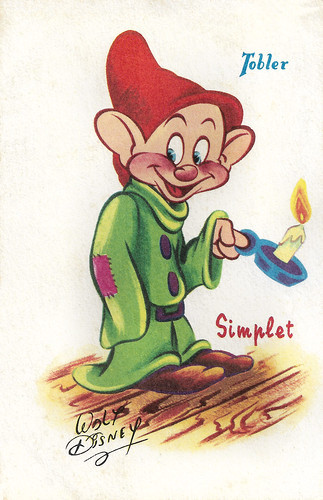
French postcard by Imp. Georges Lang, Paris, offered by Chocolats Tobler. Image: Walt Disney. Publicity still for Snow White and the Seven Dwarfs (William Cottrell, David Hand, Wilfred Jackson, Larry Morey, Perce Pearce, Ben Sharpsteen, 1937). Caption: Simplet (Dopey).
Silly symphony
Walt Disney was born in Chicago, Illinois, in 1901. His father, Elias Disney, was an Irish-Canadian. His mother, Flora Call Disney, was of German-American descent. Walt was one of five children, four boys and a girl and was raised on a farm near Marceline, Missouri. He became interested in drawing early, selling his first sketches to neighbours when he was only seven. At McKinley High School in Chicago, Walt divided his attention between drawing and photography, contributing to the school paper. At night he attended the Academy of Fine Arts. During the fall of 1918, Disney attempted to enlist for military service. Rejected because he was only 16, Walt joined the Red Cross and was sent overseas, where he spent a year driving an ambulance and chauffeuring Red Cross officials. His ambulance was covered from stem to stern, not with stock camouflage, but with drawings and cartoons.
After the war, Walt returned to Kansas City, where he began his career as an advertising cartoonist. Here, in 1920, he created and marketed his first original animated cartoons, and later perfected a new method for combining live-action and animation. In early 1923, animator Walt Disney created a short film entitled Alice's Wonderland, which featured child actress Virginia Davis interacting with animated characters. After the bankruptcy in 1923 of his previous firm, Laugh-O-Gram Studio, Disney moved to Hollywood to join his brother, Roy O. Disney. Film distributor Margaret J. Winkler of M.J. Winkler Productions contacted Disney with plans to distribute a series of Alice Comedies purchased for $1,500 per reel with Disney as a production partner.
Walt and Roy Disney formed the Disney Brothers Cartoon Studio that same year. More animated films followed after Alice. In January 1926, with the completion of the Disney studio on Hyperion Street, the Disney Brothers Studio's name was changed to the Walt Disney Studio. Hundreds of Alice Comedies were produced between 1923 and 1927 before they lost popularity. After the demise of the Alice Comedies, Disney developed an all-cartoon series starring his first original character, Oswald the Lucky Rabbit, which Winkler Pictures distributed through Universal Pictures. The distributor owned Oswald, so Disney only made a few hundred dollars. From 1927 on, Disney completed 26 Oswald shorts before losing the contract in February 1928, due to a legal loophole, when Winkler's husband Charles Mintz took over their distribution company. After failing to take over the Disney Studio, Mintz hired away four of Disney's primary animators (the exception being Ub Iwerks) to start another animation studio, Snappy Comedies.
In 1928, to recover from the loss of Oswald the Lucky Rabbit, Disney came up with the idea of a mouse character named Mortimer while on a train headed to California, drawing up a few simple drawings. The mouse was later renamed Mickey Mouse and starred in several Disney-produced films. Ub Iwerks refined Disney's initial design of Mickey Mouse. Disney's first sound film Steamboat Willie (Walt Disney, Ub Iwerks, 1928), a cartoon starring Mickey, was released in 1928 through Pat Powers' distribution company. It was the first Mickey Mouse sound cartoon released, but the third to be created, behind Plane Crazy (Walt Disney, Ub Iwerks, 1928), and The Gallopin' Gaucho (Walt Disney, Ub Iwerks, 1928). Steamboat Willie, with Walt as the voice of Mickey, was an immediate smash hit, and its initial success was attributed not just to Mickey's appeal as a character, but to the fact that it was the first cartoon to feature synchronised sound. Disney's Plane Crazy and The Gallopin' Gaucho were then retrofitted with synchronised soundtracks and re-released successfully in 1929. Disney continued to produce cartoons with Mickey Mouse and friends, including Minnie Mouse, Donald Duck, Goofy, Pluto, and plenty more.
He began the Silly Symphony series, a cartoon series that didn't have a continuous character, with Columbia Pictures signing on as Symphonies distributor in August 1929. In September 1929, theatre manager Harry Woodin requested permission to start a Mickey Mouse Club which Walt approved. In November, test comic strips were sent to King Features, who requested additional samples to show to the publisher, William Randolph Hearst. On 30 December, King Features signed its first newspaper, New York Mirror, to publish the Mickey Mouse comic strip with Walt's permission. In 1932, Disney signed an exclusive contract with Technicolor (through the end of 1935) to produce cartoons in colour. The first, Flowers and Trees (Burt Gillett, 1932), was also the first cartoon to win an Oscar. Another cartoon, Three Little Pigs (Burt Gillett, 1933), was so popular it was often billed above the feature films it accompanied. Disney released cartoons through Powers' Celebrity Pictures (1928–1930), Columbia Pictures (1930–1932), and United Artists (1932–1937). The popularity of the Mickey Mouse series allowed Disney to plan for his first feature-length animation. Criticasters called it "Disney's Folly".
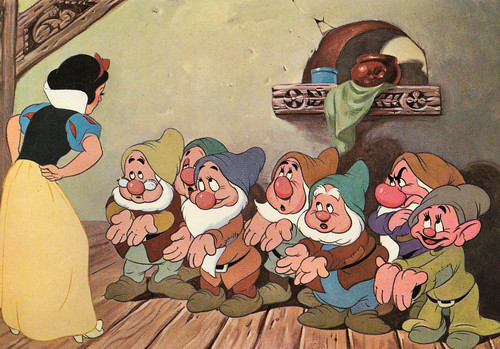
French postcard in the series The Wonderful World of Walt Disney by Editions Kroma, Caissargues, no. 202. Image: Walt Disney Productions. Publicity still for Snow White and the Seven Dwarfs (William Cottrell, David Hand, Wilfred Jackson, Larry Morey, Perce Pearce, Ben Sharpsteen, 1937).
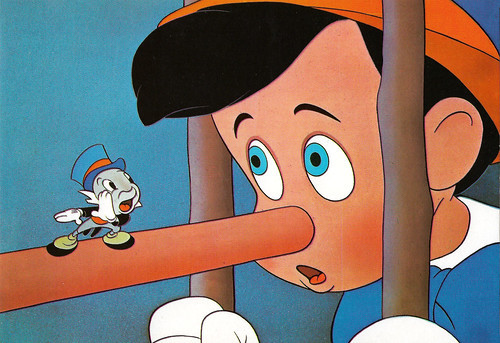
Italian postcard by Grafiche Biondetti, Verona, no. 115/2. Image: Disney. Publicity still for Pinocchio (Hamilton Luske, Ben Sharpsteen, a.o., 1940).

American postcard by Classico San Francisco, no. 328-008 Image: Walt Disney Productions. Mickey Mouse as the sorcerer's apprentice in Fantasia (James Algar, Wilfred Jackson, Hamilton Luske, Ben Sharpsteen, a.o., 1940).
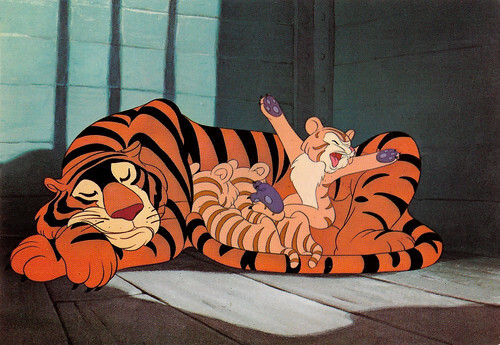
French postcard in the 'Le monde merveilleux de Walt Disney' series by Editions Kroma, Caisargues. Image: Walt Disney Productions. Publicity still for Dumbo (Ben Sharpsteen, a.o., 1941). Sent by mail in 1990.
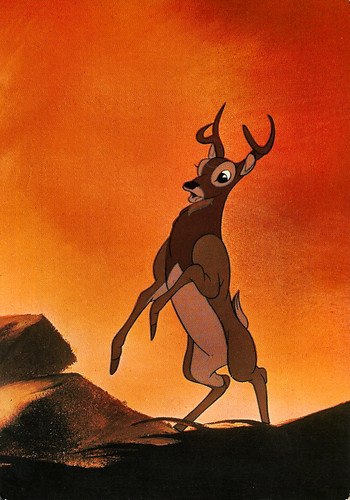
Italian postcard by Grafiche Biondetti, Verona, no. 101. Image: Walt Disney Productions. Publicity still for Bambi (David Hand, 1942).
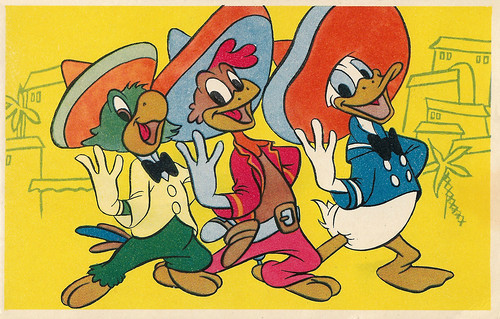
Belgian postcard, no. 1. Publicity postcard by The Three Caballeros (Norman Ferguson, Clyde Geronimi, Jack Kinney, Bill Roberts, 1944). Caption: We are the Three Caballeros.
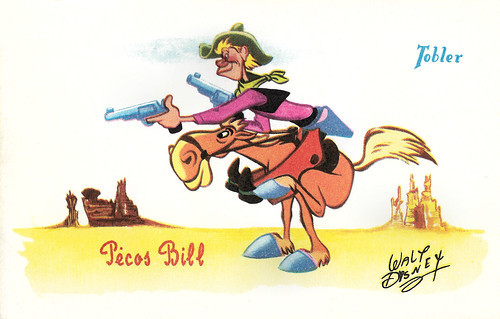
French postcard by Imp. Georges Lang, Paris, offered by Chocolats Tobler. Image: Walt Disney. Pecos Bill is a handsome, tough, rough, funny, and heroic American cowboy from Texas. He is the protagonist of the segment Pecos Bill from Disney's Melody Time (Clyde Geronimi, Wilfred Jackson, Jack Kinney, Hamilton Luske, 1948).
Disney's Folly
Walt Disney decided to push the boundaries of animation further. He began production of his first feature-length animated film in 1934. Taking three years to complete, Snow White and the Seven Dwarfs (William Cottrell, David Hand, Wilfred Jackson, Larry Morey, Perce Pearce, Ben Sharpsteen, 1937), premiered in December 1937 and by 1939 became the highest-grossing film of that time. Snow White was released through RKO Radio Pictures, which had assumed distribution of Disney's product in July 1937, after United Artists attempted to attain future television rights to the Disney shorts.
Using the profits from Snow White, Disney financed the construction of a new 51-acre (210,000 m2) studio complex in Burbank, California. The new Walt Disney Studios, in which the company is headquartered to this day, was completed and open for business by the end of 1939. The studio continued releasing animated shorts and features, such as Pinocchio (Hamilton Luske, Ben Sharpsteen, a.o., 1940), Fantasia (James Algar, Wilfred Jackson, Hamilton Luske, Ben Sharpsteen, a.o., 1940), Dumbo (Ben Sharpsteen, a.o., 1941), and Bambi (David Hand, 1942).
After World War II began, box office profits declined. When the United States entered the war after the attack on Pearl Harbor, many of Disney's animators were drafted into the armed forces. The U.S. and Canadian governments commissioned the studio to produce training and propaganda films. By 1942, 90% of its 550 employees were working on war-related films. Films such as the feature Victory Through Air Power (Perce Pearce, a.o., 1943) and the short Education for Death (Clyde Geronimi, 1943) were meant to increase public support for the war effort.
Even the studio's characters joined the effort, as Donald Duck appeared in several comical propaganda shorts, including the Academy Award-winning Der Fuehrer's Face (Jack Kinney, 1943). With limited staff and little operating capital during and after the war, Disney's feature films during much of the 1940s were 'package films', or collections of shorts, such as The Three Caballeros (Norman Ferguson, a.o., 1944) and Melody Time (Jack Kinney, Clyde Geronimi, Hamilton Luske, Wilfred Jackson, 1948), which performed poorly at the box office. At the same time, the studio began producing live-action films and documentaries. Song of the South (Harve Foster, Wilfred Jackson, 1946) and So Dear to My Heart (Harold D. Schuster, Hamilton Luske, 1948) featured animated segments, while the True-Life Adventures series, which included such films as Seal Island (James Algar, 1948) and The Vanishing Prairie (James Algar, 1954), were also popular. Eight of the films in the series won Academy Awards.
The release of Cinderella (Clyde Geronimi, Hamilton Luske, Wilfred Jackson, 1950) proved that feature-length animation could still succeed in the marketplace. Other releases of the period included Alice in Wonderland (Clyde Geronimi, Wilfred Jackson, Hamilton Luske, 1951) and Peter Pan (Clyde Geronimi, Wilfred Jackson, Hamilton Luske, 1953), both in production before the war began, and Disney's first all-live action feature, Treasure Island (Byron Haskin, 1950). Disney ended its distribution contract with RKO in 1953, forming its distribution arm, Buena Vista Distribution. In December 1950, Walt Disney Productions and the Coca-Cola Company teamed up for Disney's first venture into television, the NBC television network special An Hour in Wonderland. In October 1954, the ABC network launched Disney's first regular television series.
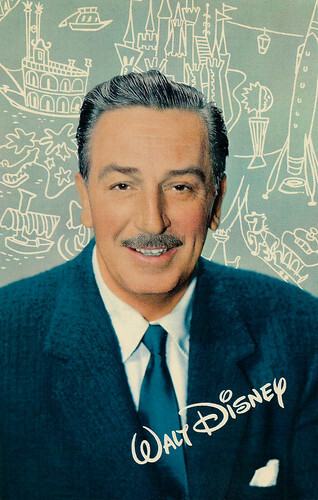
American postcard by Disneyland Inc., Anaheim, California. Caption: "Disneyland is dedicated to the ideals. the dreams and the heart facts that have created America... with the hope that it will be a source of joy to all the world." Walt Disney.
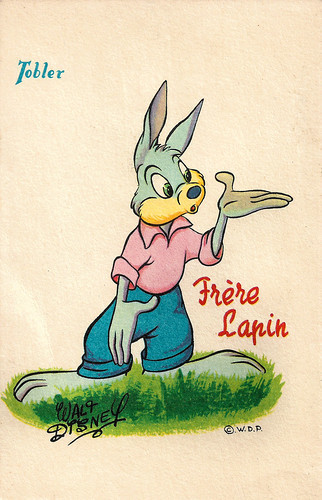
French postcard by Tobler. Image: Walt Disney. Br'er Rabbit is the protagonist of the animated sequences of the Disney feature film Song of the South (Harve Foster, Wilfred Jackson, 1946).
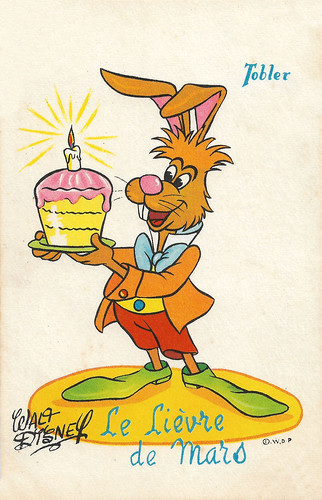
French postcard by Imp. Georges Lang, Paris, offered by Chocolats Tobler. Image: Walt Disney. The March Hare is a wacky, mallet-carrying rabbit in Disney's animated feature film, Alice in Wonderland (Clyde Geronimi, Wilfred Jackson, Hamilton Luske, 1951). He is a resident of Wonderland and the best friend of the Mad Hatter, with whom the Hare regularly engages in tea and 'unbirthday' parties.
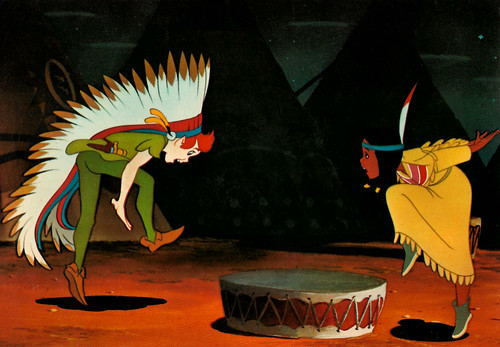
French postcard by Editions G. Picard, Paris, no. WD 2/20, 1978. Image: Walt Disney Production. Still from Peter Pan (Clyde Geronimi, Wilfred Jackson, Hamilton Luske, 1953).
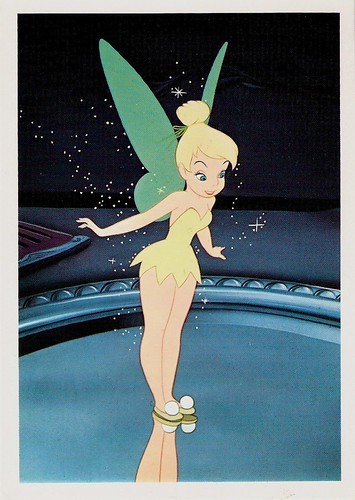
Vintage postcard in the Disney Classics series by European Greetings, no. 535552. Image: Walt Disney. Tinker Bell in Peter Pan (Clyde Geronimi, Wilfred Jackson, Hamilton Luske, 1953). Sent by mail in 1997.
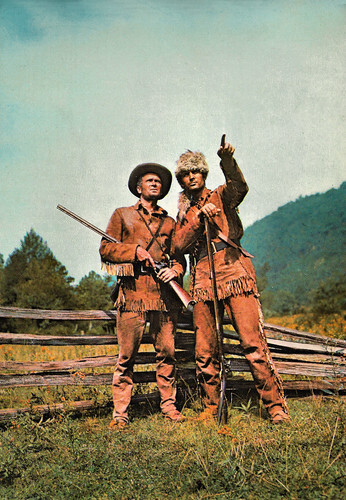
French card by Jouets Masport, Chanas (Isère), no. 39/882. Photo: Walt Disney. Fess Parker and Buddy Ebsen in Davy Crockett - King of the Wild Frontier/Davy Crockett (Norman Foster, 1955).
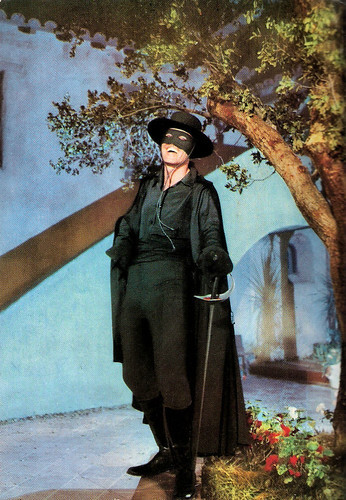
French postcard by Les Presses de Belville, Paris, no. 109. Photo: Walt Disney Productions, 1964. Zorro (1957-1959) was an American half-hour television series, produced by Walt Disney Guy Williams plays Don Diego de la Vega who opposes the corrupt tyrants of Spanish California as the masked swordsman, Zorro.
Walt Disney's magnum opus
In 1954, Walt Disney used his Disneyland series to unveil what would become Disneyland, an idea conceived out of a desire for a place where parents and children could both have fun at the same time. In 1955, Disney opened Disneyland to the general public. After a shaky start, Disneyland continued to grow and attract visitors from across the country and around the world. In 1965, a second Disney theme park, Disney World', was announced, outside of Orlando, Florida.
Disney continued to focus its talents on television throughout the 1950s. Its weekday afternoon children's television program The Mickey Mouse Club (1955) was a great success, as was the Davy Crockett miniseries, starring Fess Parker and broadcast on the Disneyland anthology show. Two years later, Zorro (1957) would prove just as popular, running for two seasons on ABC.
Disney's film studios stayed busy as well, averaging five or six releases per year during this period. While the production of shorts slowed significantly during the 1950s and 1960s, the studio released many popular animated features, like Lady and the Tramp (Clyde Geronimi, Wilfred Jackson, Hamilton Luske, 1955), Sleeping Beauty (Clyde Geronimi, a.o., 1959) and One Hundred and One Dalmatians (Clyde Geronimi, Hamilton Luske, 1961), which introduced a new xerography process to transfer the drawings to animation cels.
Disney's live-action releases were spread across several genres, including the historical fiction film Johnny Tremain (Robert Stevenson, 1957), the children's book adaptation Pollyanna (David Swift, 1960) starring Hayley Mills , and the modern-day comedy The Shaggy Dog (Charles Barton, 1959), with Fred MacMurray . Disney's most successful film of the 1960s was a musical adaptation of Mary Poppins (Robert Stevenson, 1964), which mixed live-action with animation. It is considered by many to be Walt Disney's magnum opus. Mary Poppins became one of the all-time highest-grossing films and received five Academy Awards, including Best Actress for Julie Andrews and Best Song for Robert B. Sherman & Richard M. Sherman for 'Chim Chim Cher-ee'.
In 1966, Walt Disney died of complications relating to lung cancer. His brother Roy Disney took over as chairman, CEO, and president of the company. In 1925, Walt Disney married one of his first employees, Lillian Bounds. They had two daughters — Diane, married to Ron Miller, former president and chief executive officer of Walt Disney Productions, and Sharon Disney Lund, formerly a member of Disney’s Board of Directors.
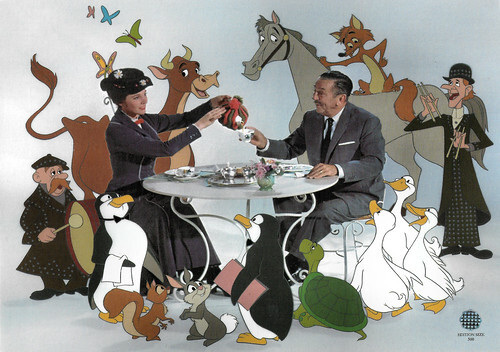
American postcard by The Animated Animations Company, no. 300. Image: Walt Disney Animation Art. Walt Disney and Julie Andrews between animated characters from Mary Poppins (Robert Stevenson, 1964). Caption: Come Join the Party with Walt & Mary... "A Supercalifragilstic Tea Party".
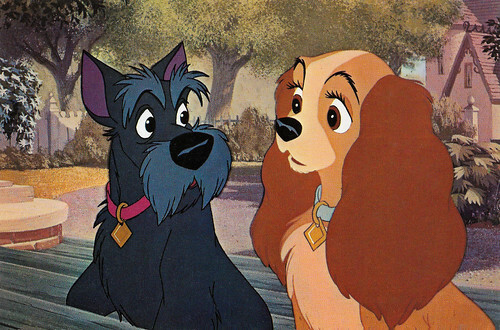
Belgian postcard by Editions Corna, Brussels. Image: Walt Disney Productions. Publicity still for Lady and the Tramp (Clyde Geronimi, Wilfred Jackson, Hamilton Luske, 1955).
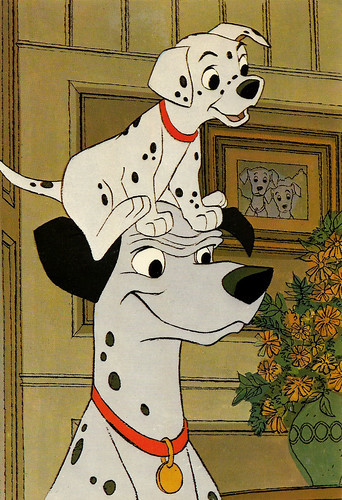
French postcard by Kroma, Caissargues, no. B. 86. Publicity still for One Hundred and One Dalmatians (Clyde Geronimi, Hamilton Luske, 1961).
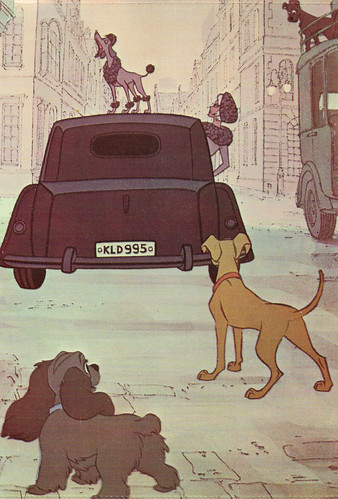
French postcard. Image: Walt Disney Productions. Publicity still for One Hundred and One Dalmatians (Clyde Geronimi, Hamilton Luske, 1961).
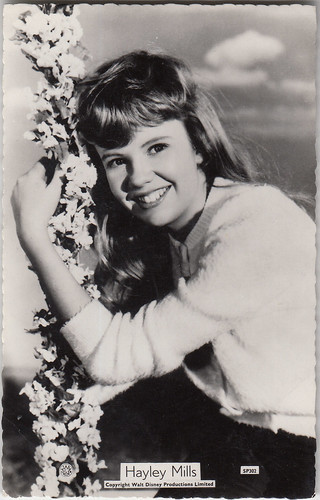
Vintage postcard, no. SP302. Photo: Walt Disney Productions Limited. Collection: Marlene Pilaete. Hayley Mills .
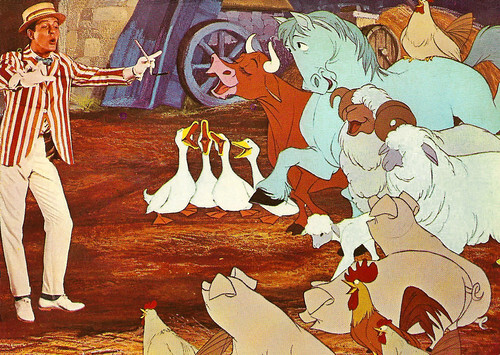
French postcard by Les Presses de Belleville, Paris, no. 108. Photo: Walt Disney Productions. Dick van Dyke in Mary Poppins (Robert Stevenson, 1964).
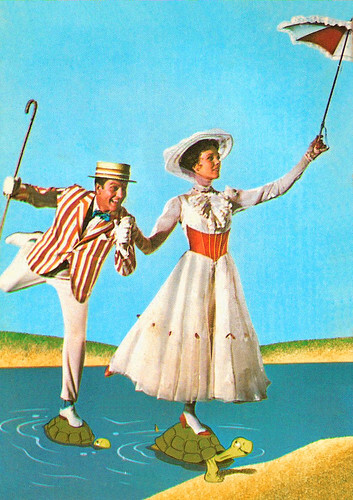
Spanish postcard by Ediciones Tarje Fher/Ediciones Mandolina, 1964. Photo: Walt Disney Productions. Julie Andrews and Dick Van Dyke in Mary Poppins (1964).
Sources: D23: The Official Disney Fan Club, Wikipedia and IMDb.

French collector card by Chocolat Poulain, Blois, series 42, no. 21. Photo: Walt Disney Productions. Caption: Cinema Father Christmas. Walt Disney won his first Oscar in 1932.

Vintage postcard. In 1932, Walt Disney received an honorary Academy Award for creating Mickey Mouse.

German postcard by Ross Verlag, no. 5227/1, 1930-1931. Image: Walt Disney. Collection: Marlene Pilaete. Mickey Mouse.

British postcard in the Picturegoer series. Image: Walt Disney. Collection: Marlene Pilaete.

German postcard by WHB, no. 8969. Image: Walt Disney. Sent by mail in 1932.

French postcard by Imp. Georges Lang, Paris, offered by Chocolats Tobler. Image: Walt Disney. Fifer Pig and Fiddler Pig.

French postcard by Imp. Georges Lang, Paris, offered by Chocolats Tobler. Image: Walt Disney. Publicity still for Snow White and the Seven Dwarfs (William Cottrell, David Hand, Wilfred Jackson, Larry Morey, Perce Pearce, Ben Sharpsteen, 1937). Caption: Simplet (Dopey).
Silly symphony
Walt Disney was born in Chicago, Illinois, in 1901. His father, Elias Disney, was an Irish-Canadian. His mother, Flora Call Disney, was of German-American descent. Walt was one of five children, four boys and a girl and was raised on a farm near Marceline, Missouri. He became interested in drawing early, selling his first sketches to neighbours when he was only seven. At McKinley High School in Chicago, Walt divided his attention between drawing and photography, contributing to the school paper. At night he attended the Academy of Fine Arts. During the fall of 1918, Disney attempted to enlist for military service. Rejected because he was only 16, Walt joined the Red Cross and was sent overseas, where he spent a year driving an ambulance and chauffeuring Red Cross officials. His ambulance was covered from stem to stern, not with stock camouflage, but with drawings and cartoons.
After the war, Walt returned to Kansas City, where he began his career as an advertising cartoonist. Here, in 1920, he created and marketed his first original animated cartoons, and later perfected a new method for combining live-action and animation. In early 1923, animator Walt Disney created a short film entitled Alice's Wonderland, which featured child actress Virginia Davis interacting with animated characters. After the bankruptcy in 1923 of his previous firm, Laugh-O-Gram Studio, Disney moved to Hollywood to join his brother, Roy O. Disney. Film distributor Margaret J. Winkler of M.J. Winkler Productions contacted Disney with plans to distribute a series of Alice Comedies purchased for $1,500 per reel with Disney as a production partner.
Walt and Roy Disney formed the Disney Brothers Cartoon Studio that same year. More animated films followed after Alice. In January 1926, with the completion of the Disney studio on Hyperion Street, the Disney Brothers Studio's name was changed to the Walt Disney Studio. Hundreds of Alice Comedies were produced between 1923 and 1927 before they lost popularity. After the demise of the Alice Comedies, Disney developed an all-cartoon series starring his first original character, Oswald the Lucky Rabbit, which Winkler Pictures distributed through Universal Pictures. The distributor owned Oswald, so Disney only made a few hundred dollars. From 1927 on, Disney completed 26 Oswald shorts before losing the contract in February 1928, due to a legal loophole, when Winkler's husband Charles Mintz took over their distribution company. After failing to take over the Disney Studio, Mintz hired away four of Disney's primary animators (the exception being Ub Iwerks) to start another animation studio, Snappy Comedies.
In 1928, to recover from the loss of Oswald the Lucky Rabbit, Disney came up with the idea of a mouse character named Mortimer while on a train headed to California, drawing up a few simple drawings. The mouse was later renamed Mickey Mouse and starred in several Disney-produced films. Ub Iwerks refined Disney's initial design of Mickey Mouse. Disney's first sound film Steamboat Willie (Walt Disney, Ub Iwerks, 1928), a cartoon starring Mickey, was released in 1928 through Pat Powers' distribution company. It was the first Mickey Mouse sound cartoon released, but the third to be created, behind Plane Crazy (Walt Disney, Ub Iwerks, 1928), and The Gallopin' Gaucho (Walt Disney, Ub Iwerks, 1928). Steamboat Willie, with Walt as the voice of Mickey, was an immediate smash hit, and its initial success was attributed not just to Mickey's appeal as a character, but to the fact that it was the first cartoon to feature synchronised sound. Disney's Plane Crazy and The Gallopin' Gaucho were then retrofitted with synchronised soundtracks and re-released successfully in 1929. Disney continued to produce cartoons with Mickey Mouse and friends, including Minnie Mouse, Donald Duck, Goofy, Pluto, and plenty more.
He began the Silly Symphony series, a cartoon series that didn't have a continuous character, with Columbia Pictures signing on as Symphonies distributor in August 1929. In September 1929, theatre manager Harry Woodin requested permission to start a Mickey Mouse Club which Walt approved. In November, test comic strips were sent to King Features, who requested additional samples to show to the publisher, William Randolph Hearst. On 30 December, King Features signed its first newspaper, New York Mirror, to publish the Mickey Mouse comic strip with Walt's permission. In 1932, Disney signed an exclusive contract with Technicolor (through the end of 1935) to produce cartoons in colour. The first, Flowers and Trees (Burt Gillett, 1932), was also the first cartoon to win an Oscar. Another cartoon, Three Little Pigs (Burt Gillett, 1933), was so popular it was often billed above the feature films it accompanied. Disney released cartoons through Powers' Celebrity Pictures (1928–1930), Columbia Pictures (1930–1932), and United Artists (1932–1937). The popularity of the Mickey Mouse series allowed Disney to plan for his first feature-length animation. Criticasters called it "Disney's Folly".

French postcard in the series The Wonderful World of Walt Disney by Editions Kroma, Caissargues, no. 202. Image: Walt Disney Productions. Publicity still for Snow White and the Seven Dwarfs (William Cottrell, David Hand, Wilfred Jackson, Larry Morey, Perce Pearce, Ben Sharpsteen, 1937).

Italian postcard by Grafiche Biondetti, Verona, no. 115/2. Image: Disney. Publicity still for Pinocchio (Hamilton Luske, Ben Sharpsteen, a.o., 1940).

American postcard by Classico San Francisco, no. 328-008 Image: Walt Disney Productions. Mickey Mouse as the sorcerer's apprentice in Fantasia (James Algar, Wilfred Jackson, Hamilton Luske, Ben Sharpsteen, a.o., 1940).

French postcard in the 'Le monde merveilleux de Walt Disney' series by Editions Kroma, Caisargues. Image: Walt Disney Productions. Publicity still for Dumbo (Ben Sharpsteen, a.o., 1941). Sent by mail in 1990.

Italian postcard by Grafiche Biondetti, Verona, no. 101. Image: Walt Disney Productions. Publicity still for Bambi (David Hand, 1942).

Belgian postcard, no. 1. Publicity postcard by The Three Caballeros (Norman Ferguson, Clyde Geronimi, Jack Kinney, Bill Roberts, 1944). Caption: We are the Three Caballeros.

French postcard by Imp. Georges Lang, Paris, offered by Chocolats Tobler. Image: Walt Disney. Pecos Bill is a handsome, tough, rough, funny, and heroic American cowboy from Texas. He is the protagonist of the segment Pecos Bill from Disney's Melody Time (Clyde Geronimi, Wilfred Jackson, Jack Kinney, Hamilton Luske, 1948).
Disney's Folly
Walt Disney decided to push the boundaries of animation further. He began production of his first feature-length animated film in 1934. Taking three years to complete, Snow White and the Seven Dwarfs (William Cottrell, David Hand, Wilfred Jackson, Larry Morey, Perce Pearce, Ben Sharpsteen, 1937), premiered in December 1937 and by 1939 became the highest-grossing film of that time. Snow White was released through RKO Radio Pictures, which had assumed distribution of Disney's product in July 1937, after United Artists attempted to attain future television rights to the Disney shorts.
Using the profits from Snow White, Disney financed the construction of a new 51-acre (210,000 m2) studio complex in Burbank, California. The new Walt Disney Studios, in which the company is headquartered to this day, was completed and open for business by the end of 1939. The studio continued releasing animated shorts and features, such as Pinocchio (Hamilton Luske, Ben Sharpsteen, a.o., 1940), Fantasia (James Algar, Wilfred Jackson, Hamilton Luske, Ben Sharpsteen, a.o., 1940), Dumbo (Ben Sharpsteen, a.o., 1941), and Bambi (David Hand, 1942).
After World War II began, box office profits declined. When the United States entered the war after the attack on Pearl Harbor, many of Disney's animators were drafted into the armed forces. The U.S. and Canadian governments commissioned the studio to produce training and propaganda films. By 1942, 90% of its 550 employees were working on war-related films. Films such as the feature Victory Through Air Power (Perce Pearce, a.o., 1943) and the short Education for Death (Clyde Geronimi, 1943) were meant to increase public support for the war effort.
Even the studio's characters joined the effort, as Donald Duck appeared in several comical propaganda shorts, including the Academy Award-winning Der Fuehrer's Face (Jack Kinney, 1943). With limited staff and little operating capital during and after the war, Disney's feature films during much of the 1940s were 'package films', or collections of shorts, such as The Three Caballeros (Norman Ferguson, a.o., 1944) and Melody Time (Jack Kinney, Clyde Geronimi, Hamilton Luske, Wilfred Jackson, 1948), which performed poorly at the box office. At the same time, the studio began producing live-action films and documentaries. Song of the South (Harve Foster, Wilfred Jackson, 1946) and So Dear to My Heart (Harold D. Schuster, Hamilton Luske, 1948) featured animated segments, while the True-Life Adventures series, which included such films as Seal Island (James Algar, 1948) and The Vanishing Prairie (James Algar, 1954), were also popular. Eight of the films in the series won Academy Awards.
The release of Cinderella (Clyde Geronimi, Hamilton Luske, Wilfred Jackson, 1950) proved that feature-length animation could still succeed in the marketplace. Other releases of the period included Alice in Wonderland (Clyde Geronimi, Wilfred Jackson, Hamilton Luske, 1951) and Peter Pan (Clyde Geronimi, Wilfred Jackson, Hamilton Luske, 1953), both in production before the war began, and Disney's first all-live action feature, Treasure Island (Byron Haskin, 1950). Disney ended its distribution contract with RKO in 1953, forming its distribution arm, Buena Vista Distribution. In December 1950, Walt Disney Productions and the Coca-Cola Company teamed up for Disney's first venture into television, the NBC television network special An Hour in Wonderland. In October 1954, the ABC network launched Disney's first regular television series.

American postcard by Disneyland Inc., Anaheim, California. Caption: "Disneyland is dedicated to the ideals. the dreams and the heart facts that have created America... with the hope that it will be a source of joy to all the world." Walt Disney.

French postcard by Tobler. Image: Walt Disney. Br'er Rabbit is the protagonist of the animated sequences of the Disney feature film Song of the South (Harve Foster, Wilfred Jackson, 1946).

French postcard by Imp. Georges Lang, Paris, offered by Chocolats Tobler. Image: Walt Disney. The March Hare is a wacky, mallet-carrying rabbit in Disney's animated feature film, Alice in Wonderland (Clyde Geronimi, Wilfred Jackson, Hamilton Luske, 1951). He is a resident of Wonderland and the best friend of the Mad Hatter, with whom the Hare regularly engages in tea and 'unbirthday' parties.

French postcard by Editions G. Picard, Paris, no. WD 2/20, 1978. Image: Walt Disney Production. Still from Peter Pan (Clyde Geronimi, Wilfred Jackson, Hamilton Luske, 1953).

Vintage postcard in the Disney Classics series by European Greetings, no. 535552. Image: Walt Disney. Tinker Bell in Peter Pan (Clyde Geronimi, Wilfred Jackson, Hamilton Luske, 1953). Sent by mail in 1997.

French card by Jouets Masport, Chanas (Isère), no. 39/882. Photo: Walt Disney. Fess Parker and Buddy Ebsen in Davy Crockett - King of the Wild Frontier/Davy Crockett (Norman Foster, 1955).

French postcard by Les Presses de Belville, Paris, no. 109. Photo: Walt Disney Productions, 1964. Zorro (1957-1959) was an American half-hour television series, produced by Walt Disney Guy Williams plays Don Diego de la Vega who opposes the corrupt tyrants of Spanish California as the masked swordsman, Zorro.
Walt Disney's magnum opus
In 1954, Walt Disney used his Disneyland series to unveil what would become Disneyland, an idea conceived out of a desire for a place where parents and children could both have fun at the same time. In 1955, Disney opened Disneyland to the general public. After a shaky start, Disneyland continued to grow and attract visitors from across the country and around the world. In 1965, a second Disney theme park, Disney World', was announced, outside of Orlando, Florida.
Disney continued to focus its talents on television throughout the 1950s. Its weekday afternoon children's television program The Mickey Mouse Club (1955) was a great success, as was the Davy Crockett miniseries, starring Fess Parker and broadcast on the Disneyland anthology show. Two years later, Zorro (1957) would prove just as popular, running for two seasons on ABC.
Disney's film studios stayed busy as well, averaging five or six releases per year during this period. While the production of shorts slowed significantly during the 1950s and 1960s, the studio released many popular animated features, like Lady and the Tramp (Clyde Geronimi, Wilfred Jackson, Hamilton Luske, 1955), Sleeping Beauty (Clyde Geronimi, a.o., 1959) and One Hundred and One Dalmatians (Clyde Geronimi, Hamilton Luske, 1961), which introduced a new xerography process to transfer the drawings to animation cels.
Disney's live-action releases were spread across several genres, including the historical fiction film Johnny Tremain (Robert Stevenson, 1957), the children's book adaptation Pollyanna (David Swift, 1960) starring Hayley Mills , and the modern-day comedy The Shaggy Dog (Charles Barton, 1959), with Fred MacMurray . Disney's most successful film of the 1960s was a musical adaptation of Mary Poppins (Robert Stevenson, 1964), which mixed live-action with animation. It is considered by many to be Walt Disney's magnum opus. Mary Poppins became one of the all-time highest-grossing films and received five Academy Awards, including Best Actress for Julie Andrews and Best Song for Robert B. Sherman & Richard M. Sherman for 'Chim Chim Cher-ee'.
In 1966, Walt Disney died of complications relating to lung cancer. His brother Roy Disney took over as chairman, CEO, and president of the company. In 1925, Walt Disney married one of his first employees, Lillian Bounds. They had two daughters — Diane, married to Ron Miller, former president and chief executive officer of Walt Disney Productions, and Sharon Disney Lund, formerly a member of Disney’s Board of Directors.

American postcard by The Animated Animations Company, no. 300. Image: Walt Disney Animation Art. Walt Disney and Julie Andrews between animated characters from Mary Poppins (Robert Stevenson, 1964). Caption: Come Join the Party with Walt & Mary... "A Supercalifragilstic Tea Party".

Belgian postcard by Editions Corna, Brussels. Image: Walt Disney Productions. Publicity still for Lady and the Tramp (Clyde Geronimi, Wilfred Jackson, Hamilton Luske, 1955).

French postcard by Kroma, Caissargues, no. B. 86. Publicity still for One Hundred and One Dalmatians (Clyde Geronimi, Hamilton Luske, 1961).

French postcard. Image: Walt Disney Productions. Publicity still for One Hundred and One Dalmatians (Clyde Geronimi, Hamilton Luske, 1961).

Vintage postcard, no. SP302. Photo: Walt Disney Productions Limited. Collection: Marlene Pilaete. Hayley Mills .

French postcard by Les Presses de Belleville, Paris, no. 108. Photo: Walt Disney Productions. Dick van Dyke in Mary Poppins (Robert Stevenson, 1964).

Spanish postcard by Ediciones Tarje Fher/Ediciones Mandolina, 1964. Photo: Walt Disney Productions. Julie Andrews and Dick Van Dyke in Mary Poppins (1964).
Sources: D23: The Official Disney Fan Club, Wikipedia and IMDb.
Published on December 13, 2024 22:00
Paul van Yperen's Blog
- Paul van Yperen's profile
- 13 followers
Paul van Yperen isn't a Goodreads Author
(yet),
but they
do have a blog,
so here are some recent posts imported from
their feed.



